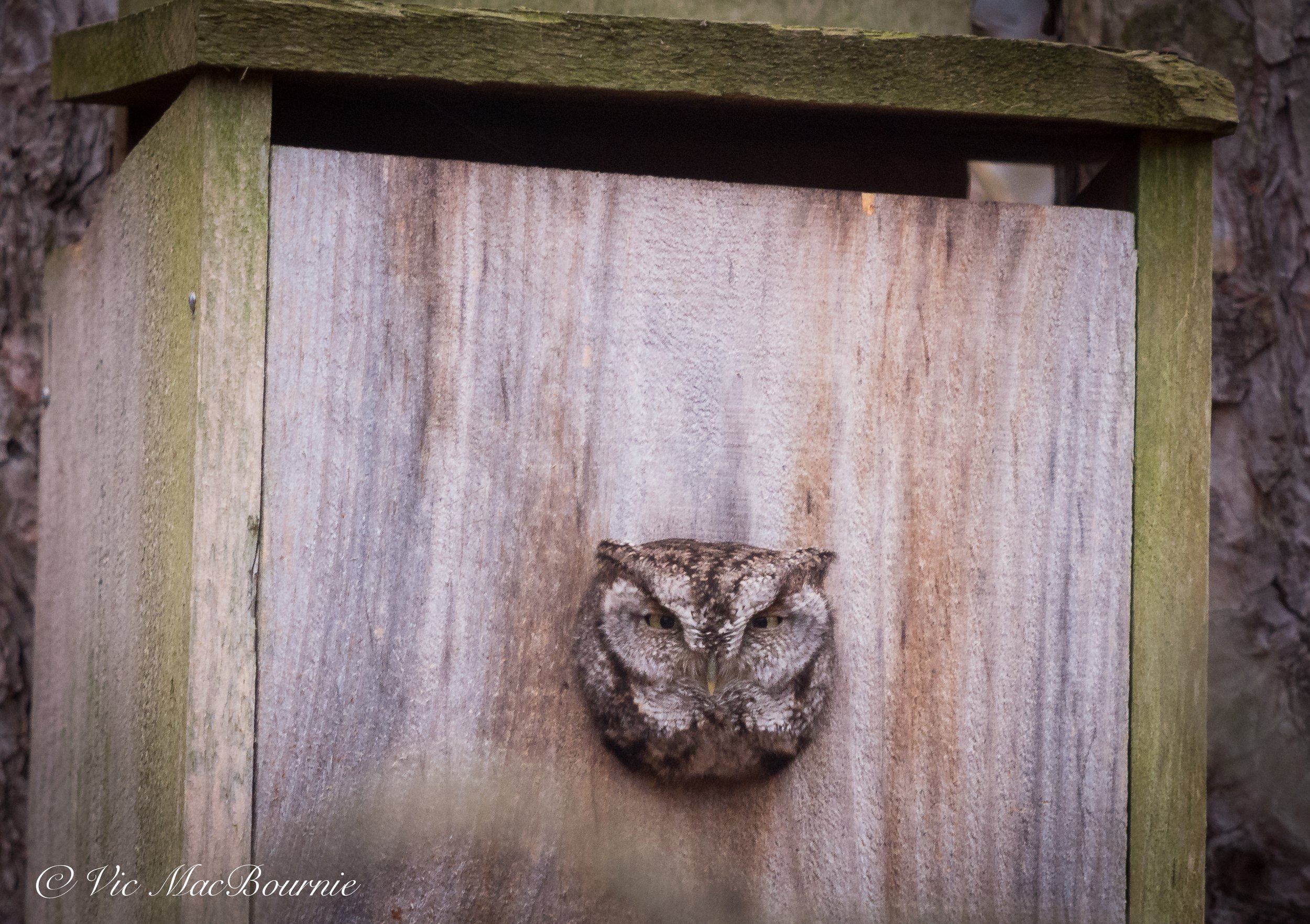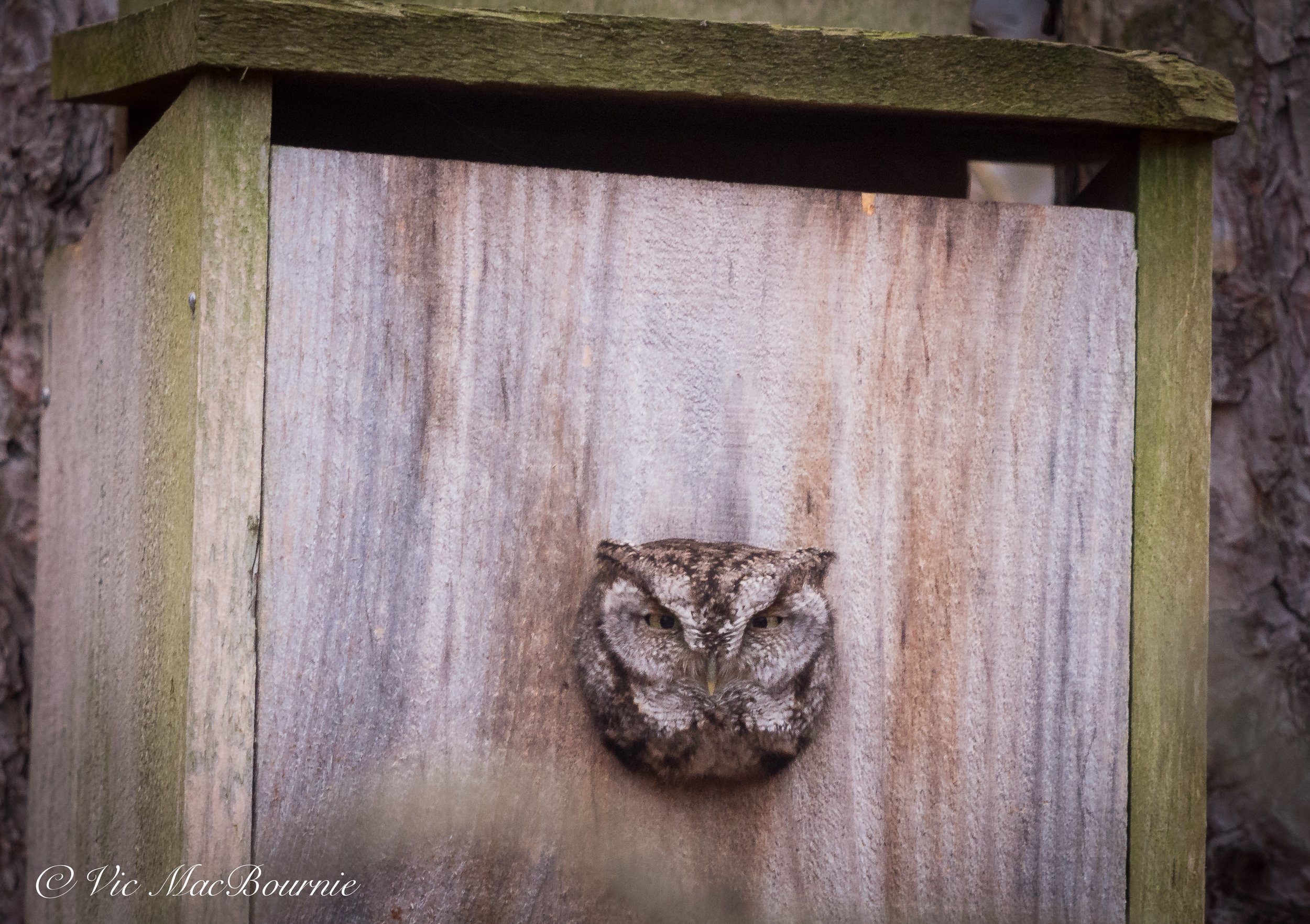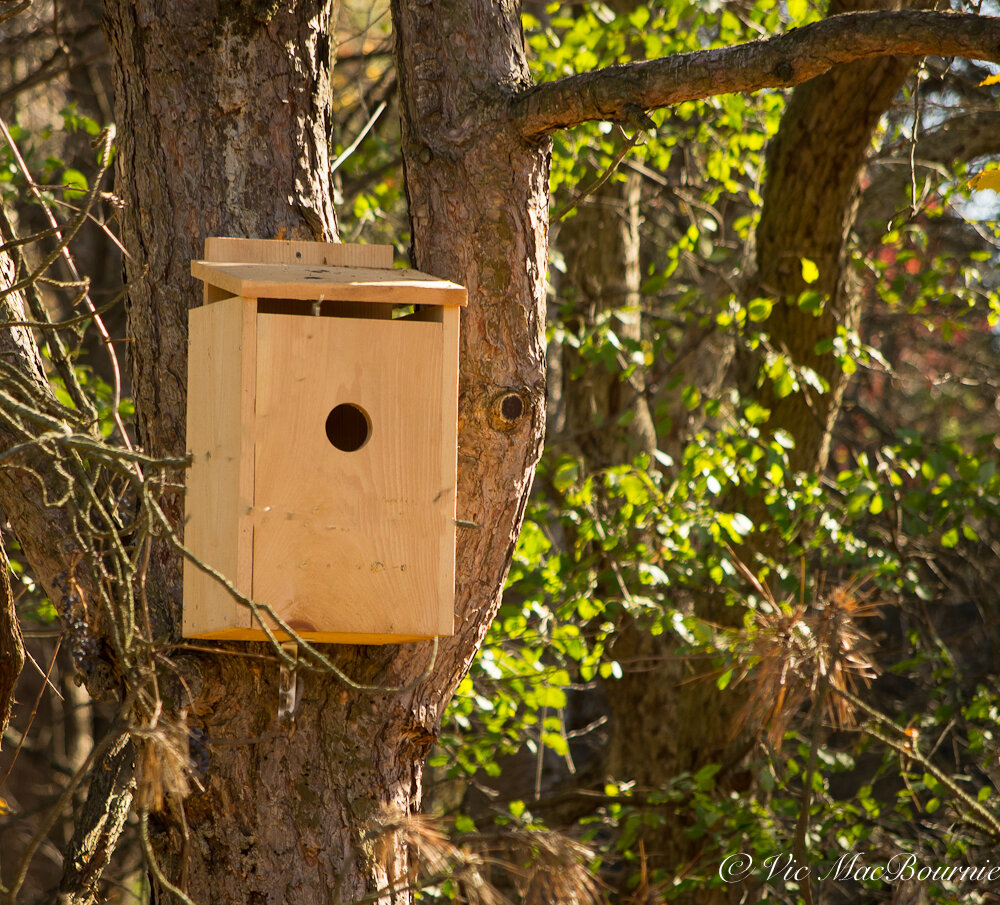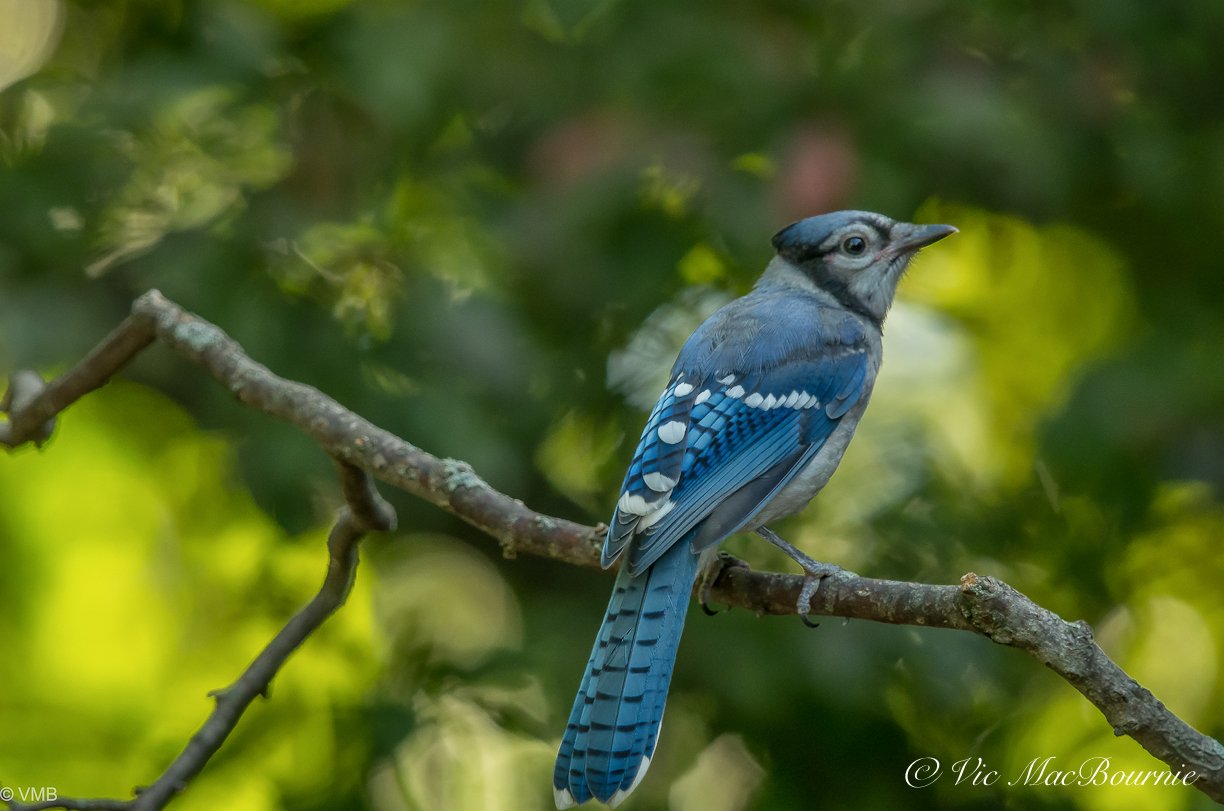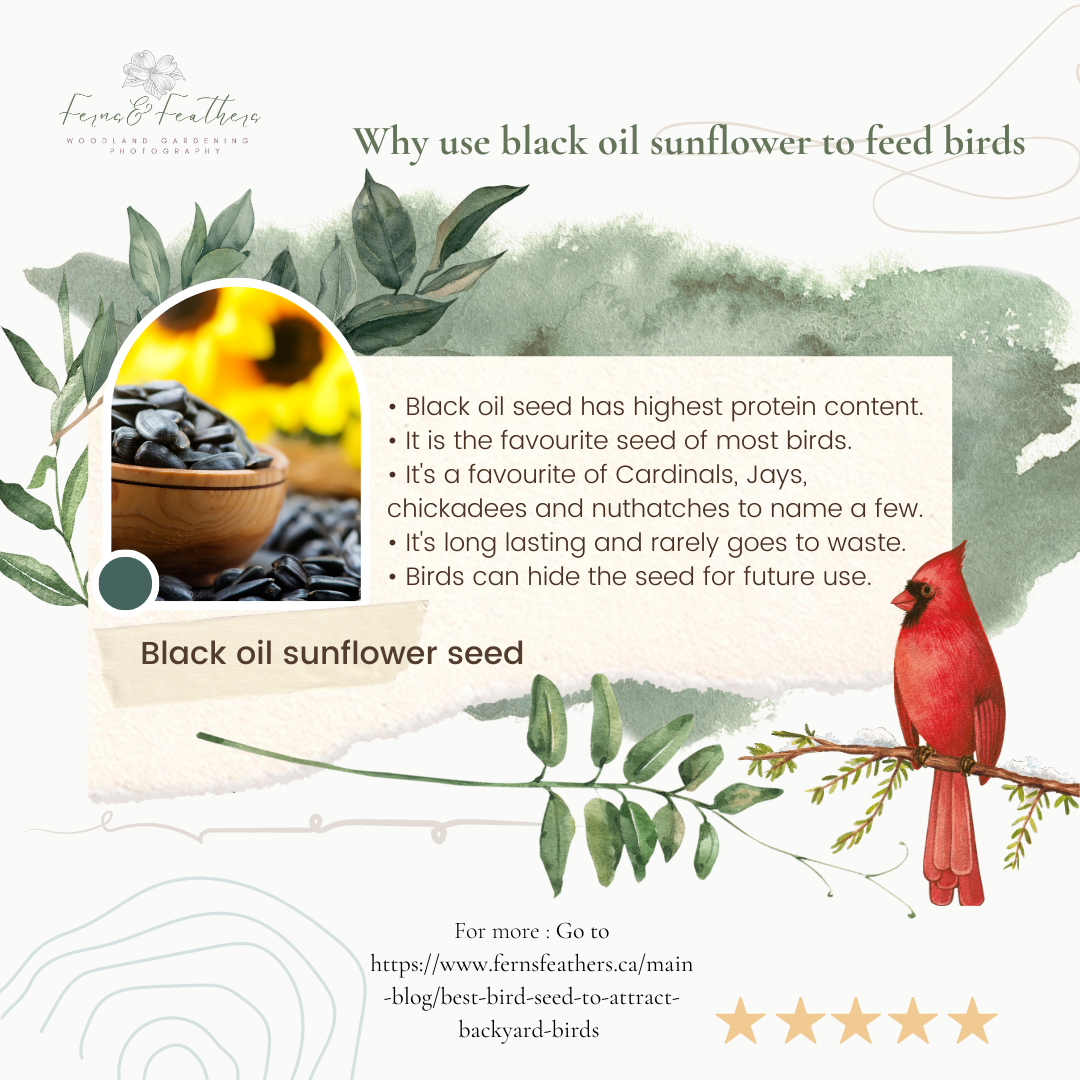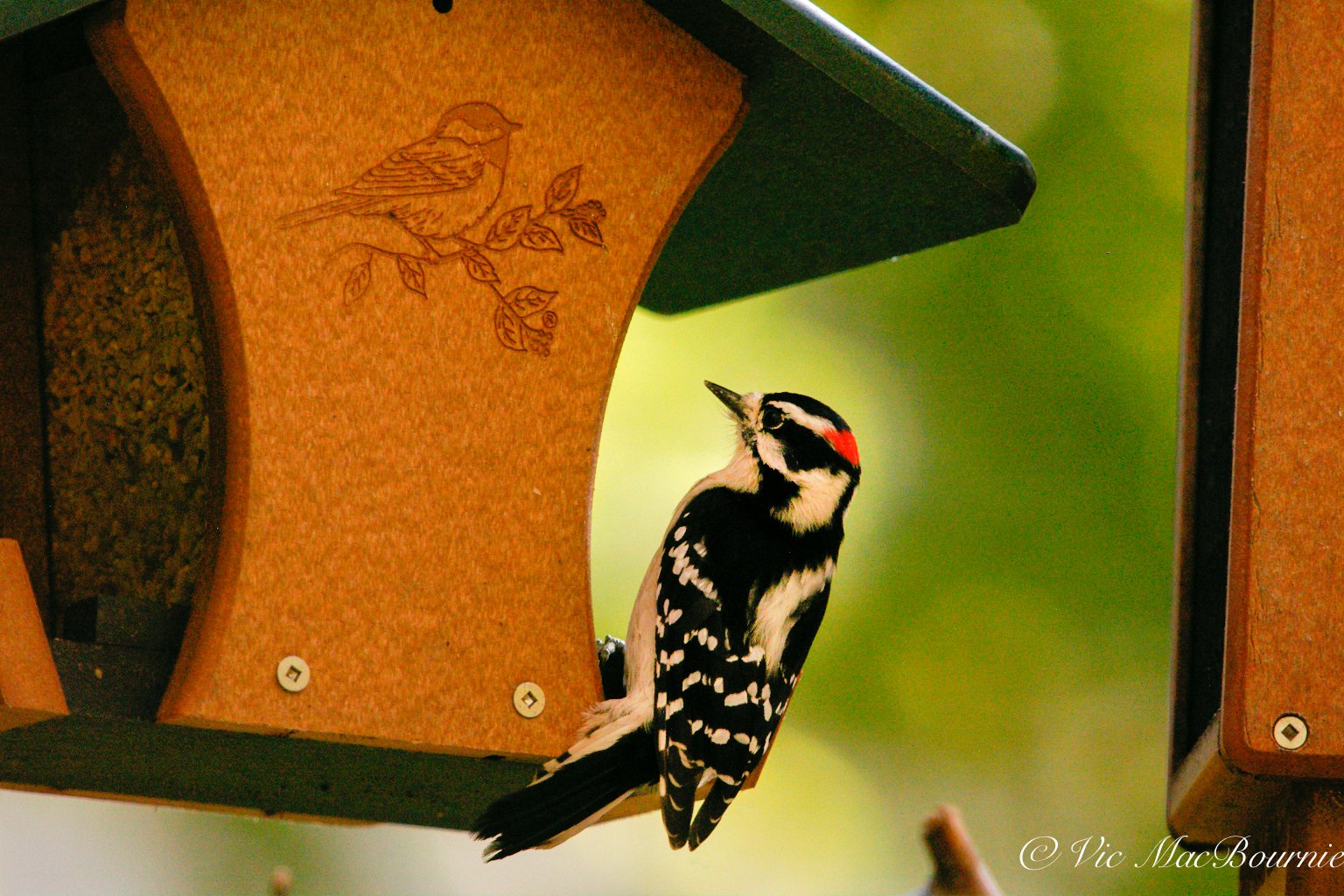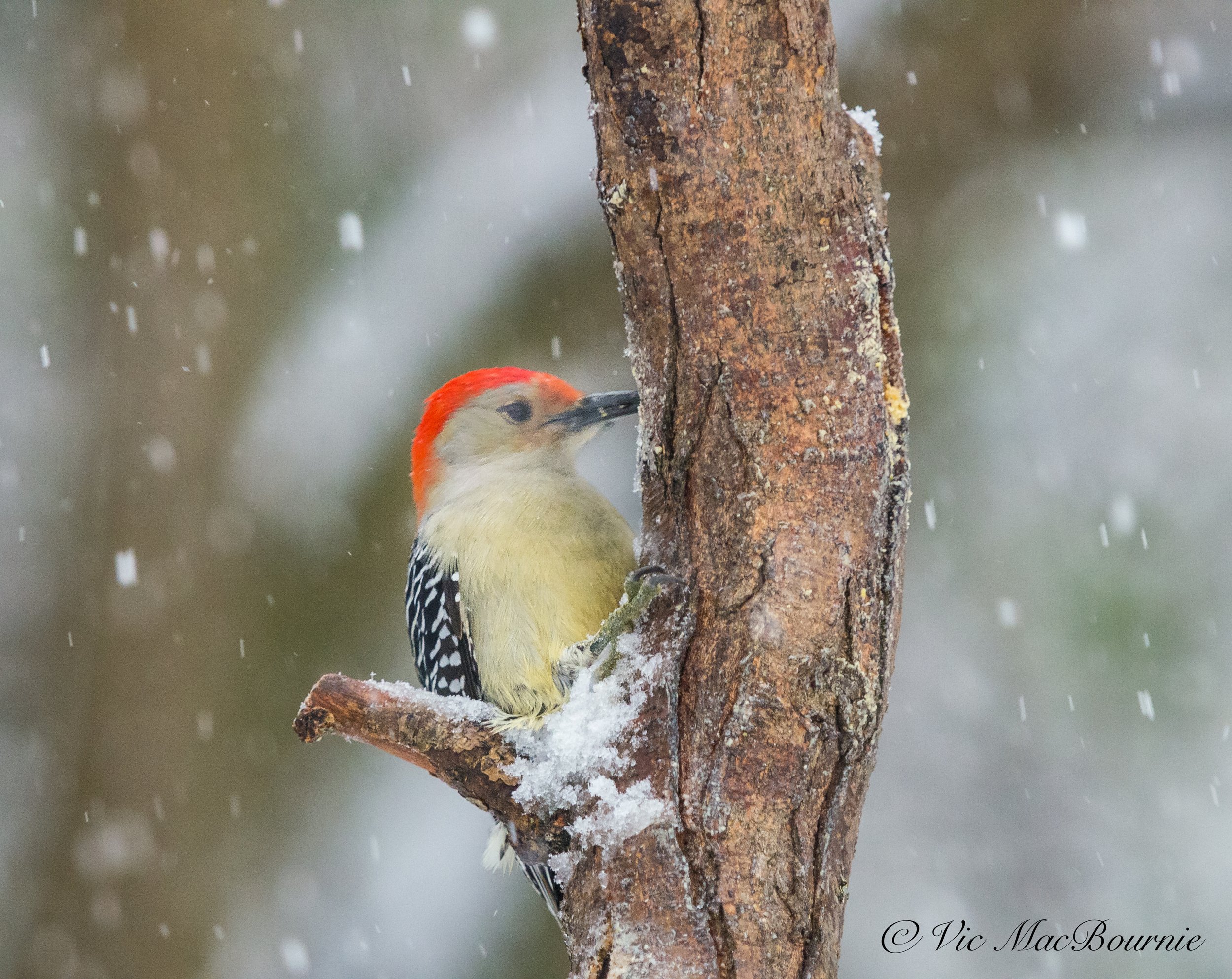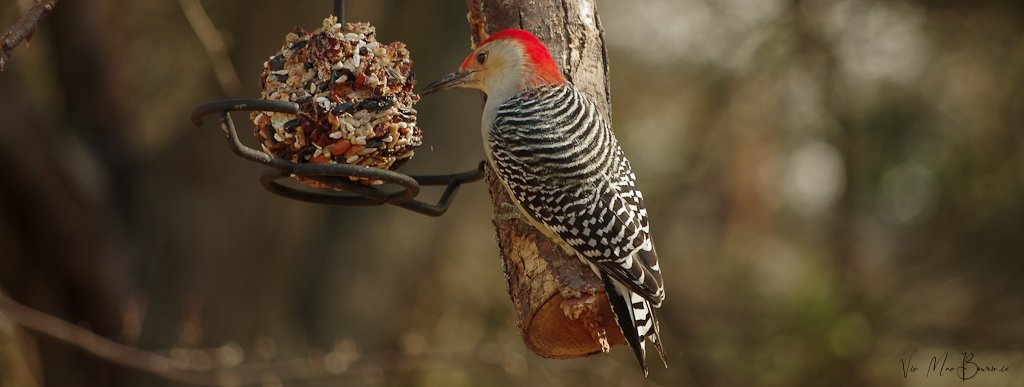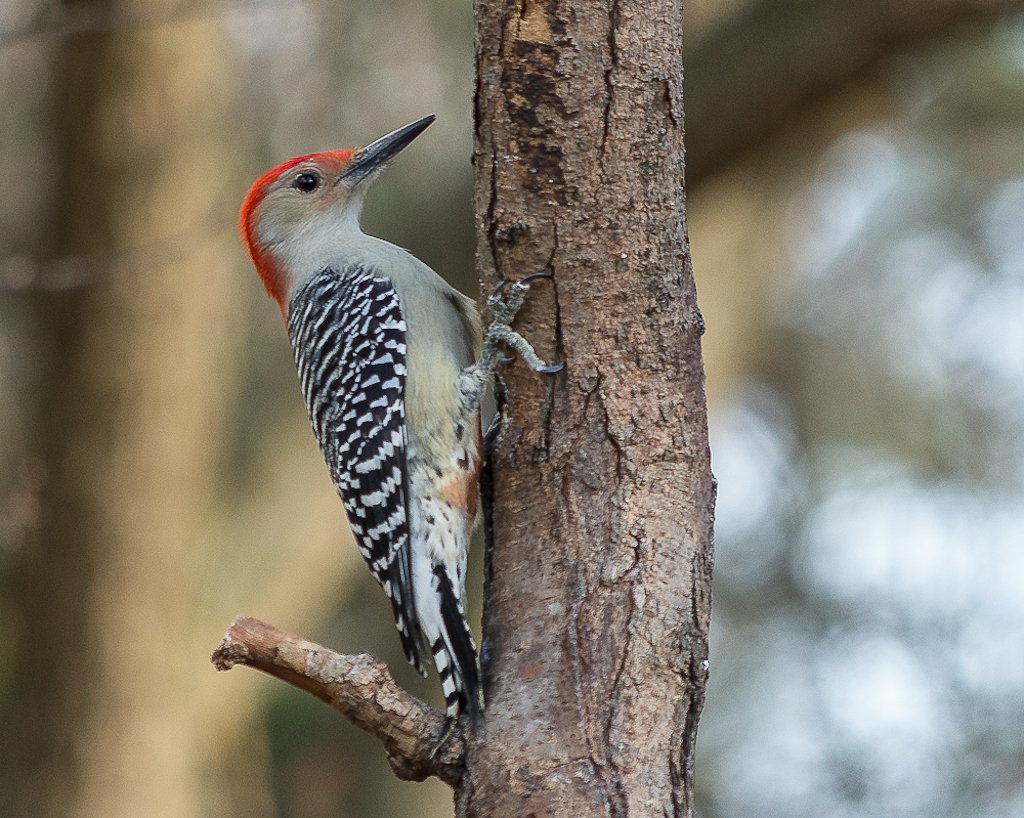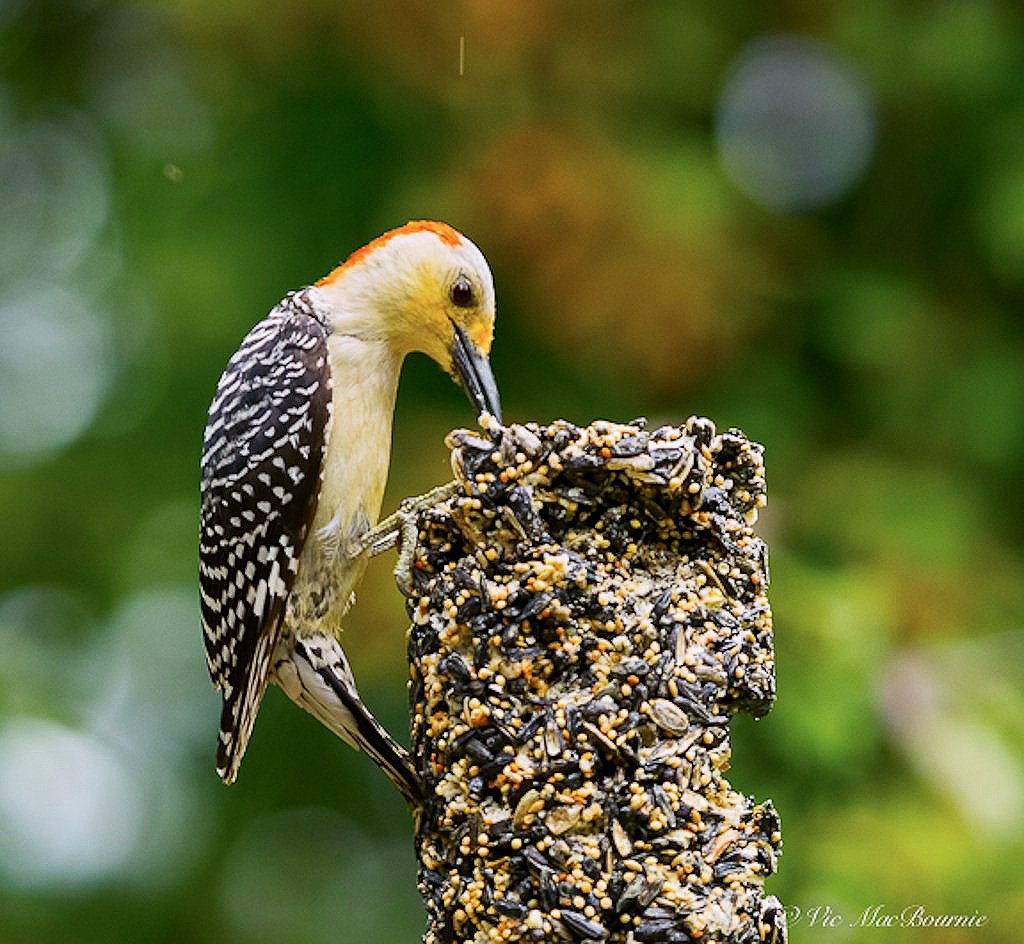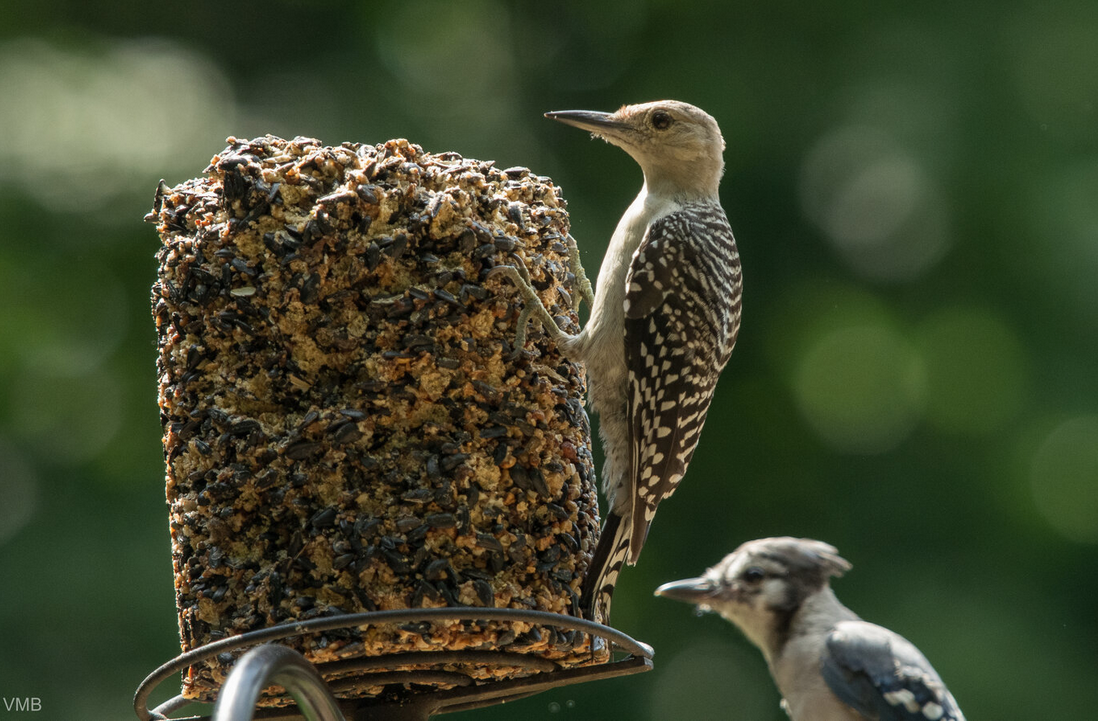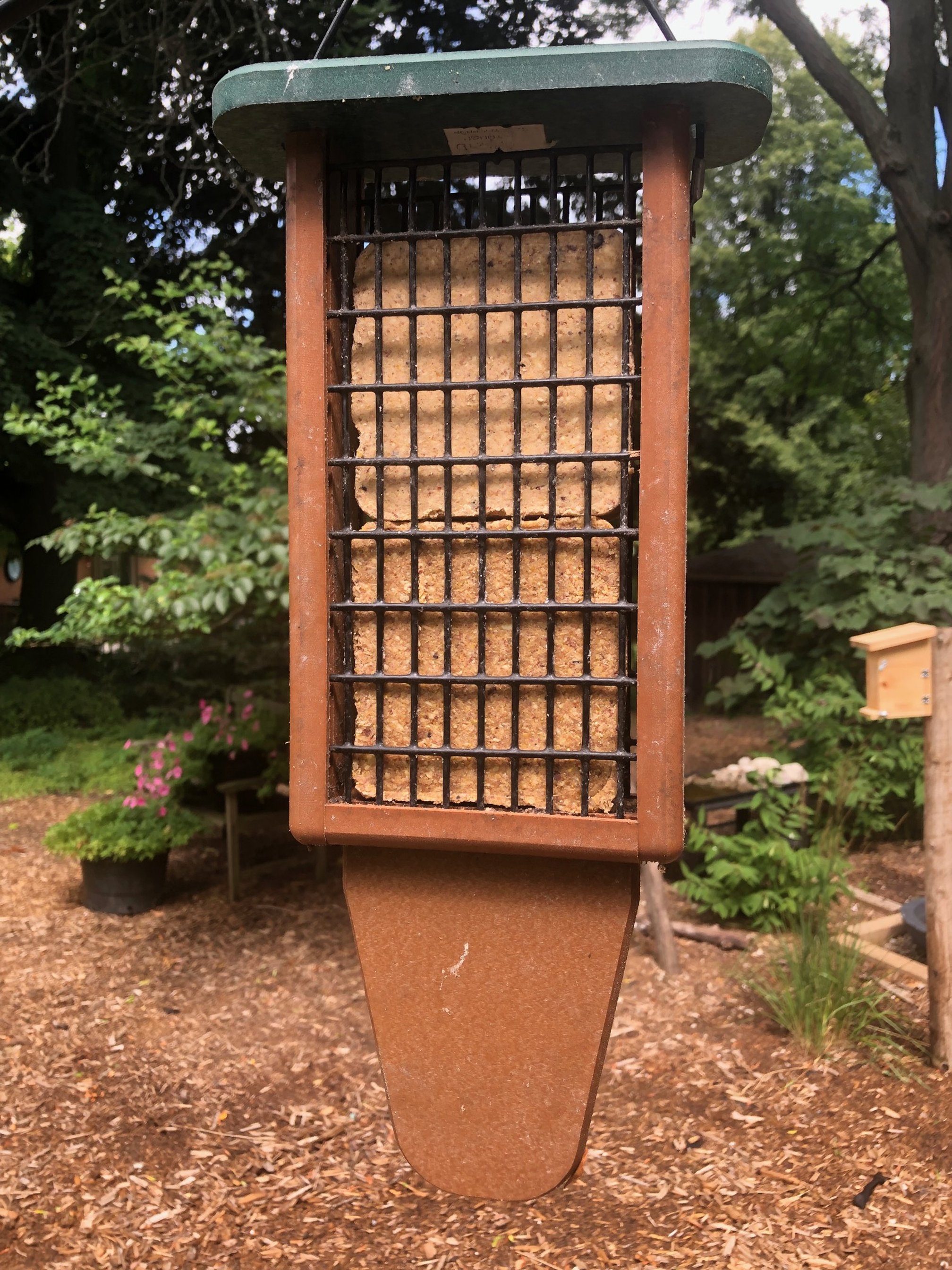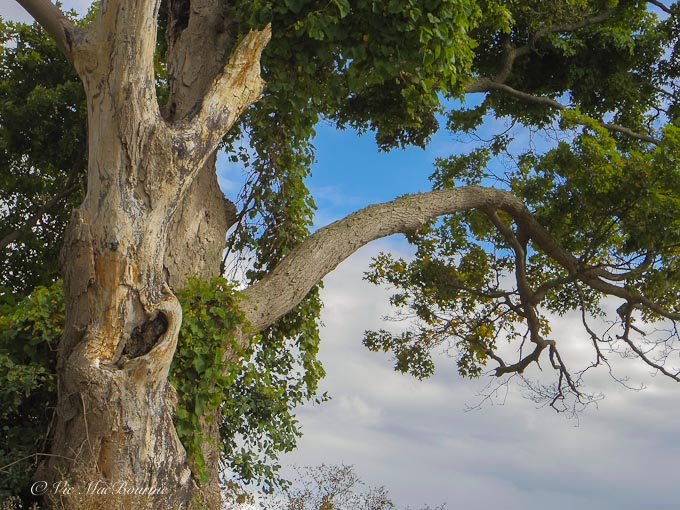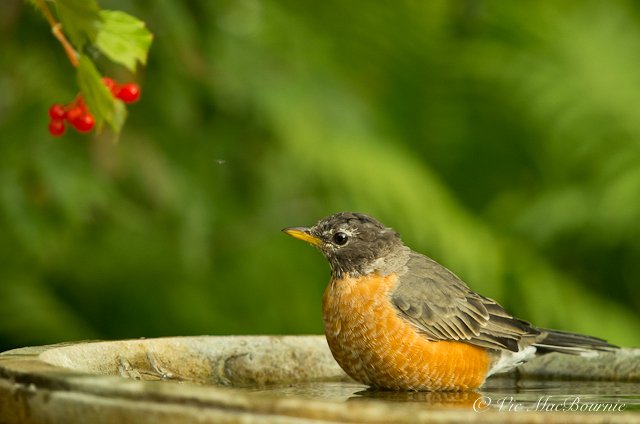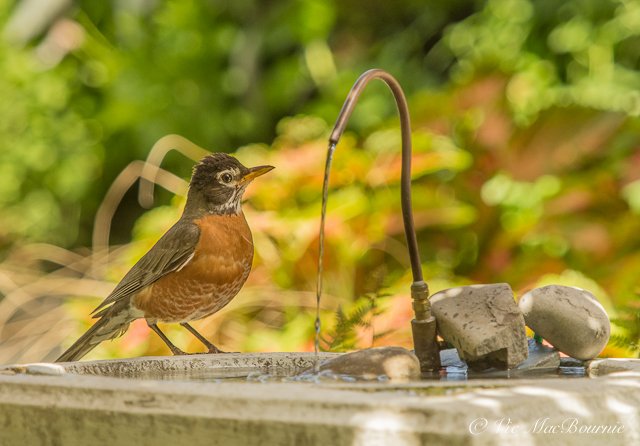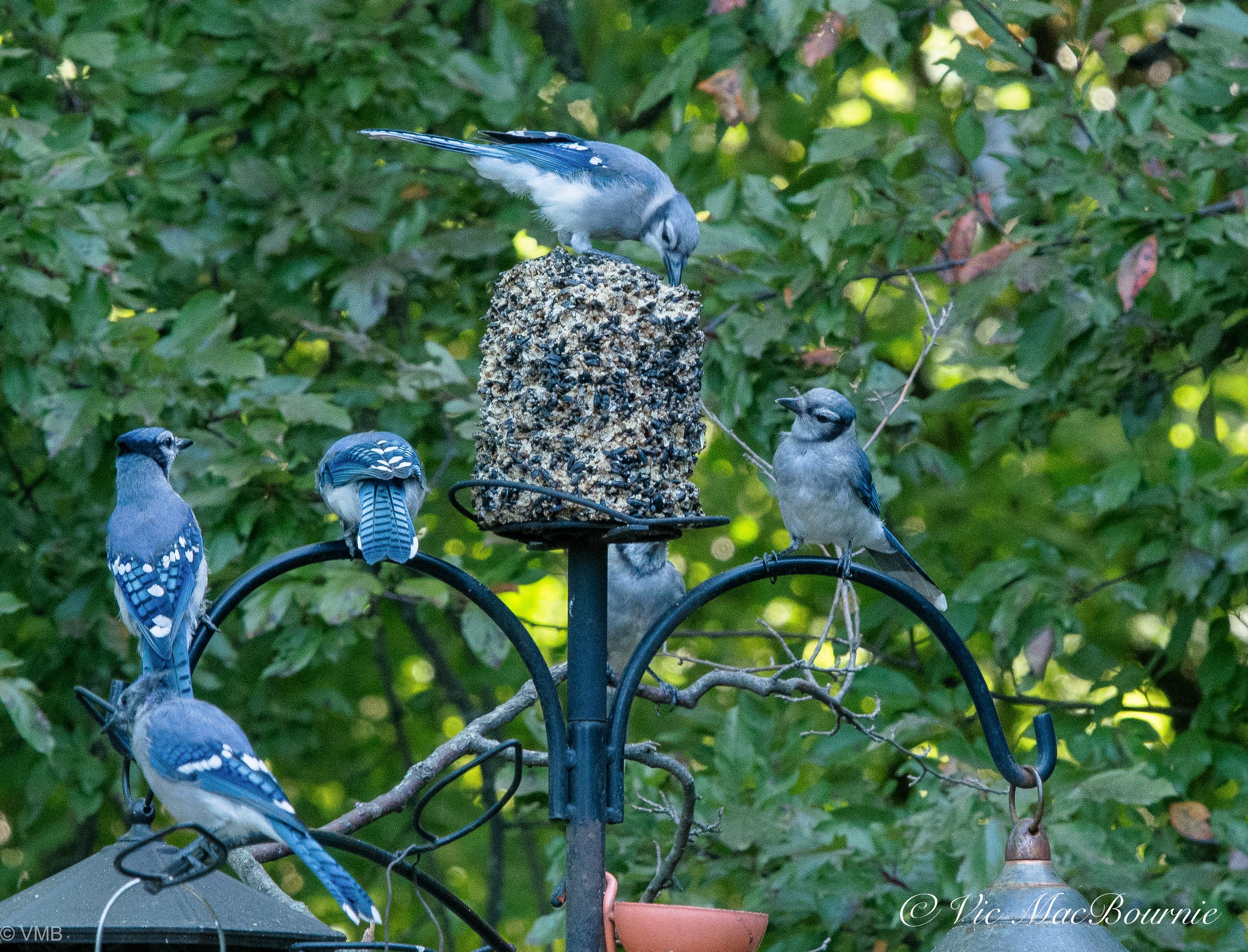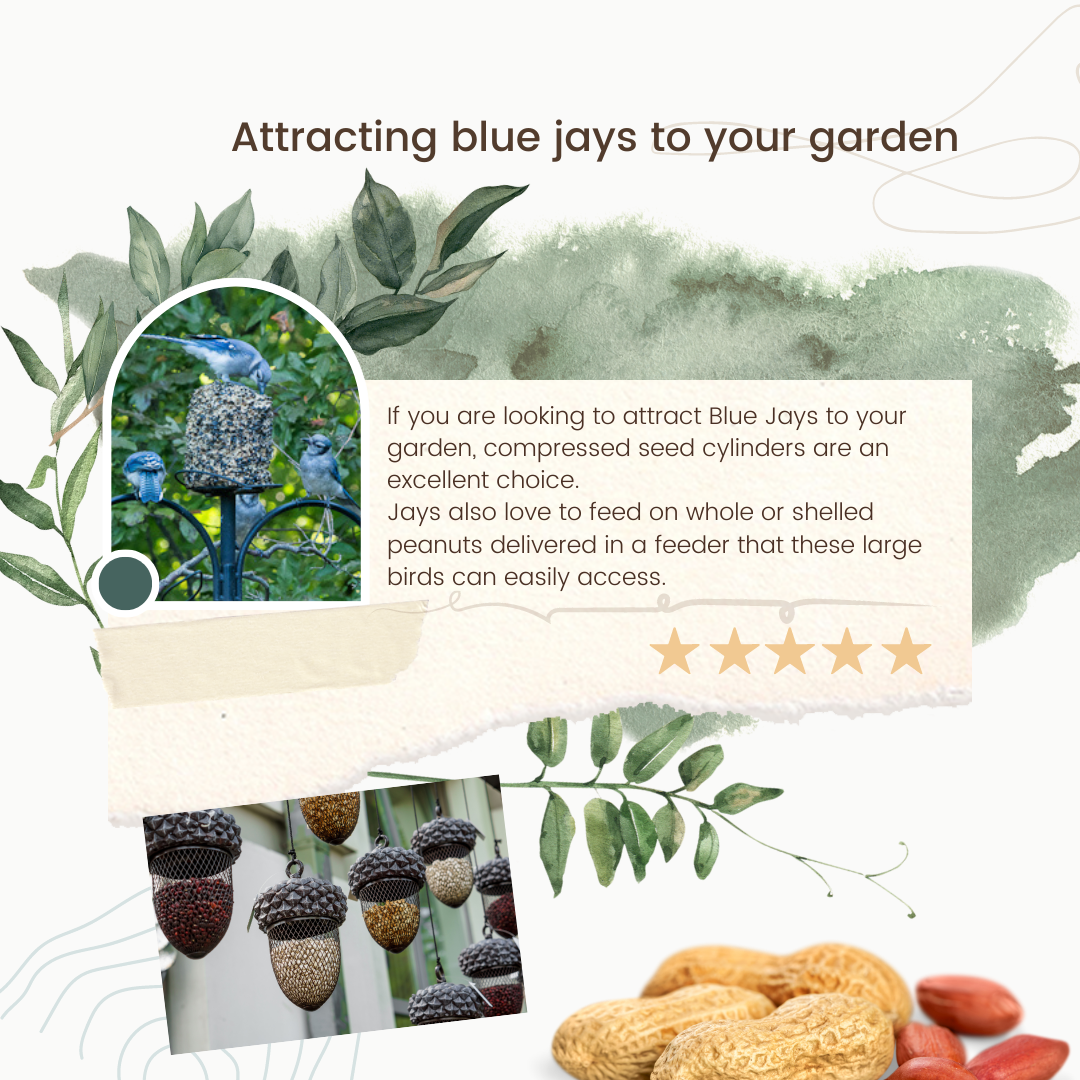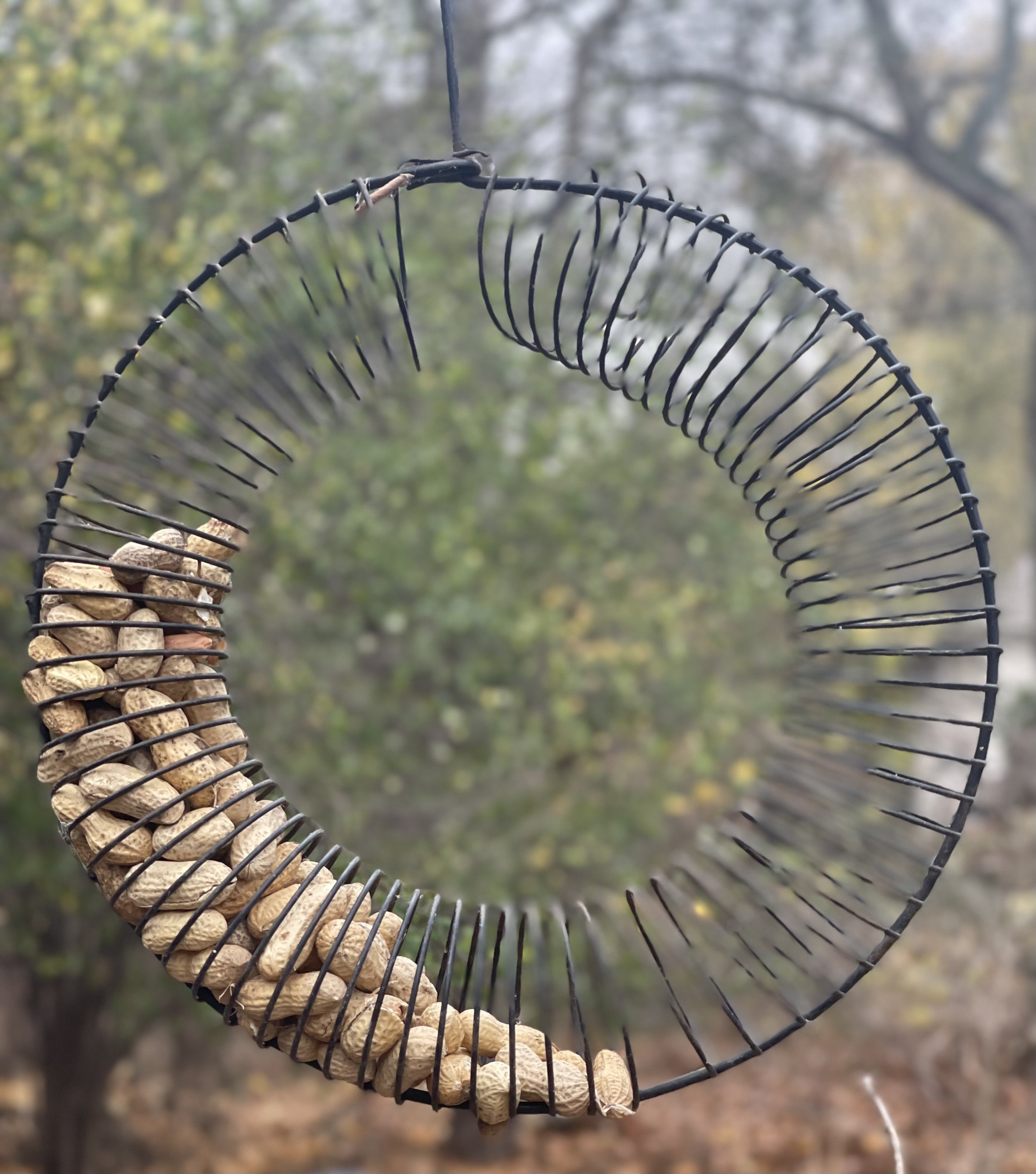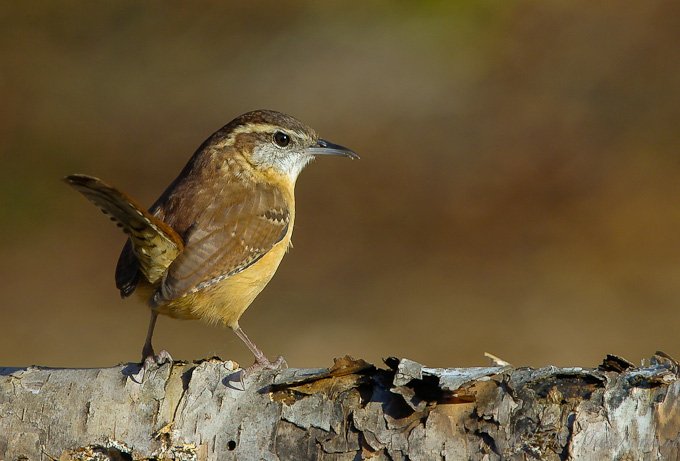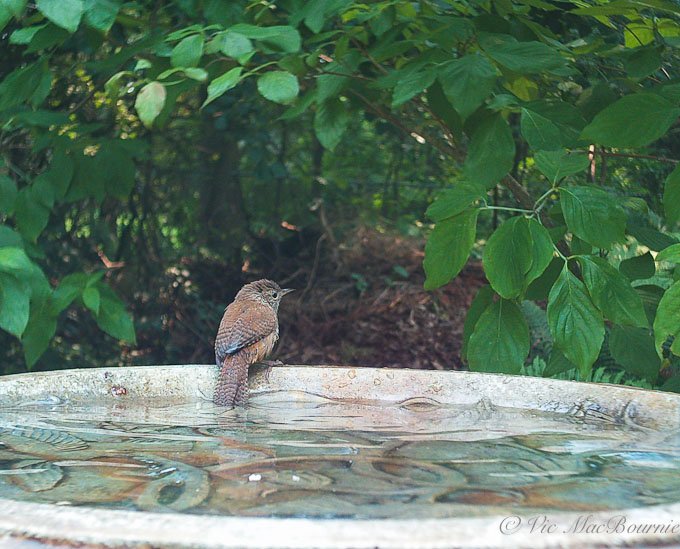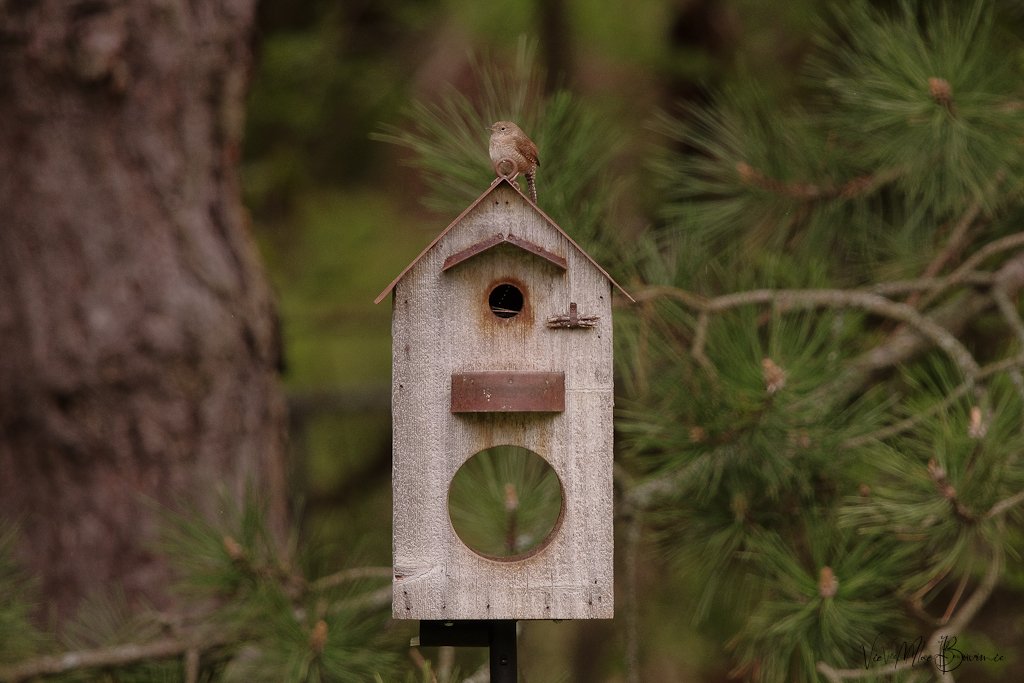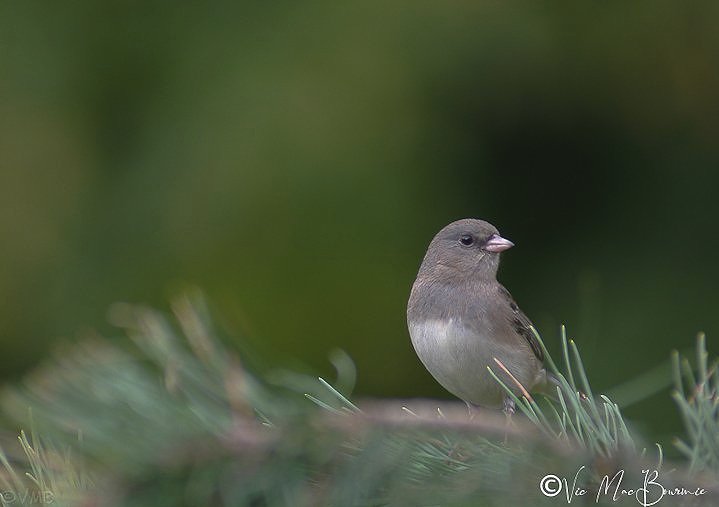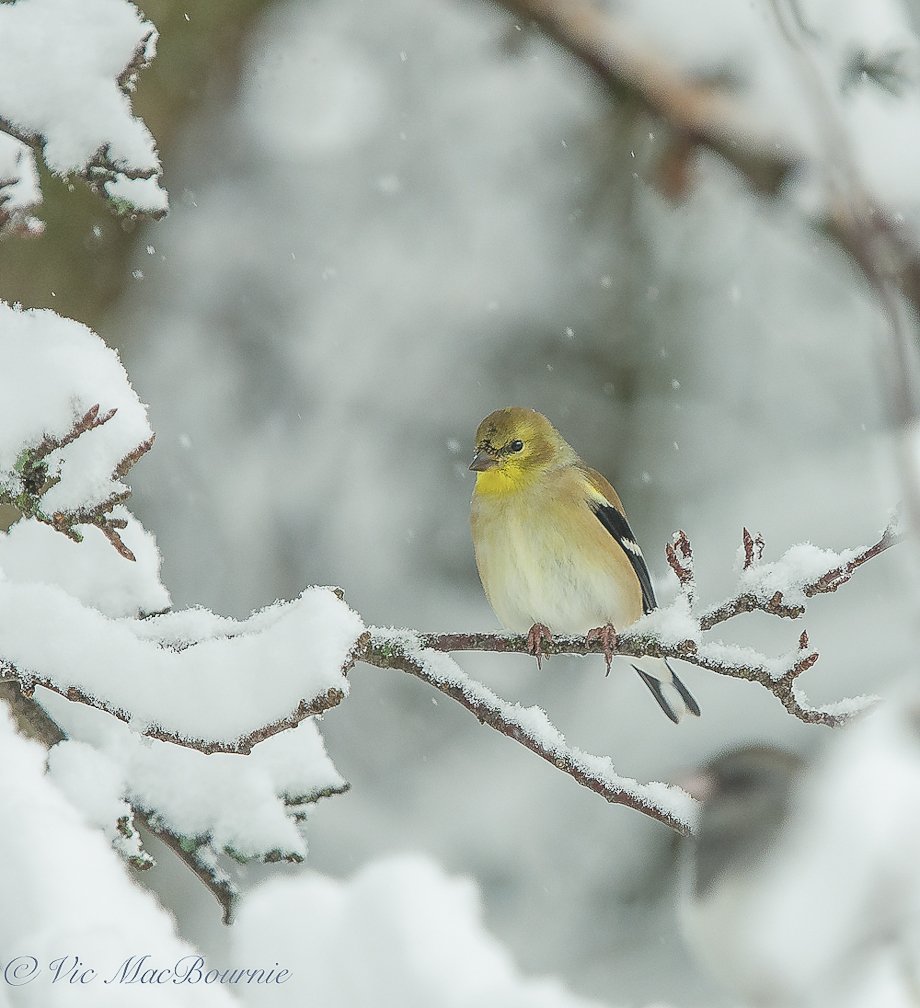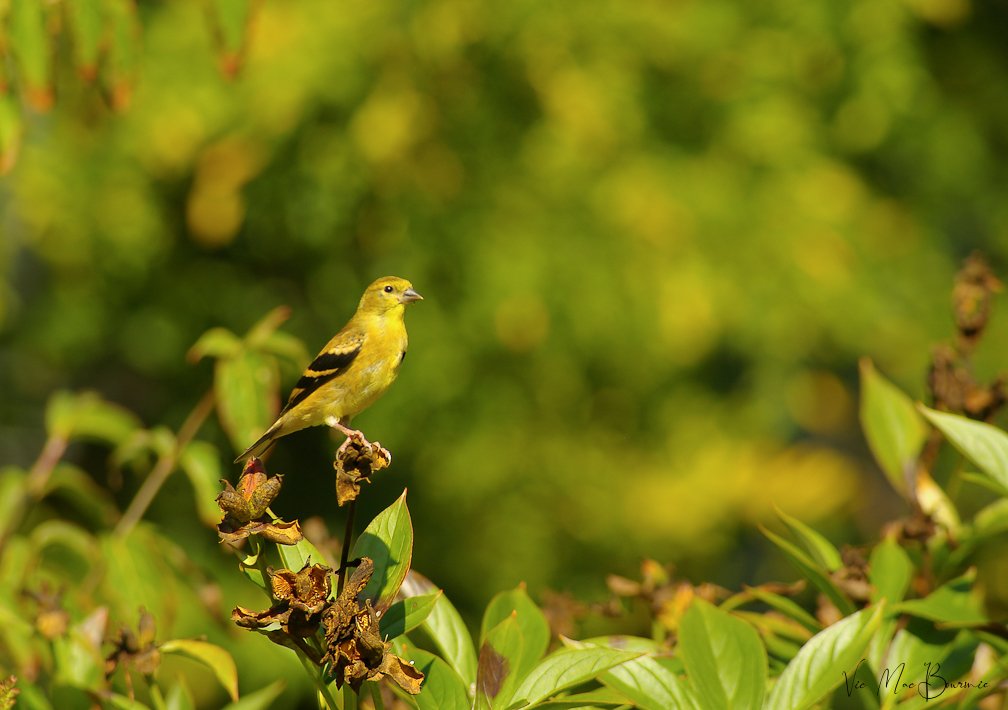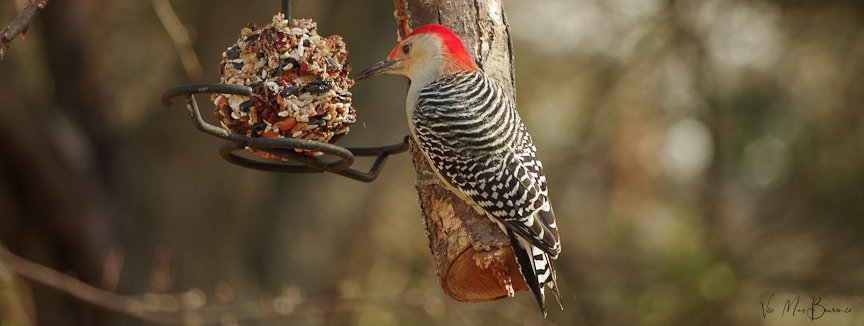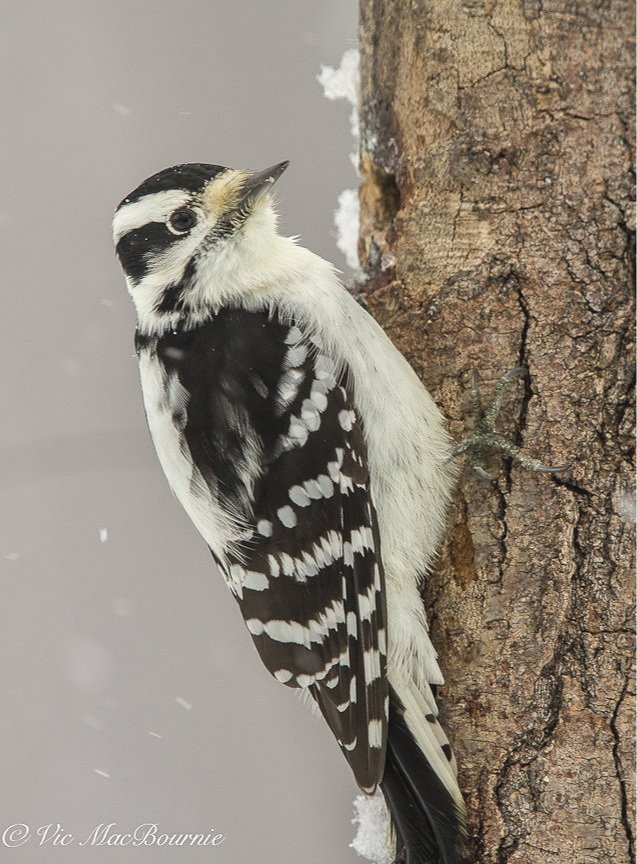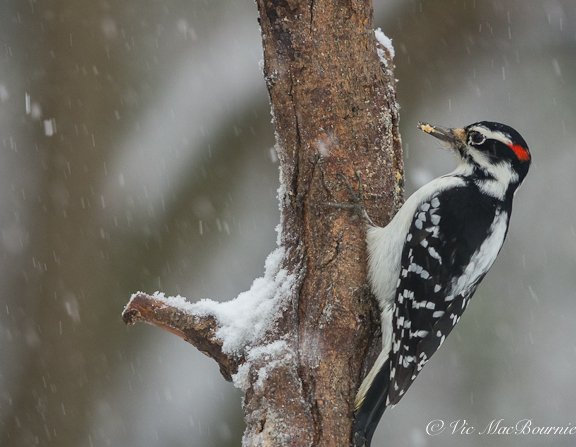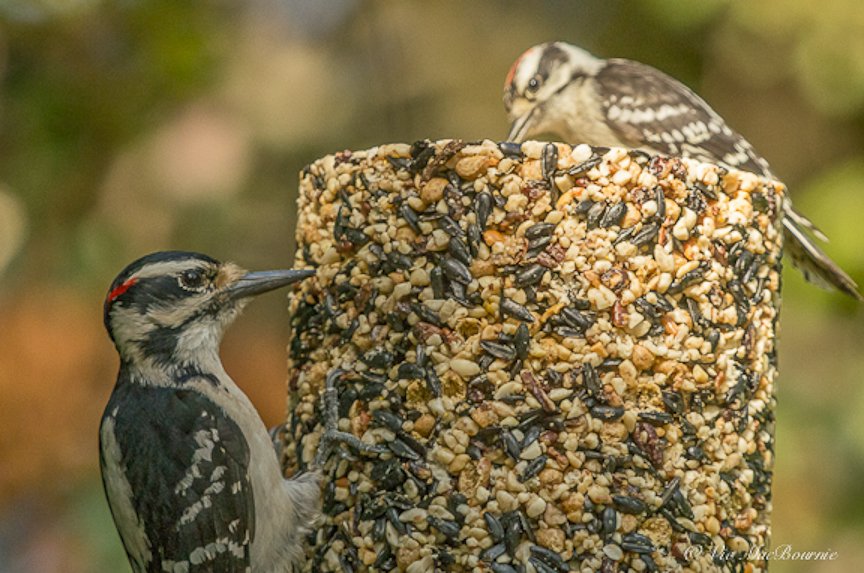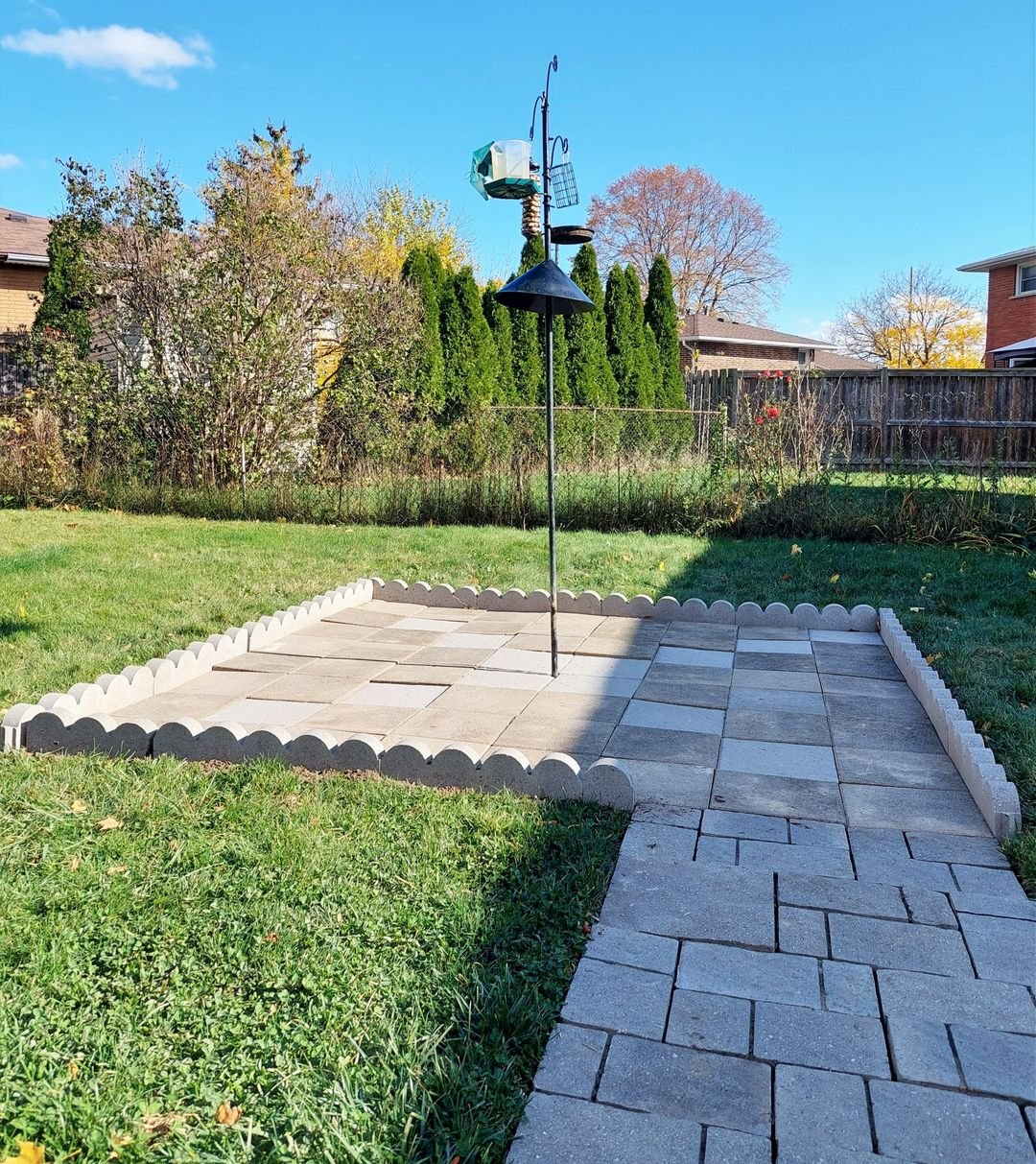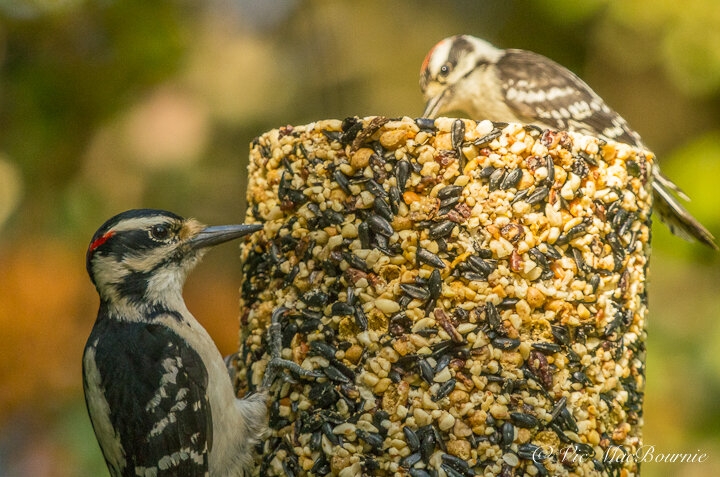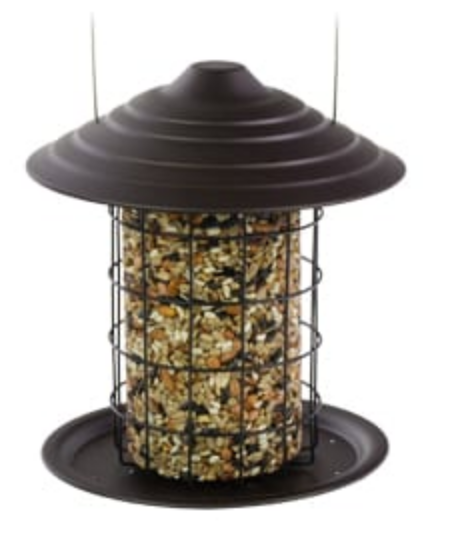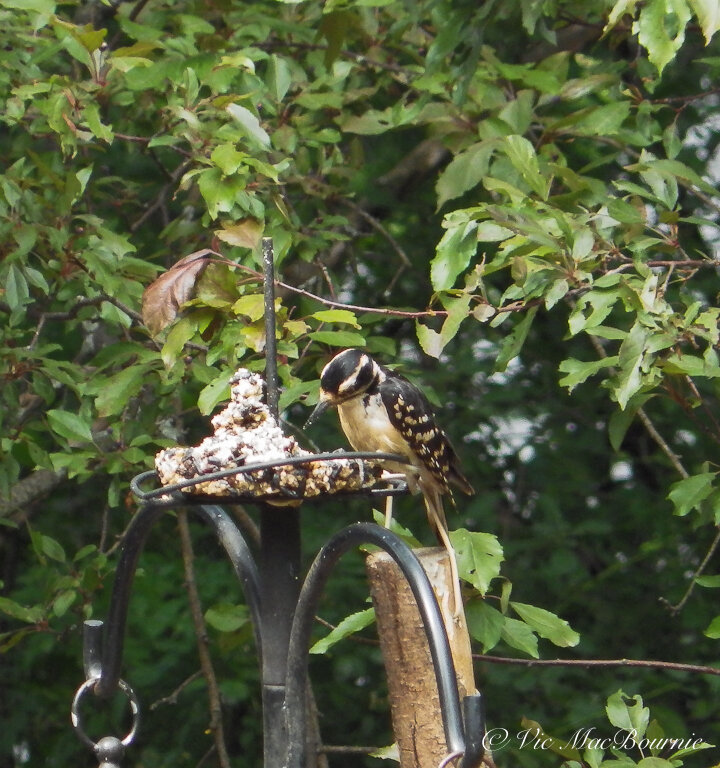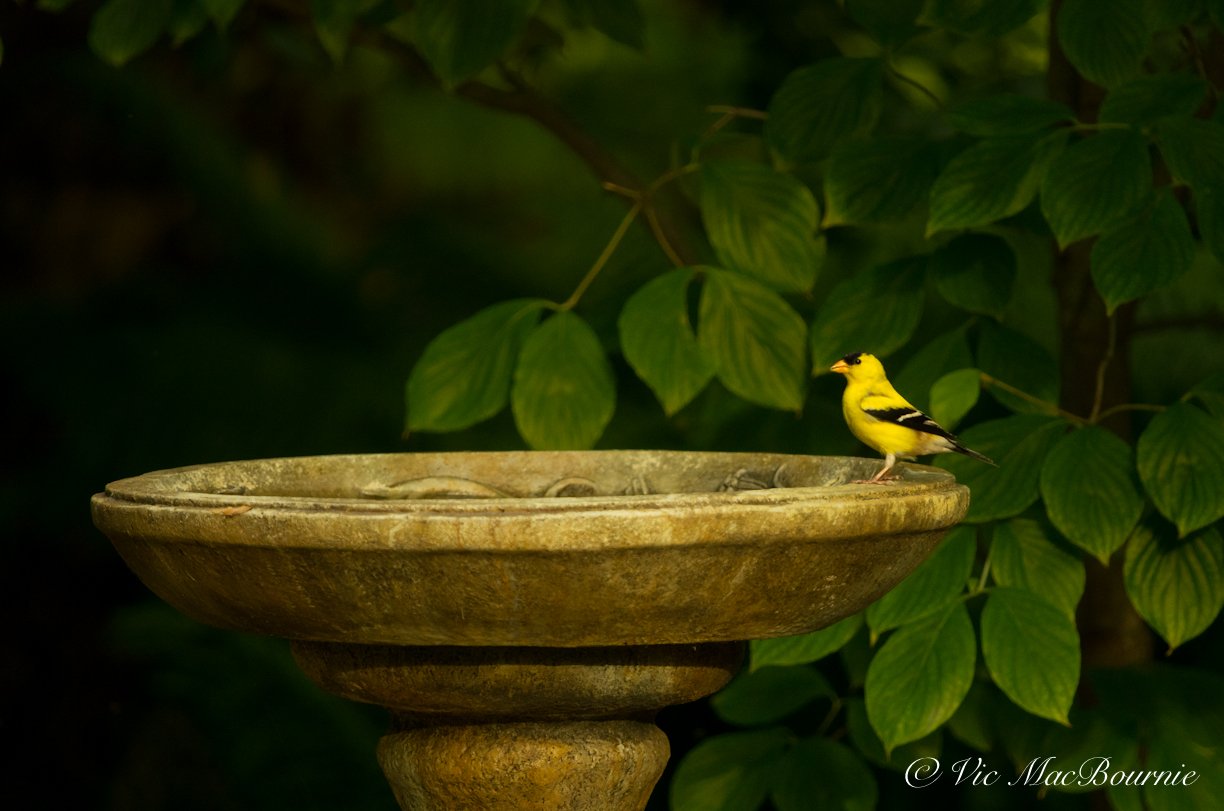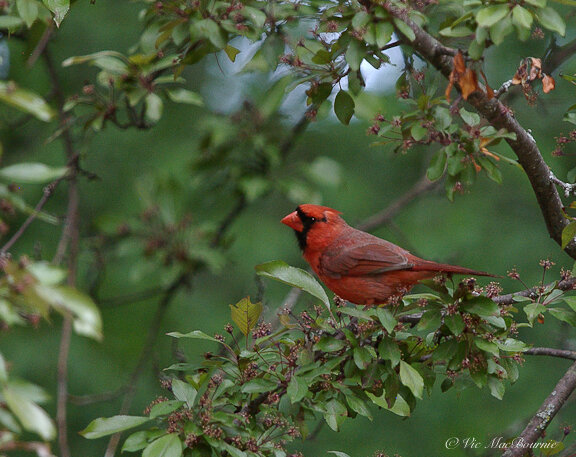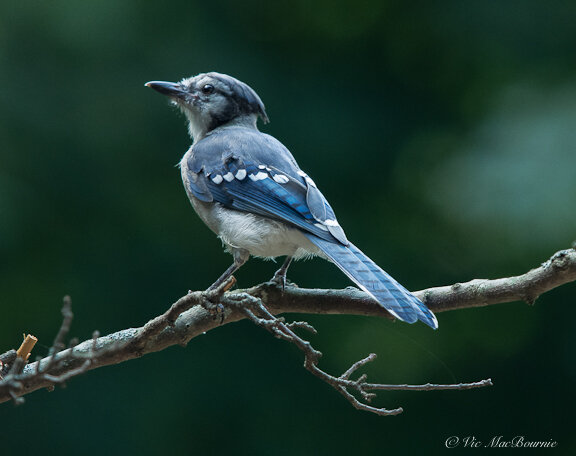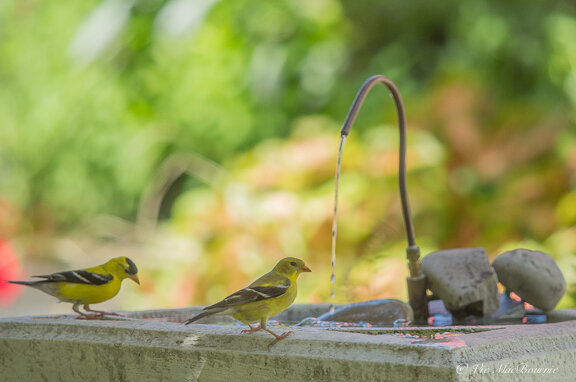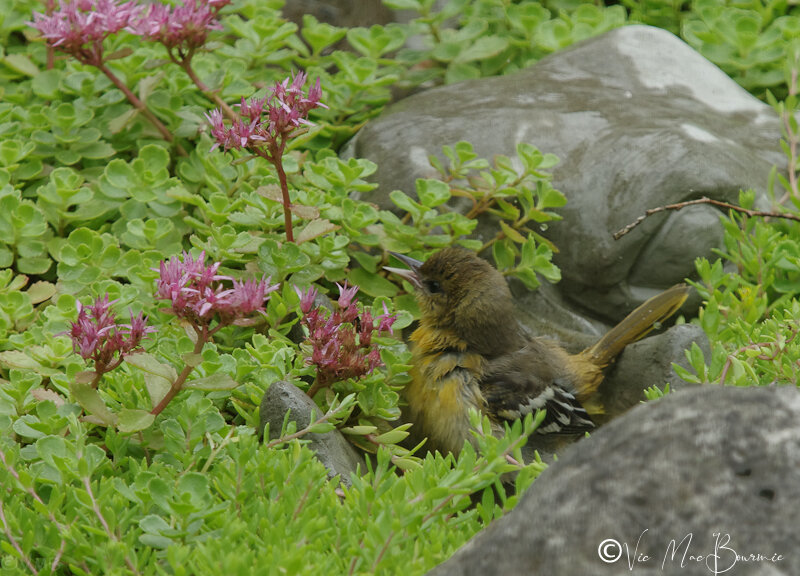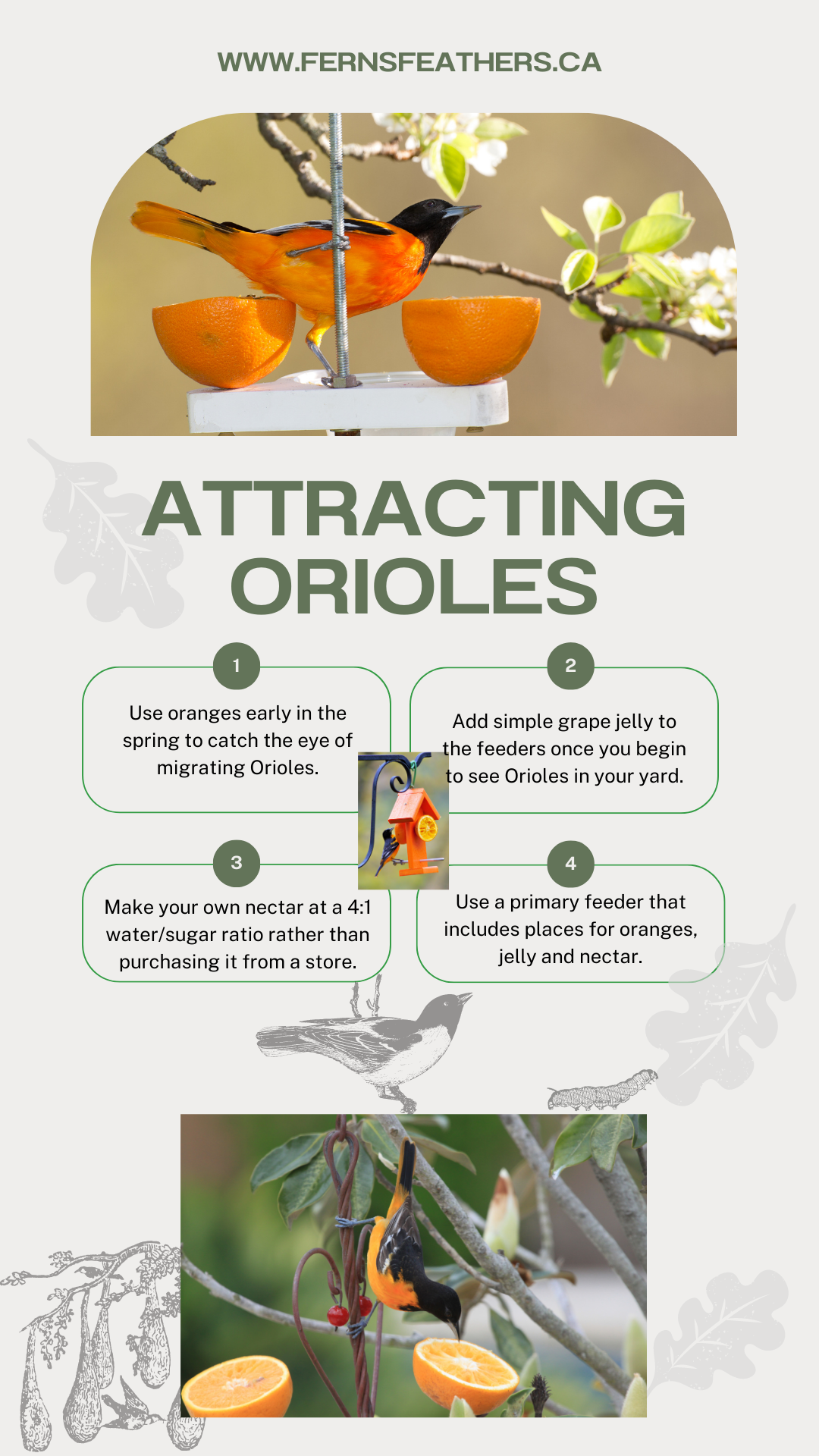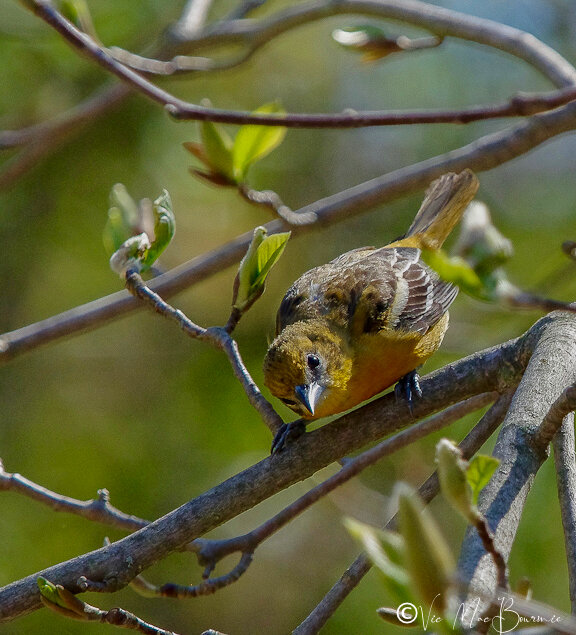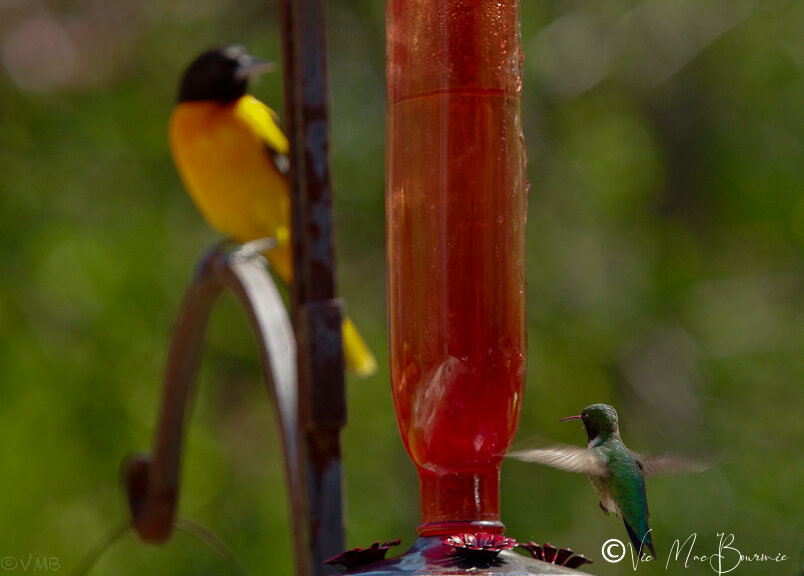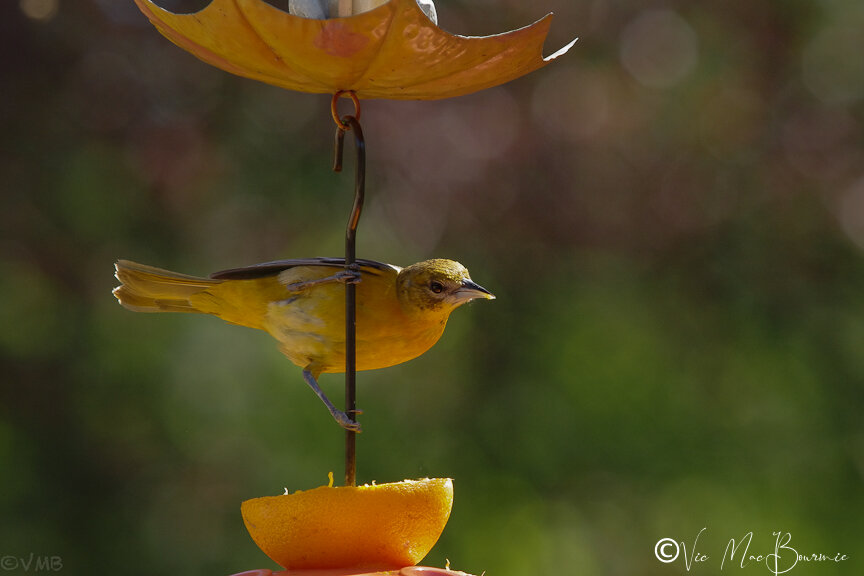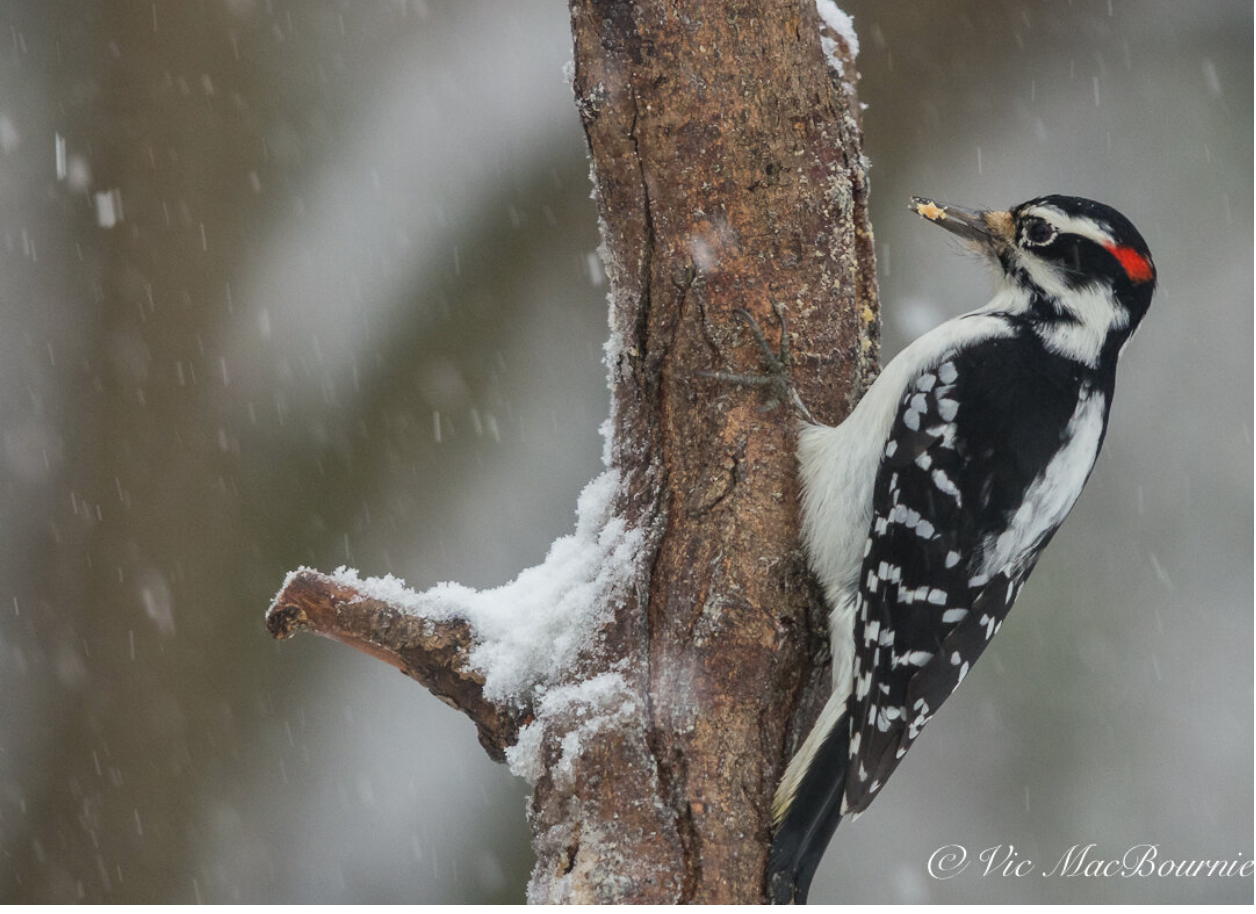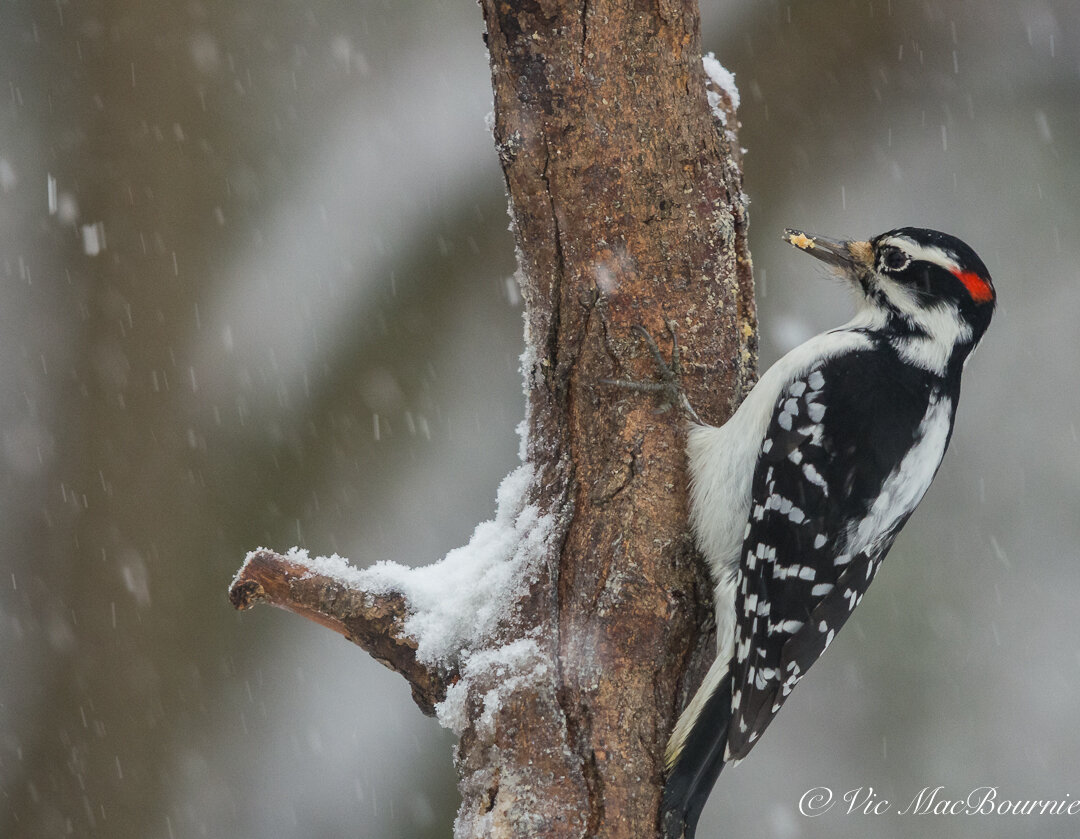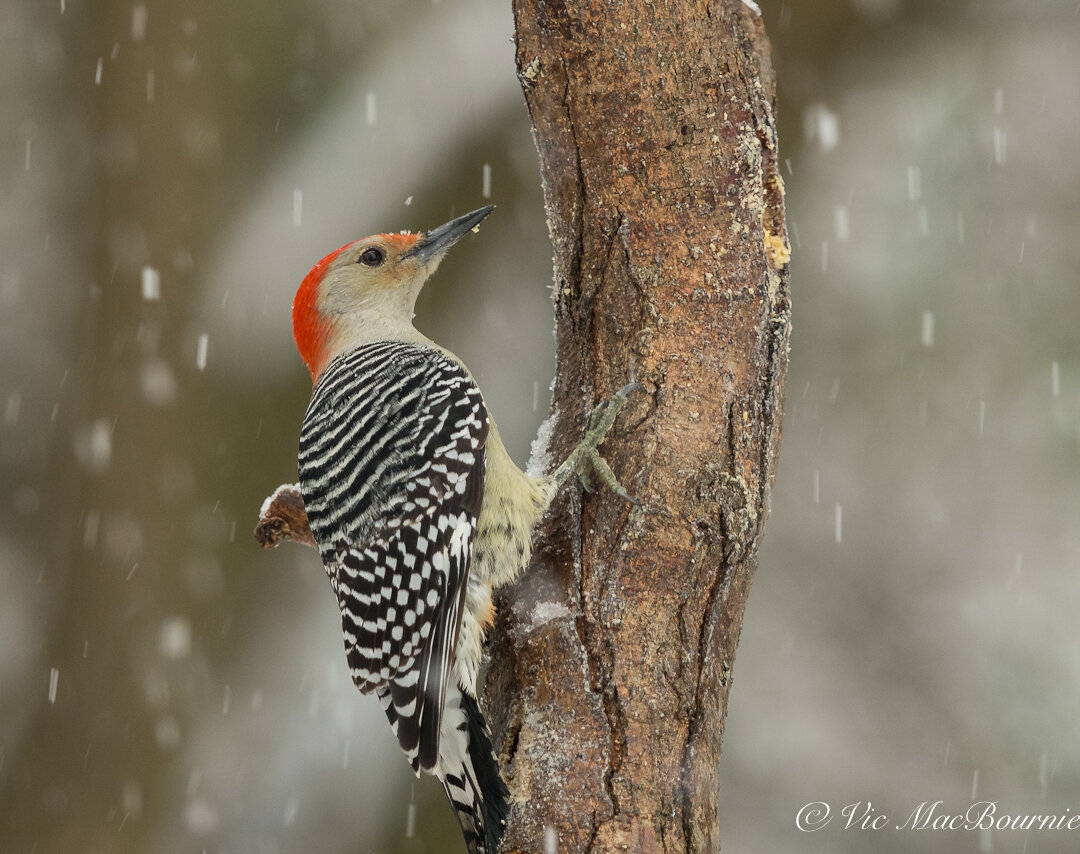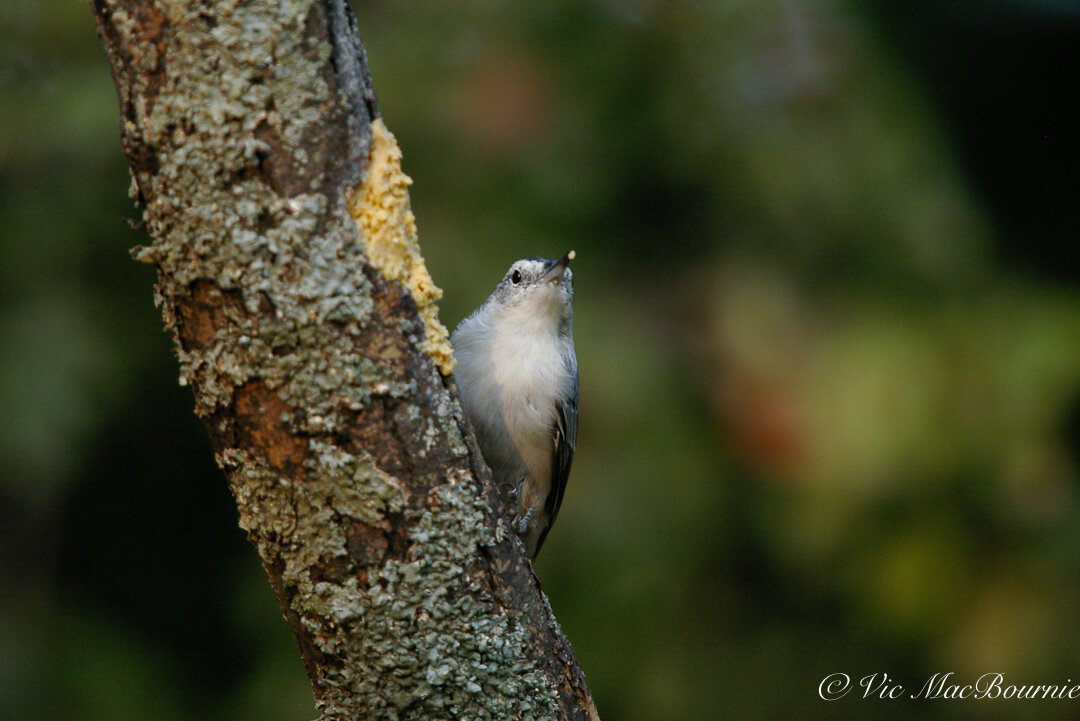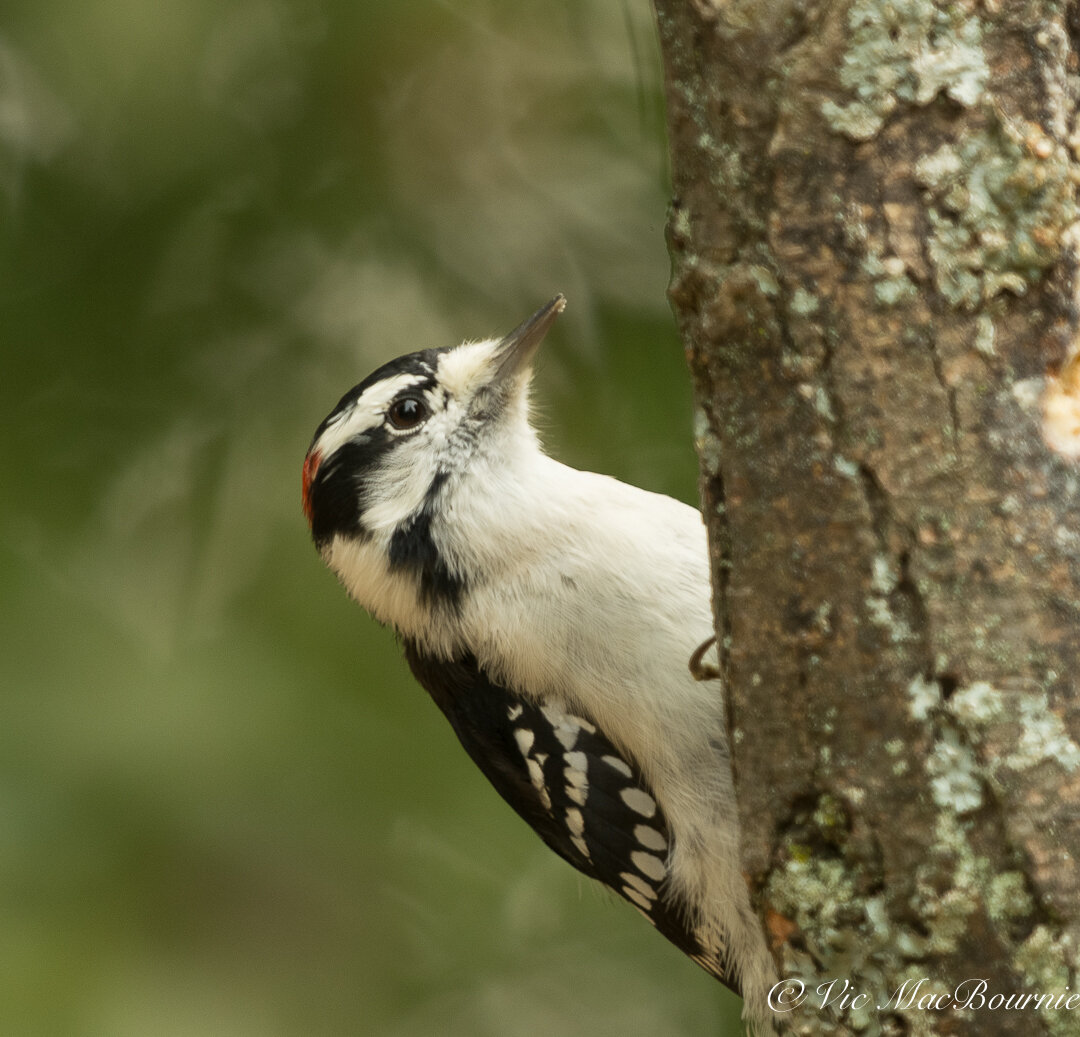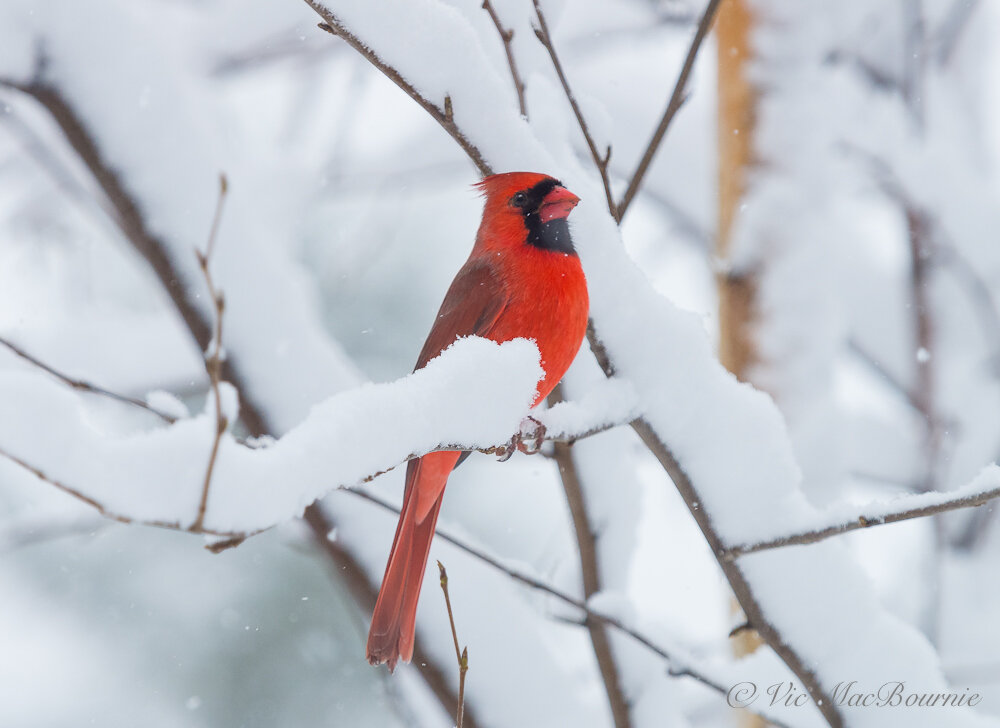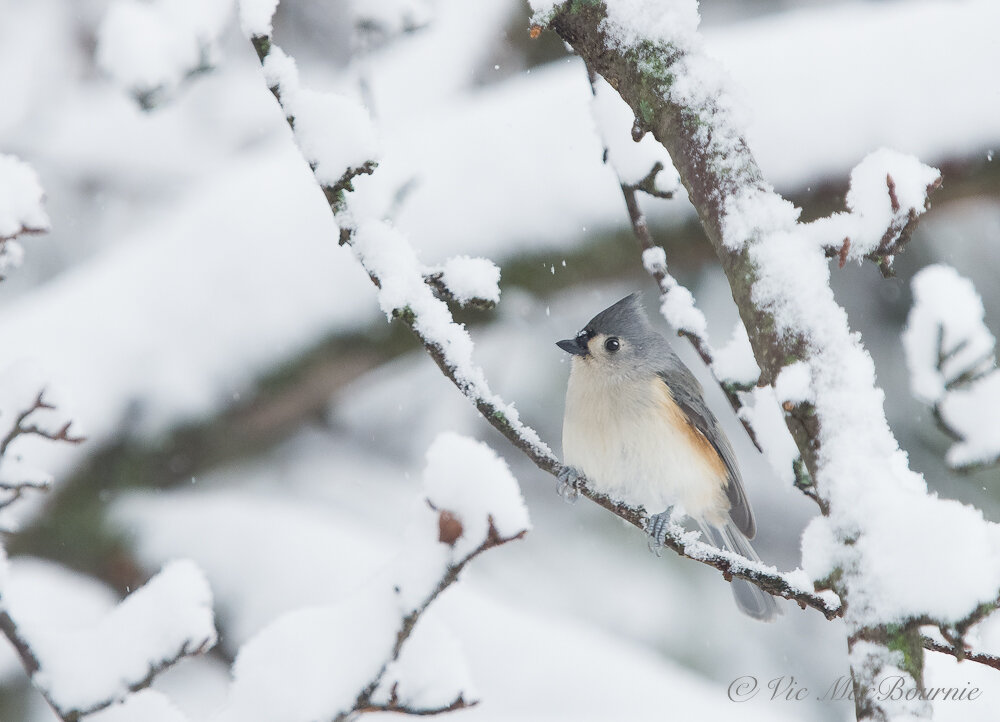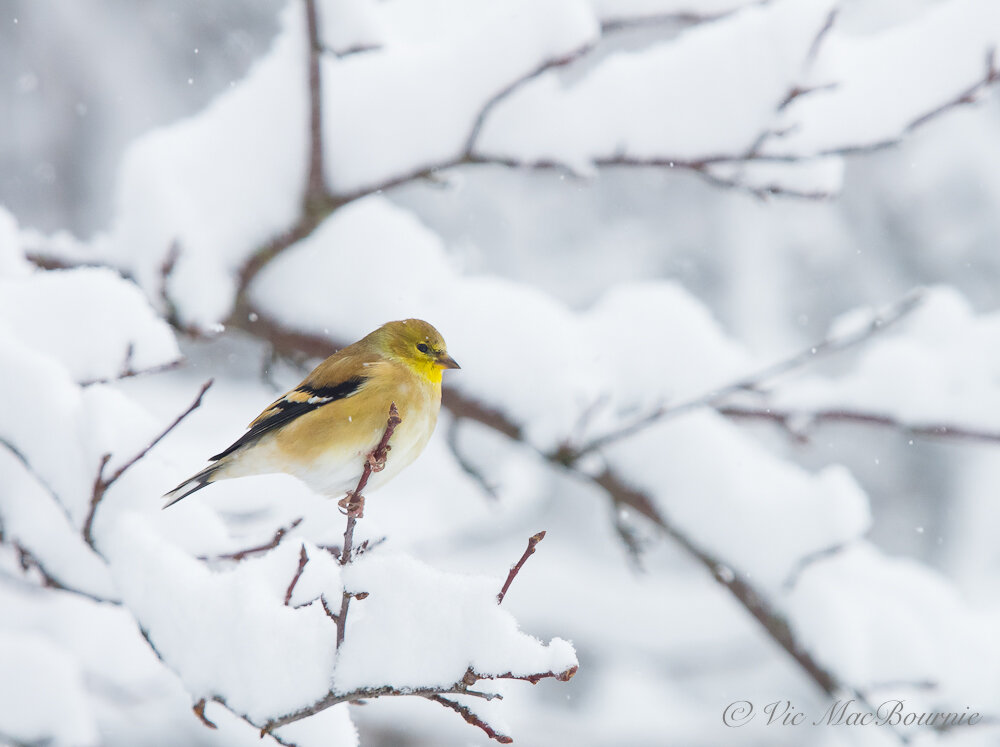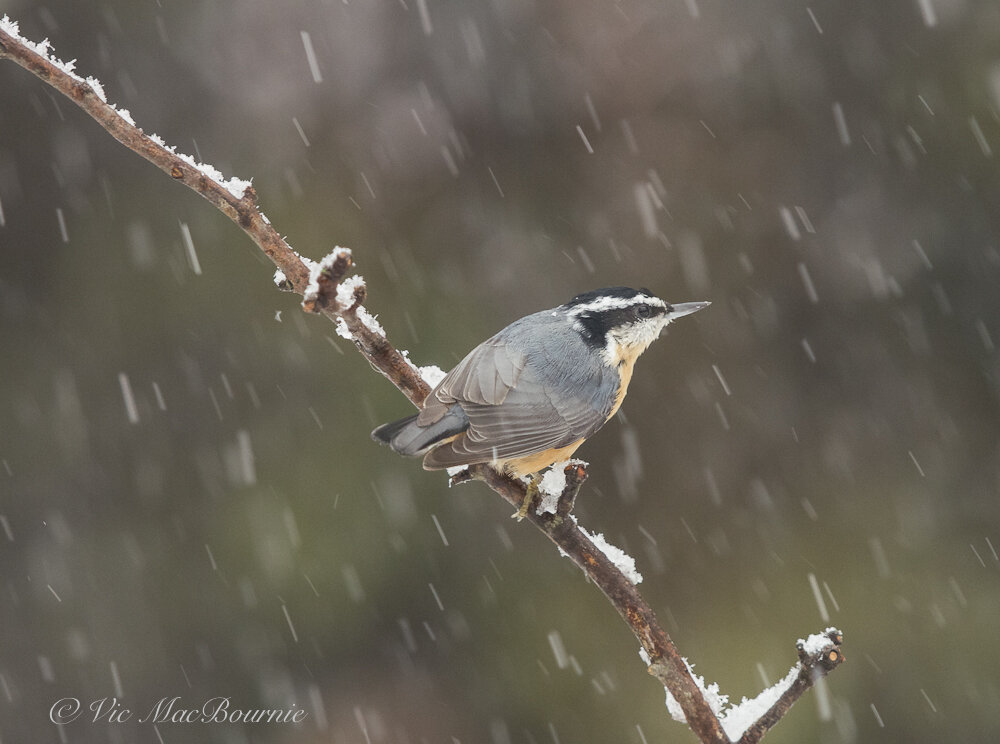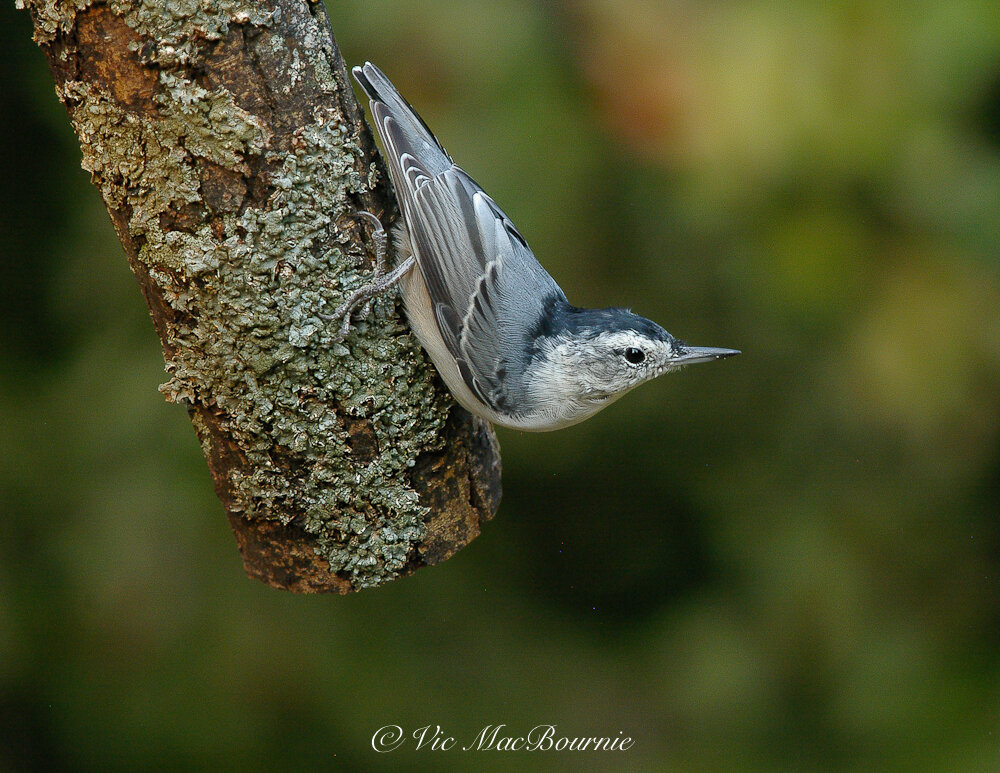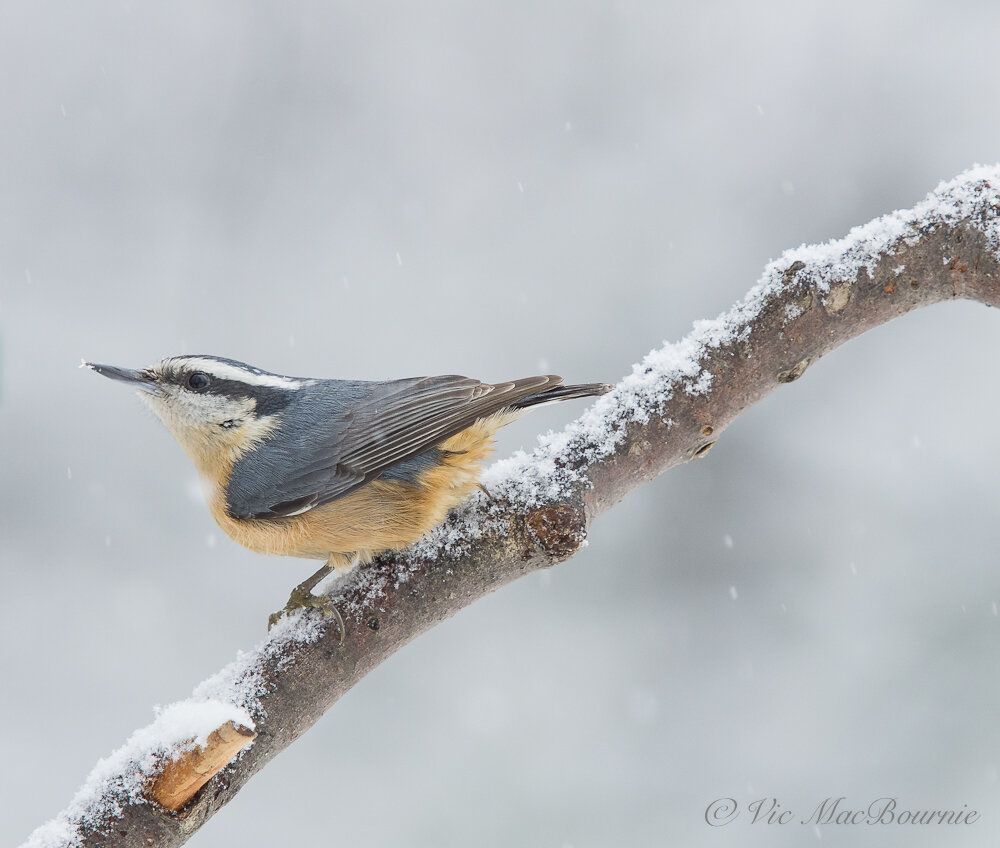How to attract screech owls to your woodland wildlife gardens
Screech owls are popular visitors to suburban woodland gardens and are beginning to increase their numbers in Canada, in part, because more homeowners are installing nesting boxes on their properties. Screech owls are among the smallest in North America but they eat more than their share of mice and rats making them a favourite for woodland gardeners.
What do screech-owls sound like? Where do they live?
I know they’re here. I’ve heard them. Many times.
And now, a few years later, I’ve finally seen one in the garden. I suspect they’ve been around all this time but they are not all that easy to see. Sundown and sunset are the most likely times to see them, but even then their natural camouflage makes them almost impossible to spot.
Plenty of nights when I take our dog Holly out before bedtime, we’ve heard them calling out – screeching, if you will. It’s a little eerie at times when you are not expecting it, but it’s music to my ears now that I can identify the call. (Link to screech owl vocalizing.)
It’s not exactly a screech, more a whinny like a horse and trilling, but it could be mistaken for a Screech if you’re alone in the middle of the night in a forest.
Eastern Screech owls are not large.
Many people even mistake the robin-sized nocturnal woodland owl with short ear-tufts and yellow eyes, for fledgling Great Horned owls when they notice them in their neighbourhood. Not that they are easy to notice in the first place. Not only do they blend into the forest, their nocturnal habits make them a rare sighting if you are not making a conscious effort to find them.
These small owls, however, can be more common in your neighbourhood than most may realize.
Where do screech owls live?
The Eastern Screech Owl, a common species found east of the Rockies, can be spotted in a variety of habitats including woods, suburbs, and parks. These adaptable birds are not picky when it comes to their living arrangements and can even be found nesting in larger backyard nest boxes.
Their ability to blend seamlessly into their surroundings makes them difficult to spot during the day, so it’s best to listen for their distinctive calls at night.
Geographically, the Eastern Screech Owl’s range extends from the Rocky Mountains to the Atlantic coast, covering a vast area from southern Canada down to Florida and southern Texas.
In fact, these adorable little nightbirds are quite common throughout Eastern United States as far south as Florida, including parts of southern and central Ontario into Manitoba and Saskatchewan.
One of our screech owl boxes installed on a mature pine just waiting for its first homeowners.
Although these little guys are still widespread and fairly common, they are gradually declining in parts of their range. If there is good news in climate change, it is that the Screech owl is slowly expanding its range farther into Ontario, Manitoba and Saskatchewan and even into Alberta.
In Canada, this species is a year-round resident, with the majority of the population concentrated in southern Ontario.
Whether it’s in the dense woods, the quiet suburbs, or the bustling parks, the Eastern Screech-Owl has managed to adapt and thrive in a wide range of environments. So keep your eyes peeled and your ears tuned in as you never know when you might catch a glimpse or hear the haunting call of these elusive birds.
The North American Breeding Bird Survey estimated that between 1966 and 2015, the number of Screech owls increased in Canada, but declined in the United States. But of the estimated 900,000 global breeding population, 95 per cent live in the U.S., 4 per cent in Mexico and a mere 1 per cent in Canada.
Cool facts about Screech Owls
Screech Owls are the smallest owls in North America
In some parts of the U.S. including Texas, Screech owls use small blind snakes to keep their nests free of insects while they are raising their young. A study showed that owls that brought these small snakes (more like a worm than a snake) into the nesting area had fewer insects like ants, termites or larvae. Researchers found that the snakes proved beneficial to the young owls who were found to have fewer health problems and a better chance of survival. (Click here if you want more information about the collaboration between the owls and snakes.)
The tips of flight feathers of the Screech Owl are serrated and, as a result, their flight is almost silent and allows them to swoop down on unsuspecting prey.
Screech owls have such an acute sense of hearing they can find small mammals such as mice under very heavy snow or vegetation. This makes them successful hunters in all seasons.
Their large eyes give them excellent eye sight at night, but because of the position in the front of their heads they are able to move their heads 270 degrees in either direction. This gives them the ability to see in an almost complete 360 degrees.
During the day, Screech owls conceal themselves in trees, their plumage camouflaging them against the bark. If they feel extremely threatened, they will make themselves appear very thin, squint their eyes and sway back and forth to imitate the natural movements of a branch in the wind.
Owls represent wisdom in early Indian folklore
These owls were considered protectors in ancient Greece mythology and accompanied Greek armies to war.
If you are looking for Screech Owls, natural woodlands with an open understory are an excellent place to start, and a woodland garden rich in native plants and trees can be the perfect spot for a couple of screech owls to call home.
The abundance of native plants and trees will help attract insects which form a large part of the Screech owls’ prey made up of small mammals, birds and reptiles.
You’ll also find Screech owls in the small woodlots around farms where the hunting is good for field mice – one of their favourite prey.
They generally favour deciduous or mixed woods with plenty of open ground for hunting. Wooded areas along streams and rivers also provide prime habitats for these owls. Suburban yards and city parks can be ideal places for them to take up residence provided there are large trees and nesting cavities.
Unfortunately, homeowners remove many of the owls’ natural nesting holes when they remove dead snags from their yards. Thankfully, nesting boxes have taken over where natural nesting holes have been removed.
Nesting boxes are said to be part of their success story and expansion of the owls’ range.
I recently picked up two large home-made boxes (see photo above) which have been installed about 15 feet up in two trees in our woodland garden. One of the boxes found a home in our mature Austrian Pine.
Owl boxes, although on the large side compared to traditional blue bird boxes, are available at some specialized wild bird stores as well as through Amazon. JCs wildlife screech owl box is even featured in this you tube video and comes highly recommended.
It’s never too early to get your boxes out to give the owls an opportunity to discover them.
Screech owls are secondary inhabitants of nesting sites so they are always on the lookout for a new home.
They can often be found nesting in former woodpecker or squirrel tree cavities. Breeding season for Eastern Screech Owls is generally around mid April, but it can range from mid March through to mid May.
The elaborate courtship ritual begins with the male enticing the female by calling from a variety of branches until they are close. This is followed by what can only be described as a scene out of a 1980s disco hall with the male bobbing and swivelling his head and entire body as he slowly winks at the female. If the female ignores him he takes his dance moves to an even higher level, if she accepts, they touch bills and begin preening each other. Pairs pretty much mate for life.
When do Screech owls nest
The nestling period is between 26-30 days and incubation can be between 27-34 days. The hatchlings are born with eyes closed and covered in white down.
When on the nest, the female remains in the nest except for brief excursions at dawn and dusk.
The male provides the female and nestlings with all the food, while the female rips and tears it into small bits for the babies.
Both parents provide food for young owls, who leave the nest about 4 weeks after hatching.
Their diets vary from small animals, including birds and mammals as well as earthworms, insects, and pond inhabitants like tadpoles, frogs and lizards where available. Rats, mice and squirrels, moles and even rabbits are on their lists as well a birds including birds as large as jays, grouse doves and woodpeckers. They’ve even been known to cache extra food in tree holes, when prey is plentiful in the area.
Adults tend to remain near their breeding areas year-round, where the males defend small territories around nest sites. Breeding territories range from 4 to 6 hectares (10-15 acres in wooded suburban areas. Territories are much larger (200 acres) in open rural areas.
Captive Screech owls can live up to 20 years, while wild birds live much shorter lives. Predators include larger owls such as the Great Horned Owl, minks, weasels, raccoons, skunks, snakes, crows and Blue Jays.
Where to install your owl nest box
The nesting boxes need to be installed in large mature trees between 6-30 feet high. They should be mounted in an area that affords a clear flight path in and out of the box as well as nearby branches where the fledglings can make their way to after immediately leaving the nest. Mounting the box in a southerly direction is ideal but an easterly or western exposure has also proven successful. A northern exposure is not advised.
It helps to have an uncluttered understory for the owls to successfully hunt.
Author Profile: Vic MacBournie is a former journalist and author/owner of the award-winning website Ferns & Feathers. He writes about his woodland wildlife garden that he has created over the past 25 years and enjoys sharing his garden photography with readers.
Five of the best backyard birding books
Winter is approaching an time for woodland gardeners to change focus from their gardens to backyard birds and wildlife. Here are five outstanding books that will help birders get the most out of their backyard feeders by attracting the greatest number and variety of birds to their backyard.
Tips to attract more birds to your backyard
Winters can be hard on us, but have you ever wondered what our feathered friends go through when the temperatures drop and snow covers the ground and their normal sources of food?
For birds and other wildlife, winter is a difficult time and finding a reliable source of food often becomes a matter of life and death.
As more and more native plants disappear, bird feeders become more and more important to backyard birds.
In our garden, many of the traditional backyard birds are already busy stockpiling sunflower seeds in every nook and cranny they can find, whether its tree bark or tucked between crevices in garden benches and other secret backyard hideouts known only to them.
How successful we are in attracting birds and wildlife depends on many factors. Thankfully, many of these factors are within our control.
Providing habitat for our feathered friends, for example, is an ongoing project created over time. There are steps, however, we can take immediately to provide a safe haven for our woodland wildlife. A brush pile (click here for earlier post) is one such addition that will help bring in a greater variety of birds including owls and other predators (click for earlier post on attracting owls) that will begin to see it as a source of food in the form of mice and other small critters that call it home.
If you are looking to purchase one of these books, or any Gardening or birding book for that matter, be sure to check out the incredible selection and prices at alibris books.
Native plants that include berries and fruit will attract fruit-eating birds and mammals that may not be attracted to our bird feeders. Please take a moment to read my complete story on using native plants in our garden
Winter is also the ideal time to learn more about helping out the wildlife that either call our gardens home or visit it on their neighbourhood rounds. The following are five of the best books available for backyard bird watchers and those who want to attract more of them to our yards. They are conveniently linked to Amazon, but many can be found or ordered through your local bookseller.
Alibris is an umbrella group of independent booksellers from the U.S. and the U.K. that provide exceptional deals on used books and music. Be sure to Also check Alibris for great prices on new and used books.
1) All About Backyard Birds: Eastern and Central regions.
Available in paperback new and used.
Most birders are familiar with the Cornell Lab of Ornithology’s excellent birding website and handy app on their smartphone. In fact, I doubt there are many serious birders who are not using the handy birding app to help us identify unusual birds in our garden either by sight and unusual markings, or through their many songs and calls. This book is based on that website, which has had more that 14 million unique users to date.
It’s perfect for a new birder, young and old.
The highly regarded book, published in 2017, has an impressive has a very positive rating with 60 on-line ratings.
The publisher notes that the book: “delivers best-in-class content and proven user-friendly formats. Each regional version – eastern/central North America and western North America – provides 120 of the most popular species and is filled with beautiful illustrations by Pedro Fernandes. With charts, maps, and other bird identification tools, All About Backyard Birds offers beginner birders the ideal way to start birding.”
The book also includes a tutorial for the MERLIN app (available for free on line) already being used by more than 1 million birders.
A portion of the net proceeds for the sale of the book goes directly to the Cornell Lab to support projects, including children’s educational and community programs.
2) National Geographic Backyard Guide to the Birds of North America, 2nd Edition.
Available in paperback both new and used for very reasonable prices.
This is another top notch general source for backyard birders, and it’s hard to go wrong with any product from National Geographic. For travellers, at least in North America, this guide offers an excellent source of information.
The publisher writes: “This comprehensive and beloved guide reveals the most ubiquitous and remarkable species of North American birds, clearly organized by family and paired with identification tips, behaviour, vocal descriptions, and more. The new edition features a "Backyard Basics" section from the world's most prolific birdwatcher, Noah Strycker, with tips on attracting and feeding your favourite birds and creating bird-friendly landscapes. Also included are updated descriptions of 150 common North American species, paired with comprehensive range maps, as well as lush indentification artwork and bite-sized facts. With new contributions from Strycker and a modern redesign, the second edition of this perennial favourite will appeal to new and experienced bird enthusiasts alike.
3) The Backyard Bird Feeder’s Bible: The A-to-Z Guide To Feeders, Seed Mixes, Projects And Treats.
Available in both hardcover and paperback both new and used formats.
Rodale has always been a strong publisher when it comes to gardening books. I have a number of them that I go back to on a regular basis. In fact, Landscaping with Nature, Using Nature’s Designs to Plan Your Yard by Jeff Fox published by Rodale Press, was my go-to book for planning and designing much of my woodland gardening book going back at least ten years ago. The book explains the fine details of creating a natural garden right down to using classical music to place large boulders in your garden. It’s proven to be a very valuable resource.
The author of the Backyard Bird Feeder’s Bible, Sally Roth, will help guide backyard birders to focus on which foods attract which birds, hints on choosing and maintaining feeders and the best native fruit-bearing trees, flowers and shrubs to plant to attract birds.
The publisher writes: Pull up a chair next to the window looking out on your bird feeder and join author Sally Roth in an informative, inspirational, and often light-hearted look at the foods, feeders, and plants that invite birds to visit your feeding station.”
The author shares a lifetime’s worth of bird-feeding experience including how to identify birds at your feeder, and what foods are best for certain birds. She also includes tips on improving the attraction of your garden to birds.
4) National Wildlife Federation: Attracting Birds, Butterflies, and Other Backyard Wildlife, Expanded Second Edition.
Another outstanding book by the highly regarded National Wildlife Federation. It’s available in both Kindle and paperback forms, new and used for a very reasonable price.
If you are not familiar with the National Wildlife Federation, it is the largest U.S. nonprofit conservation organization, with 6 million members and 51 state affiliated organizations.
This book takes backyard birding to another level by urging readers to – not unlike this blog – create a backyard that is more nature-friendly by providing habitats for local wildlife, not just birds. The book includes 17 step-by-step projects that brings the entire family back to nature with easy projects. The book explores wildlife-friendly practices and how to attract backyard pollinators.
The reward from following the many ideas in the book is not only a more wildlife-friendly yard, is a blueprint for getting your garden certified by the National Wildlife Federation’s Garden for Wildlife program by following the certification application checklist that is included in the book. A worthwhile investment in its own right and one that our garden qualified for a number of years ago.
The publisher writes: Your backyard can come alive by creating an environment with plants and spaces that attract nature’s most interesting and friendly creatures! Colourful butterflies, uplifting songbirds, and lively toads can enhance your personal garden space, giving pleasure to nature lovers of all ages.”
“Author David Mizejewski, a naturalist with the National Wildlife Federation, presents simple plans for reintroducing native plants that birds, butterflies, and a whole host of critters can't resist.
5) The Humane Gardener: Nurturing a Backyard Habitat for Wildlife (How to Create a Sustainable and Ethical Garden the Promotes Native Wildlfie , Plants, and Biodiversity.
Nancy Lawson’s the Humane Gardener is a must for any gardener who cares about attracting wildlife to their backyard, whether its birds, mammals or creepy crawlies. Her new book Wildscape is another book serious natural gardeners will want to add to this list.
Click on the link for my complete review of her book The Humane Gardener. Click on this link for my review of her book Wildscape.
Available in Kindle format and hardcover both new and used at a very reasonable price.
The book follows much the same philosophy as this woodland garden blog: one that focuses on a “practical guide for the gardener who hopes to create a backyard in harmony with nature.”
The author, Nancy Lawson, examines why and how to welcome wildlife to your backyard through profiles of home gardeners as well as interviews with scientists and horticulturalists.
The book includes information on planting for wildlife by choosing native plants, providing proper habitats for animals as well as birds, bees and butterflies and encouraging natural processes and evolution in your garden.
Finally she explores the “humane gardener,” who she describes as someone who attracts wildlife and peacefully resolve conflicts with all the creatures that may inhabit your garden. The humane gardener, she concludes, “is someone who sees the garden as a meeting place for all creature, not a territory to be defended.”
Isn’t that the way we all want to garden?
Author Profile: Vic MacBournie is a former journalist and author/owner of Ferns & Feathers. He writes about his woodland wildlife garden that he has created over the past 25 years and shares his photography with readers.
Bird seed: Complete guide to attracting favourite backyard birds
Choosing the best bird seed to attract specific birds to your garden starts with knowing what seed they like and using the proper feeder. Black oil sunflower seeds are a great start but other seeds will ensure you attract the greatest variety.
How to choose the best seed to attract a variety of birds
If you are looking to attract specific birds to your backyard, providing them with their favourite bird seed will go a long way toward your success.
First, it’s important to learn what seed your favourite birds prefer in your area and then find a good reliable source of fresh seed to provide them.
When in doubt, use straight black oil sunflower seed. It is by far the best overall seed to feed backyard birds. But you may miss out on some of the best birds if you stick to straight black oil sunflower seed.
Don’t make the mistake of using a general, inexpensive bird seed mix from your local department store – many of these blends are full of filler that birds will only spill to the ground.
Milo – a small, round whitish grain – is most often used as filler in inexpensive mixes.
There is nothing wrong with milo. It will not harm birds, but it is not their preferred choice and often ends up on the ground. If you either see a lot of milo in the seed mix, or it is listed as one of the primary additions in the mix, it’s probably best to avoid that seed mix.
The result of too much filler is, at best, a mess under the feeders, and, at worst, an invasion of mice and rats filling up on the discarded feed. (More on keeping mice and rats out of the garden.)
Millet is a good choice for ground foragers
Don’t mistake milo for millet. They look similar, but millet in small quantities is favoured by ground-foraging birds like Juncos, sparrows and mourning doves. It’s still probably best to leave it out of the feeders, but throwing a handful on the ground or in a platform feeder is a good idea.
By keeping the above tips in mind, there are blends at your local department stores that are good, but just recognize they come at a higher cost than the cheap mixes.
You are better off feeding the birds less with a high quality seed mix than filling the feeders with a low quality mix that results in problems and eventually stops you from getting the full enjoyment out of feeding your backyard birds.
It’s also important to realize that birds do not count on our seed to survive. They are quite capable of looking after themselves and their families.
Studies have shown, however, that birds – especially chickadees and other regular visitors to our feeders – do better if supplemental bird food is available.
It is our responsibility to ensure that feeding the birds in our yards is not detrimental to their health. Keeping the feed fresh and the feeders clean should be a top priority.
More reading: Why recycled resin feeders are better than wood feeders.
Black oil sunflower: The best all-round choice
If in doubt, a good quality black oil sunflower seed is an excellent all-round choice that the majority of birds will readily eat.
Black oil sunflower is favoured by most birds because the seeds – in comparison to the common striped sunflower seeds – have a higher oil content, are easier for small birds to handle and are more nutritional for backyard birds. The black oil sunflower seed is extremely high in protein, as well as fiber, calcium, vitamin b-complex, vitamin e, potassium and iron.
They are favoured by our colourful Northern Cardinals, Evening grosbeaks, Blue Jays and House finches, in addition to chickadees, nuthatches, Tufted titmice, Mourning doves, grackles, Gray catbirds, Pine siskins and a host of others.
How to attract Cardinals to your feeders
Most birders enjoy seeing both male and female cardinals at our feeders.
If you are looking to attract these colourful but somewhat shy birds to your backyard, consider providing them with a large hopper feeder filled with a combination of safflower and black oil sunflower seed both in an out of the hull.
By leaning more heavily on the safflower seed, other birds will focus on a feeder filled with black oil sunflower and leave the safflower for the cardinals.
Safflower is a top seed choice for attracting cardinals. One of its other benefits is that it discourages squirrels, grackles and even sparrows from feeders because they dislike safflower seeds.
The small white thin-shelled seed is readily eaten by cardinals, nuthatches and chickadees.
A good mix will attract the greatest variety of birds
Feeding only the small black oil sunflower will limit the type of birds that are regulars at your feeders.
It’s important to offer a variety of seeds to attract the greatest variety of birds.
Compressed seed cylinders have always been a popular choice in our yard. They are available in a number of different mixes including ones that have meal worms compressed in with the seed mixture. Check out my full story on compressed seed cylinders.
Specialized bird or nature stores will even create specialized mixes for different times of the year (winter, summer, spring and fall), for different habitats (woodland, rural, urban, town and country.)
If done well, these mixes can be especially helpful to attract the birds that are in your area either year round or seasonally.
Wild Birds Unlimited, with stores across the United States and Canada, offer seven primary blends ranging from No-mess blends, to a deluxe blend, supreme blend, tree nut blend, finch and wildlife blends. Individual stores may offer further blends developed for birds in a particular geographic area.
Canada’s Urban Nature Store (link to store website) (Amazon.ca link) also offers a host of blends as well as straight seed.
The Kaytee brand of wild bird seed available at Amazon and elsewhere also offer a high quality seed and variety of quality mixes.
Nyjer or thistle seed is a favourite of Goldfinches
There is no question that Goldfinches are attracted to Nyjer or thistle seed, but only if it is fresh and of high quality. Nyjer/thistle seed that is past its prime, or worse, beginning to get mold growing on it, will be ignored by the birds.
But that may not be the only reason the birds are ignoring your thistle or nyjer seed.
Nyjer/thistle seed can be tricky. The seed actually comes from India and is part of their thistle plants. Before the seed can be imported into North America or parts of Europe, the seed must be cooked. Over cooking the seed removes the protein and makes them useless for birds.
If you notice that the finches are not eating your Nyjer seed, chances are it’s either well past its prime, going moldy or was over cooked in the factory prior to packaging.
If you notice the birds are not eating your Nyjer seed, don’t waste your time, purchase a new supply of Nyjer for your feeder.
You are much better off buying smaller amounts of nyjer seed and using it as quickly as possible rather than buying a large bag and storing it for prolonged periods of time.
It is important, therefore, to ensure you buy seed from a reputable seller that moves a lot of stock. Purchasing Nyjer at your local department store may not be the best idea. The seed may have been sitting on the shelves for months before you purchased it.
No-mess mixed seed is a solid choice
I have found that using a no-mess mix heavily weighted with shell-less sunflower seeds is the best choice as the primary food source for birds in the backyard.
It’s expensive, yes. But it has so many benefits that overpower any negative factors around price that it is my go-to seed choice for our recycled resin hopper feeders.
By using less food, and the fact that none is wasted and left on the ground, I feel it is the best value in the long run.
Consider adding in a couple handfuls of shelled black-oil sunflower to make the no-mess seed stretch further.
Birds will most likely store the shelled sunflower seeds in tree bark away from the feeder so it is unlikely to build up on the ground below feeders.
Final thoughts on best bird seed
First, let’s agree that feeding birds can be expensive. It gets even more expensive when most of that seed goes to feeding squirrels, raccoons, mice and rats.
Preventing animals from getting up to the feeders and the feed from getting down to the ground is critical to keeping costs down and deterring these animals.
Using a high quality food that birds will not waste or throw to the ground is an investment worth making. A no-mess mix is an excellent choice and by adding black oil sunflower seeds to your liking you can reduce the overall cost.
Most important, the high quality seed will attract the birds you are trying to bring into the garden and add to the joy and excitement you were hoping for in the first place.
Take the time to find a good source for seed and don’t over feed them to the point that the seed sits for long periods in the elements.
The best and most economical way to feed birds is the natural way through properly landscaping your yard using native flowers, shrubs and trees that include seed, berries, fruits and nuts.
If you are interested in moving in this direction, check out my comprehensive post on using native plants to feed birds.
Over time you can use bird feeders as nothing more than a supplemental feeding station to attract very specific birds.
Happy birding.
How to attract Red-bellied woodpeckers to your woodland garden
Red-bellied woodpeckers are woodland birds that have made their way into backyards across the south and into northeastern United States up into Canada.
Identifying Red-bellied woodpeckers can be tricky
The Red-bellied woodpecker is a regular at our bird feeders thanks to one special food source and a delivery system that keeps it coming back throughout spring, summer, fall and, especially, winter.
This woodland species is an attractive, medium-sized, black-and-white barred woodpecker with a name that might suggest a bright red belly shining for all to see but, in reality, the red on the belly is a barely perceptible hint of reddish orange tucked closer to the bird’s rump than its belly.
Given that the splash of red on the birds’ belly is barely perceptible, you could be forgiven if you wonder how this bird even got its name.
This hidden patch of red on its belly is the primary reason the bird is often misidentified in the field by new birders expecting to see a big bright red belly similar to that of an American Robin.
Even trying to identify the males from the females is quite difficult.
The main difference is that the males have a red crown and nape on their heads, while the females only have the red nape and lack the red crown. (In other words, only the males have the bright red head patch from their foreheads to the base of their neck. Females have red only on their neck. See images below to see the differences between both male and female Red-bellied woodpeckers.)
Red-headed vs Red-bellied woodpeckers
This flashy red on the Red-bellied woodpeckers’ rounded heads often leads to a further misidentification with the Red-headed woodpecker.
The vibrancy of the Red-bellied woodpecker’s head may have originally resulted in them taking the name “red-headed” if it was not already taken by its fellow, even more impressive, red-headed cousin.
The red-headed woodpecker is actually quite rare in comparison and sports a complete, almost blood-red head and solid black body with white tail feathers and a bright white breast.
The red-bellied woodpecker is also easily mistaken for a Hairy Woodpecker, which is about the same size.
For more on identifying different woodpeckers, check out my earlier post here.
How big is the Red-bellied woodpecker?
The Cornell Lab of Ornithology describe the Red-bellied woodpecker’s size as somewhere between an American robin and a common crow.
The Northern Flicker, which share some of the same characteristics but is more buff in colour, is slightly larger than the Red-bellied woodpecker.
Both the male and female red-bellied woodpecker measure about 9.5 inches (24 cm) long, and weigh in at between 2.0-3.2 oz (56-91 g). Their wingspan stretches out to between 13.0 and 16.5 inches (33-42 cm).
Red-bellied woodpeckers are happy to feed from the common hopper-style feeders, but they much prefer the large seed cyclinders of compressed peanuts and sunflower seeds that sit on top of our bird-feeding station.
How to identify Red-bellied woodpeckers
When trying to identify these birds, it is probably better to focus on the banded, zebra-like pattern on their back, instead of looking for their faint reddish splash of colour on their bellies.
Both the male and female have sturdy, thick black bills that are excellent for drilling for food in the bark of hardwood trees. Their legs and feet are gray.
What is the range of the Red-bellied woodpecker?
These birds may be common in the eastern woodlands but they are actually birds of the southeast regions stretching down as far south as Florida. According to studies, in the first half of the 20th century, this bird was declining in its more northern limits.
More recently, however, the Red-bellied woodpecker is actually expanding its numbers farther into the north reaching the southern limit of eastern Canada including Quebec and even Newfoundland, where they are more rare.
Backyard bird feeders are often cited as a main reason for this expansion northward.
Red-bellied woodpeckers numbers are reported as stable and in the range of about 10 million breeding birds.
These birds are more or less resident birds that do no not migrate any great distances. Reports show that some birds may move to a more northerly location in fall and remain through winter.
What is the oldest Red-bellied woodpecker identified?
The oldest known woodpecker was a male found in Georgia where its band indicated it was more than 12 years old.
Most of the woodpeckers, however, do not live more than 11 years with a range of between 4-11 years depending on the type and their range.
Most of the Red-bellied diet consists of insects and spiders, but when insects are more rare, they are also happy to dine on other foods, including seeds, berries and fruit. In fact, during some seasons they eat up to 50 per cent seeds (including pine cones and acorns in the wild).
In the fall and winter they will also eat plenty of fruit such as wild grapes and other berries that remain on the trees and shrubs throughout the winter.
It’s always a good idea to include berry- and fruit-producing trees and shrubs to provide natural food for backyard wildlife.
(Be sure to check out my complete post on using native flowers, shrubs trees and vines to feed birds and other wildlife.)
What do Red-bellied woodpeckers eat in our backyards?
In our backyard, the Red-bellied woodpeckers are quick to come to the feeders to fill up on sunflower seeds and peanuts.
Red-bellied woodpeckers are happy to feed from the common hopper-style feeders, but they much prefer the large seed cyclinders of compressed peanuts and sunflower seeds that sit on top of our bird-feeding station.
I purchase the cylinder specifically labelled for woodpeckers and they seem to do the trick.
A dish of dried or live meal worms will certainly help get their attention and compressed seed cyclinders that include meal worms, berries, nuts and sunflower seeds are always welcomed by these noisey birds.
These large cylinders are by far their favourite, not only for their easy source of seeds, but for the ease that the birds can get at the food.
The cylinders provide a very natural perch for the woodpeckers to take advantage of their large beaks to extract the seeds.
Sitting in my Tragopan photographic blind watching the woodpeckers working the seed cylinder is fascinating with bits of seed flying in all directions. The cylinders keep the birds at the location for a number of minutes, making viewing and photographing them a real joy.
(Be sure to check out my comprehensive post of Using seed cylinders in the garden. Not only are they a great food source for birds, but because they hold the seed better than hopper feeders, they help to deter mice and rats from eating seeds that are thrown to the ground by Jays and other picky birds.)
As winter progresses, I like to add more high-protein suet to their diet.
Suet bricks are popular and easy to add to the specially made cage feeders, but don’t overlook DIY suet logs that are easy to make from an old branch. Just drill some holes in it and pack the holes with suet for a more natural feeder that works particularly well if you are trying to photograph the birds in a more natural setting.
I like to use a product called bark butter to work into the holes. It is particularly attractive to a host of backyard birds.
(Check out my separate post on the benefit of Using bark butter to attract woodpeckers.)
Because they are quite large woodpeckers, the suet feeders with the tail prop work extremely well and are highly recommended. The recycled resin feeders, while they are more expensive, are easier to clean and will last a lifetime. This Songbird Essential suet feeder from Amazon combines the recycled plastic with a large tail prop for larger woodpeckers including The Pileated woodpeckers. Gardener’s Supply Company has their own take on the suet feeder with prop also in a recycled resin.
In addition, suet feeders that force the birds to hang upsidedown while they are feeding also work well and they are particularly good if squirrels regularly feed on your suet.
(Check out my post on why Modern resin bird feeders are a better choice than wood feeders.)
And, don’t be surprised to see a Red-bellied woodpecker on one of your hummingbird or a Baltimore Oriole feeders during the summer.
Not only will they help themselves to orange slices and the grape jelly set out for the Orioles, these woodpeckers have discovered the sweet nectar in the feeders and will help themselves to the instant source of energy. They may also be attracted to insects that are constantly around the feeders.
(Check out my earlier post on attracting Baltimore Orioles and another post on attracting hummingbirds to your garden.)
A snag or old dying tree creates an ideal habitat for woodpeckers and other tree-dwelling birds.
Dead trees (snags) are important habitat for Red-bellied woodpeckers
Woodpeckers are tree-cavity nesters, so it’s important to leave dead trees (snags) in your garden for them.
In a natural setting, these birds will typically nest in a dead tree or, in more suburban areas where dead trees are harder to come by, in a rotting fencepost or even in the side of a wood-sided home if given the opportunity.
They like to nest less than 50 feet above ground but have been known to nest more than 100 feet above ground.
They have also been known to use larger nest boxes in more urban settings and some specialty bird stores sell size-appropriate boxes.
The importance of leaving dead trees in the yard cannot be underestimated. Not only may you discover a pair nesting in the tree, but the dead tree offers hiding places for a host of insects the woodpeckers will feed on with their long, sticky, forked tongue that can actually protrude as much as 2 inches into crevices to pull out insects and beetle larvae hiding in the snags.
In addition, woodpeckers, along with other birds like Chickadees and Nuthatches, also store food in the crevices of tree bark and snags to snack on later when food is more scarce.
(Be sure to check out my comprehensive post on why we should leave dead trees in our yards.)
Do Red-bellied woodpeckers mate for life?
Unlike blue jays and other birds, Red-bellied woodpeckers do not mate for life, but they are monogamous during a mating season. They usually pair up in late winter and remain together during the nesting season. They will find a new mate the following year.
The Red-bellied woodpecker breeds once per year, usually in March or April, when the female lays an average of 4 eggs. About 12 days later the babies begin to emerge and have fledged the nest within about 27 days. They remain around their parents for between 2 and 10 weeks before going out on their own entirely.
Red-belly woodpecker wrap up
Attracting Red-belly woodpeckers is not really difficult if you are lucky enough to live in their range. It helps if you are also lucky enough to live near a forested area or have created a large woodland-style garden where these birds can feel at home.
Include large snags, berry and fruit trees and vines, a reliable source of water and good quality sunflower and nuts at your bird-feeding station. A large seed cylinder and suet placed into a resin feeder with a tail prop will go a long way to attract these very vocal and fun birds to your yard.
And, while they are setting up residence, don’t forget that their voracious appetites for insects and spiders will help to keep their numbers down.
American Robins: How to attract them to our yards
The American robin has always been a mainstay in our backyard whether they are eating crabapples or enjoying themselves in the bird bath.
More of these spring harbingers are remaining all winter
Most of us remember the first sign of spring involved an orange breasted bird and a worm.
Once we saw our first Robin pulling a worm out of the grass it was officially spring. Today, many of those same orange breasted birds are sticking around all winter living off berries, bugs, larvae and anything else they can scrounge to get them through our winters.
Milder winters resulting from climate change are certainly playing a role in more American Robins remaining in their northerly limits, but the threat of sudden and prolonged periods of freezing temperatures combined with heavy snow fall can certainly put the birds in severe danger.
It’s another good reason to ensure we do our best to supplement our bird feeders with more natural food for the birds – berries, fruit and even meal worms – especially during the winter.
Be sure to check out my comprehensive post on the best plants to feed birds naturally and save money.
Robins are regulars in our backyard
Throughout most of the winter, I watch a small flock of American Robins feeding off of our two crabapple trees in the back of the yard. I suspect it is an important food source for the resident Robins, when other food supplies in the area are scarce.
The American Robin is probably one of the most familiar birds in North America. In fact, it is actually the state bird of three northeastern states – Connecticut, Michigan and Wisconsin.
Where did the American Robin gets its name?
The American Robin got its name from European settlers who named it after the more diminutive and cheerful European Robin, which sports an equally impressive red breast and is often referred to as “Robin Redbreast.”
Although it is easy to see that the colouring of the two birds resulted in the identical names, the similarities more or less end there.
The American robin is actually a member of the thrush family and is much larger than its European namesake. Those who have studied the history, say that the two birds were given the same name as much for their character as their colourings. Both birds readily adapt to urban areas and are happy to live among humans, in fact, they eagerly stay close by to benefit from potential insects we sometimes stir up in the garden.
Whether you are in England digging a new garden bed or New York, chances are a robin is nearby watching your every move. And, don’t be surprised if they come right down to your feet to nab an unearthed worm or other insect.
It turns out the European settlers didn’t stop giving North American birds the Robin moniker after bestowing it upon the American Robin. Apparently, even our beloved bluebirds were tagged with the name robin. That’s understandable since the Eastern bluebird sports a lovely orange breast and reflects many of the traits of the European robin when it comes to size and characteristics.
But that didn’t end the Europeans obsession with naming our birds after their beloved robins. Towhees originally earned the name ground robin and Baltimore Orioles were called the Golden Robin.
Obviously all four sport red-orange breasts that undoubtedly played a role in being compared to the friendly European robin, a mainstay in any British garden.
In fact, the American robin in all but colouring, is more related and shares more things in common to the Eurasian blackbird. Other than its colouring –which is all black – the blackbird is also in the thrush family and sports similarly to the American robin, a yellow beak and white around its eye.
Early Americans also called the bird the wandering thrush, which seems a more accurate description.
Robins love a good bath
If there is one thing in our garden that the robins love most, it’s our many bird baths sprinkled about. if you are looking to attract Robins to your yard, a couple of good, solid, large bird baths are essential. You will be amply rewarded, if you can keep a good reliable source of water for them throughout the winter.
Be sure to check out my article on creating a DIY heated bird bath for the winter.
American Robin is actually a woodland bird
Although the birds are a common sight in residential yards and parks, this wasn’t always the case. American Robins are actually woodland or forest dwelling birds that have learned to adapt to the abundance of food – primarily worms in grass – in surburban landscapes.
Many of our American Robins end up returning to woodlands and more “wild” areas in the winter,where they can more easily find food – in an abundance of berries and other fruit as well as overwintering insects and larvae.
Creating a more natural yard, by planting plenty of native berries as well as leaving leaf litter for overwintering insects and larvae, will help to attract these wonderful birds throughout the winter.
Creating this natural food source in your woodland/wildlife garden will also go a long way to ensure the survival of the American Robin in your neighbourhood.
Robins love their bird baths. Be sure to ad a birdbath or small pond to attract these members of the Thrush family.
How do Robins survive winter?
During the winter, it is common to see the Robins travelling in large flocks where they work together to find natural food sources. Winter roosts can be huge with some estimates reaching more than two hundred thousand birds.
But, just because you see flocks of Robins in your area one year, does not mean they will necessarily return the following year.
Robins tend to be nomadic birds that don’t follow the typical north to south migration route. Individual Robins get around and may winter in completely different geographic areas from one winter to another. They have been known to travel long distances between states following the abundance of food in any given year.
Each spring, however, Robins return to their original nesting area and have even been known to use the previous year’s nest – with some modern improvements of course – if it proved successful the previous year.
A few facts about Robins
• In more northern regions of Ontario for example, Robins continue to be known as the harbingers of spring. They tend to show up around the end of March through early April as the warmer weather thaws the ground making worms and other insects more accessible.
• Worms only make up 15-20 per cent of the Robin’s summer diet. The rest is made up of other insects, fruits and berries.
•Robins tend to eat more earth worms in the early morning when they are more visible and closer to the surface, and turn to fruit later in the day.
• Robins belong to the Thrush family – family of birds known for their beautiful songs. Because Robins tend to hang out in neighbourhoods and around other human-dominated habitats, their spring songs are very familiar to most of us wheter we know it or not. Their rich, cheerful songs fill our neighbourhood each spring when they are particularly vocal announcing the arrival of spring and their readiness to mate and get on with building their families. Robins are known to sing their songs throughout the day and even will after sunset.
• Because Robins are comfortable in our gardens and around humans, it is not uncommon to have a pair nesting close to our homes and high-traffic areas such as on top of exterior lights, in hanging baskets on garden ornaments or just about anywhere the pair can find a good sturdy structure to build their nest. Last year, our neighbours had a pair nesting in a wreath near their front door, seemingly oblivious to all the comings and goings.
The birds’ ease around us often provides excellent opportunities to observe the family as they grow up in front of our eyes.
They can be the perfect opportunity for children to be exposed to the beauty of nature as they watch the parents on the nest, feeding the young and eventually watch as the fledglings leave the nest.
If you have children or grandchildren who express an interest in nature, be sure to check out my comprehensive post about why children need more nature in their lives.
Robins can nest up to three times in a breeding season, often using the same nest. However only about 40 per cent of the nests produce young and only about 25 per cent of those young Robins survive through fall to take on the winter. About half of the Robins that go into winter survive to mate the following spring.
Given those statistics, it’s not surprising that American Robins have an average lifespan of about 1.5 to two years, but they can live longer if given the right environment. For example, the longest lived American Robin recorded in the wild was almost 14 years old.
How to identify the American Robin
The American Robin is one of the easiest birds to identify with their rusty red belly against a greyish-black upper body, a bright yellow beak and white markings around their eyes.
These rather large birds measure around 25 centimeters long and weigh in at 77 grams, making them the largest thrush in North America.
The can be found right across North America from the farthest reaches of Alaska in the north, across to Canada’s Newfoundland and down south from Florida across to California.
Are American Robins threatened?
Robins face a hose of deadly foes around our residential gardens from the over use of insecticides especially on turf grass where they feed on worms and other insects, to the presence of unnatural predators such as cats, and collisions with windows.
Be sure to check out my two earlier posts on protecting birds from stray cats and how to protect birds from window strikes.
A more serious threat that has recently attacked American Robins is the mosquito-born virus West Nile that has killed a stunning number of both Robins and Blue Jays.
Be sure to check out this link for my comprehensive post on Blue Jays and West Nile.
Despite these challenges, the good news is that studies are showing that the American robin populations over the past 40 years have slowly increased. This increase is thought to be related to their ability to adapt their lifestyle to live comfortably in our suburban neighbourhoods.
The combination of a more readily accessible food source (worms), safe nesting places (unnatural as many of them are) and milder winters have no doubt combined to provide American robins with a fabourable environment despite the many threats they face in the suburban landscape.
What’s the best Blue Jay feeder?
Here are two bird feeders you will want to check out that are magnets for our noisy blue jays.
Two of the best feeders to attract Blue Jays
Attracting Blue Jays to your yard begins with having the right bird feeders to deliver their favourite food.
In our yard, there are two feeders that do an excellent job attracting our northern blue jays year round.
The best Blue Jay feeders are both simple and inexpensive, and deliver Blue Jays’ their favourite foods in a convenient way that allows them to perch comfortably while feeding. A seed cylinder spike, and a wreath-style whole peanut feeder are two of the best feeders for blue jays.
If you follow this website, you’ll know that my all-round favourite bird feeder is a simple attachment to the Wild Birds Unlimited Advanced Pole system. It involves nothing but a spike that sits on top of the pole and holds a variety of compressed seed cyclinders.
This is a very simple system that works for me and the birds. The one problem I have is that the seed cyclinder is directly open to the elements. This allows the Jays and other birds to have easy access to the sides as well as the top of the seed cyclinders, but it also allows water to eventually get into the seed and begin to break down the “glue” (it’s actually a gelatin that works like glue), leading to the enventual early demise of the seed cyclinder.
There are seed cylinder feeders that include toppers to help protect the cyclinders from being totally exposed to the elements. I think they are certainly worth considering, especially if you live in a particularly rainy or snowy environment.
The spike is simply the delivery system for the seed cyclinders, so it’s paricularly important to provide the Blue Jays with their favourite foods in the cyclinders. Look for compressed seed cylinders high in their favourite foods – black oil sunflower seeds, regular sunflower seeds and unshelled peanuts.
The round peanut feeder above and pictured below is a real favourite of Blue Jays giving them plenty of space to land. Their strong beaks enable them to easily pull the peanuts out from between the springy wire circles holding them.
One of the main reasons the cylinders are so attractive to blue jays and less attractive to some other backyard birds, is the fact that blue jays have very strong beaks that allow them to pound at the cyclinders to get the seeds they want. Our cyclinders are most visited by blue jays and woodpeckers. Other, smaller birds, are left to pick up the pieces of seed that fall off when the jays and woodpeckers attack the cylinders.
If you are interested in more information on attracting Blue Jays to your backyard, check out my post on Blue Jays and West Nile.
The spiked bird feeder that holds the compressed seed cyclinders doesn’t have to go on the top of a pole. Attachments are available to use a spike and seed cyclinder attachment as an accessory on other parts of either the WBU Advanced Pole System or other bird feeding station. Some spike-style accessories can be hung on feeders after inserting the seed cylinder, so there is no excuse for not adding one to your bird feeding station.
Blue jays flock to the Wreath feeder for peanuts
While the seed cyclinder feeders are excellent for attracting blue jays to your yard, I think the wreath feeder filled with shelled peanuts is the best feeder to attract the birds.
The main reason for the success of the wreath feeder is what we will them with – shelled peanuts. I think shelled peanuts are blue jays’ favourite food. And, because the shells are difficult for smaller birds to penetrate, you can count on your blue jays to get most if not all of the peanuts. The wreath feeder can accommodate a number of blue jays at one time and provides them a good perch to remove the whole peanuts from the cyclinder.
Woodpeckers also enjoy whole peanuts in the wreath, but they primarily peck away at the peanuts rather than remove them to eat elsewhere like blue jays do.
The only problem I have with a wreath-style feeder is loading it with peanutes. While it’s not particularly difficult, I find loading them by hand can be a little bit tedious. I’m sure there are better ways to load peanuts into the feeder, but so far I have not discovered it.
The wreath feeders are a particularly effective way of delivering whole peanuts, but there are several other ways to deliver whole peanuts that can also work.
The Urban Nature Store in Canada actually groups their feeders according to what feeders are best for specific birds. Check out their list of best blue jay bird feeders just to get a feel for what feeders are best.
Check out your local bird store for other peanut feeders.
Carolina wren: How to attract this spunky little insectivore
Attracting Carolina Wrens begins with creating a habitat to attract insects to your yard. Insects account for close to 95 percent of their diet, but they will come to bird feeders in winter, especially those with suet and peanuts.
Rewild your yard to attract Carolina Wrens
The Carolina wren is a noisey, spunky little bird that is, at least from a distance, easily mistaken for a sparrow.
But up close, there is no mistaking these little guys.
If you are looking to attract Carolina Wrens to your yard, you will have to create habitat that encourages an abundance of insects in your yard. If your backyard is a typical neat and tidy suburban yard with few native flowers, shrubs and trees, you will need to get to work rewilding the space.
It goes without saying that pesticides have no place in the garden. Native trees, shrubs and plants are vital to attract insects along with brush piles and more natural areas in the garden that will be attractive to insects. A pond is also an attractive place for all types of birds and wildlife including insect life.
The Carolina wren is a small, sometimes elusive bird that makes its presence known, especially in spring when its song fills woodlands and backyards.
In our yard, the Carolina wrens are often seen on the ground checking out the leaf litter in search of insects. In spring they are busy checking out trees and shrubs for caterpillars and small insects.
Although Carolina Wrens are primary insectivores, they will readily come to backyard feeders, especially in winter where they will feed on suet, peanuts and sunflower seeds.
How large are Carolina wrens?
Although it is the second largest wren in the United States – just behind the cactus wren – it measures only about five and a half-inches (12.5 to 14 cm) in length, with an 11-inch (29 cm) wing span.
They can be quite shy and difficult to see in the woodlands and forests where they are common in the southeastern United States and up into southern parts of Canada. Once on the nest, however, they become quite active and vocal little visitors.
If you are trying to identify the sexes, all the chattering is coming from the females while the male likes to sing.
A Carolina Wren searches through debris for food in early fall.
Carolina Wrens (Thryothorus ludovicianus) make their living in open woodlands and are regulars in naturalized yards where they can be seen working brush piles and tangles looking for their primary food source – insects.
For more on using native plants to attract birds and other wildlife, be sure to check out my article on Using native plants to attract birds. If you are using feeders, take a moment to check out my article on using recycled resin feeders rather than wood ones.
Other birds, such as American Robins and Indigo Buntings are primarily insect-eating birds and can be difficult to attract to your yard with just bird feeders.
For years, we’ve had these fiesty birds nesting outside our bedroom window in spring. A word of caution, if you don’t like getting up early in the morning, don’t hang a nesting box outside your window. These little guys are a lot noisier than you my think given their size. To hear their song check out the CornellLab audio recording.
How can you identify Carolina Wrens?
Carolina Wrens have reddish/cinnamon plumage on their backs and buff-coloured undersides. They weigh in at only 18 to 23 g (0.63 to 0.81 oz), and are easy to identify with their white throats and eyebrow stripe, and long, upward-cocked tail.
This image helps to show the diminutive size of the Carolina Wren while it dries off after a good soaking in the birdbath.
Climate plays a major factor in this wren’s range
Although the Carolina wren is common enough throughout the southeastern United States up through southern Ontario, the birds’ northern range varies depending on the severity of the winter.
Climate change is likely playing a role in this bird making its way farther north and remaining in more northern areas throughout the winter.
The birds’ numbers expand into more northern ranges in mild winters, only to shrink back during more severe winters.
Bird feeders can play important role in Carolina Wren survival
According to a 2011 study in Michigan, bird feeders with suet and peanuts play an important role in survival rates of these birds during harsh winter months.
The CornellLab posted an interesting article stemming from Project FeederWatch that focused on Carolina Wrens and bird feeders during winter months. Carolina Wrens’ diets, is known to be only about five per cent seeds and other vegetable matter with the remaining 95 per cent being insects.
Using a recycled plastic suet feeder like the one below, is a good way to provide a food source for woodpeckers, Carolina Wrens and other insect-eating birds. The benefits of using the recycled plastic feeders vs wood feeders is spelled out in one of my earlier posts.
Wild Birds Unlimited sells a number of the recycled plastic suet feeders that are worth checking out.
In winter, they struggle to survive during periods of high snow cover where insects are difficult to find.
In the Michigan study, three different habitats were monitored from city parks, residential areas as well as rural areas. The study showed that the wrens abandoned these sites when there were no feeders available.
The conclusion: When Carolina Wrens’ food supply is limited by heavy snow and cold temperatures, bird feeders play a critical role to their survival.
Their study also concluded that Carolina Wrens prefer suet and peanuts and that “one peanut alone can provide more than a third of their daily metabolic need!”
In Conclusion: Carolina Wrens need our help
It’s easy to think our bird feeders are vital to keeping backyard birds healthy. Just look out the window after a snowstorm and you’ll wonder how these birds could survive without us. But they do. And what many of us fail to realize is that many of the birds in our neighbourhood don’t even, or rarely, eat seeds.
In fact, most birds, even those that appear at our feeders, depend on insects for their survival and the survival of their offspring.
Attracting these birds requires more than putting out feeders. Creating habitat for both the birds and, more importantly, insects is the key to these birds’ survival.
Let parts of your yard go a little wild. Build a brush pile and include some form of water in your yard and chances are you will begin to see more insect-eating birds like the Carolina Wren.
Attract Juncos: Habitat might convince Snowbirds to stay all year
Dark-eyed Juncos are common visitors to our gardens, especially in winter when these sparrow-sized birds are scene looking for seed on the ground beneath our feeders.
You have to admire the Slate-coloured, Dark-Eyed Junco. While many of our backyard birds are flying south to the Southern United States, Mexico and Central America, these spunky little birds think -15C (5F) and three feet of snow is paradise.
Compared to their traditional breeding grounds in the deep Boreal forests of northern Canada where a high percentage of them spend their spring and summer breeding months, I guess the freezing temperatures and blizzards of Southern Ontario and north-eastern United States feel quite balmy to them.
These hardy, ground-feeding members of the sparrow family, with a slate-coloured top and white undersides, seem happy enough to scrounge on the ground under our bird feeders for scraps left behind by Cardinals, Blue Jays, Woodpeckers and a host of other more fussy birds that unwittingly share their discarded seed with the Juncos at our our feeders.
And if you provide the right habitat, including their favourite native plants, roosting locations, a fresh source of water and a good source of food, you may be able to convince these little guys to stick around your woodland year round.
How long do Juncos live
No one said their lives were easy, but they have been known to survive in these harsh conditions for up to 11 years of age. Experts predict a life span of between 3-11 years depending on climate conditions, predation and other factors.
Digital painting shows a male Slate-coloured, Dark-eyed Junco perched on a branch during a snowstorm.
How did Juncos get their name?
Their name is derived from the Latin word juncus which is Spanish for “rush.” The dark-eyed junco’s latin name (Junco hymelalis) actually means winter junco from the Latin work hyemalis which translates “of the winter.”
Juncos are ground feeders so leave your leaves
In the fall and especially the spring, you’ll most often see these ground-feeders rooting through the fallen leaves looking for insects to feed nestlings. Leaving your fallen leaves is critical for ground-feeding birds like Juncos. Here is an earlier article on why we should be leaving our leaves where they fall.
Actually these birds are quite widespread and are found throughout the north America from Alaska to Mexico, California to New York and from one end of Canada to the other. You can expect to find them in coniferous and mixed forests, but they are just as happy in scrub land along rural roadways and, of course, flitting about in the lower shrubbery of our woodland gardens.
They certainly are not flashy birds and often go unnoticed in the garden accept when they briefly flash their white outer tail feathers thought to confuse predators during an aerial attack.
How did Juncos earn the name: Snowbirds?
Juncos, are also lovingly known by many as snowbirds, since they seem to appear along with the first snowfall of the season. Apparently, even famed birder John James Audubon called them the snowbird.
I like to think that they earned their name before the term “snowbirds” was popularized by Canadian seniors heading south in winter. I think their colouring earned them the name “Snowbirds.” The Junco’s slate-coloured plummage on their backs (the males are darker than the females) and white undersides are often associated with the leaden stormy skies of winter above and fresh snow below. That’s a much nicer interpretation than a bunch of us old Canadians heading to Florida, considering few Juncos even make it that far during migration.
While these hardy little birds are more than willing to take on our frigid temperatures than most birds, not all dark-eyed Juncos arrive from the depths of the Canadian northern forests. In some areas they are year-round residents.
In fact, in our Southern Ontario woodland, Juncos are year-round visitors. Although some of them choose to stay year-round, there certainly is an influx in fall as winter approaches. They are also more noticeable as their activity picks up during or immediately after a snowstorm.
This little female Junco searches for seeds under native Northern Sea Oat grasses. These little birds will even spend the night tucked into the grasses to escape cold winds.
In the more northern areas of the U.S. in New England and Minnesota, for example, early migrants start arriving as early as August but the more northerly birds don’t start their overnight migrations until late October and November. By December the migration is completed but some birds who migrated into parts of Ontario and the northern states may move farther north in particularly bad winters.
At our hopper feeders and tray feeder, Juncos tend to go after the black-oil sunflower, that are easily cracked with their stout, light pink bills. If given the chance, though, they are not opposed to stealing suet from the larger woodpeckers and blue jays if the suet feeders are left unattended.
In our neck of the woods, the slate,dark-eyed Junco dominates, but you may not know that there are actually two species of Juncos in North America and seven sub-species. The two species are the Slate-coloured, dark-eyed that make up about 99 per cent of the birds in North America, with a small number of yellow-eyed Juncos taking up residence in South-East Arizona. the Oregon dark-eyed Junco is the other dominant sub-species found mostly in Western United States. It sports a dark hood, a brown back and rufous flanks. Others include the Pink-Sided Junco and the White-Winged dark eye junco.
Junco on a pine branch in mid summer. Although many migrate farther north for summer, a percentage of them stick around if they can find good habitat in our woodland gardens.
In our garden, the Juncos like to hang out in groups of anywhere from a few individuals to as many as 30. these groupings or small flocks feed over a territory of about 10 acres in the wild, a smaller area if food is abundant at backyard feeders.
This winter I have noticed that the Juncos are particularly attracted to our DIY heated bird bath. Without a doubt they are the most regular visitors to the bird bath – either coming down to get a drink of water or occasionally stopping by for a quick bath. My DIY heated bird bath was a simple and inexpensive project that has not only improved habitat for our local birds, but also helped to bring them in close to our home and provided me with opportunities to photograph the birds up close.
Every flock has a dominance hierachy with adult males at the top, followed by juvenile males, adult females followed by young females. Although this sounds potentially cruel, male juncos tend to stay in more northern areas to stay close to their traditional mating territories, while females migrate further south for better food sources. Females also don’t need to return to defend the breeding rounds until later in the spring so, can afford to migrate further south.
And, no need to feel sorry for the males having to tough out the colder temperatures. Juncos have their own way to deal with the cold by adding close to 30 per cent more feather weight to prepare for winter. These members of the sparrow family are between 5-6 inches and way in at about 1/2 an ounce to 1 ounce. They will also team up with flock mates in particularly harsh temperatures, seeking cover in thick evergreens, tucked into tall grasses or brush piles to get protection from the winds.
I often see them going into our cedar hedge throughout the day and into the evening. Lately, during a heavy cold spell and high snow cover, I’ve noticed them hanging out in our wood pile that has a nice layer of fall leaves providing a solid roof covering in some areas. During heavy snow, Juncos will often tuck into the small chambers formed inside tall ornamental grasses. Just another good reason to leave your ornamental grasses standing throughout the winter, waiting until later in the spring to cut them down.
Where do Juncos nest?
As spring rolls around, males begin attracting a mate with their calls – a musical trilling of between 7-23 notes that lasts a couple of seconds at a time and is repeated over and over for up to half an our, often from a high branch.
The pairs are monogomous for that breeding period, but females will pick a new mae each breeding season. The female chooses the nest site and constructs it over a period of three to seven days, before laying 3-6 eggs. In woodlands, nests are typically either on the ground or near the ground, on a rockface or possibly in cavities of an uprooted tree. In more urban areas, Juncos may choose to build their nest in hanging baskets, on light fixtures, in the eves of buildings or on window ledges.
Incubation takes about two weeks and both parents feed the babies for about 14 days in the nest and several weeks after they fledge. Male Juncos will aggressively defend the nest against marauding birds during this time. Their alarm call sounds more like a scene out of star wars, with a buzzy Que, que que que call. In flight, you might pick up a soft, buzzing trill.
Presently, it is believed that their are 200 million breeding birds with roughly 80 per cent breeding within the boreal forest. Although, like all songbirds, their numbers are in decline, they are not listed as a conservation concern.
Nevertheless, it is imperative that gardeners continue to restore the native habitat for Juncos and other native birds.
Although Juncos are primarily seed eaters, about 75 per cent of their diet consists of seed either wild or provided in our feeders, they will shift their diets primarily to insects (beetles, moths, caterpillars etc) during the breeding and nest-rearing periods.
If you are looking to plant native to provide them with a natural seed sources, consider Goldenrod, chickweed, sorrel and lambs quarter.
Looking to attract more backyard birds?
How to attract the Tufted Titmouse
How to attract Goldfinches and other cool facts
How do our bright yellow Goldfinches get their colour
The stunning colour changes of the American Goldfinch is unmatched by most backyard birds. These changes can be traced, in part, to its almost entirely vegetarian diet of seeds, most notably the seeds of thistle, sunflower and milkweed.
A digital watercolour image of an American Goldfinch sitting out a winter storm.
Bright yellow bird’s colour change and the common thistle
The story of the American Goldfinch’s bright yellow colour and why it changes from a drab greyish brown in winter to a stunning bright yellow in early spring really begins with, and is tied to, its diet of almost entirely seeds – primarily seeds from its favourite food, the thistle plant.
If you want these colourful “wild canaries” in your woodland garden, let the thistles grow in a corner of your yard or, if you want to watch these beautiful little finches attack your thistles, plant them near your favourite sitting area or a window. Be sure to include sunflowers and milkweed as well for some spectacular late summer entertainment.
What you will notice is that later in summer these thistles and other native plants will begin to flower and put out seed just in time for the Goldfinches to take advantage of this abundance of seed to feed their, most likely, one and only brood of nestlings.
Okay, so what does this have to do with the male Goldfinch taking on its bright yellow spring colour and the female’s subtle soft yellow coat?
It is thought that the timing of the moult and the transformation into its beautiful yellow plumage in spring is related, at least in part, to natural seed production. The Goldfinch’s late winter/spring moult is unusual because most birds can’t use up that much energy in spring when they are trying to raise their nestlings, but because Goldfinches depend almost entirely on the consumption of seed, they are able to nest later in the season following a spring moult.
American Goldfinches are unusual among goldfinches in moulting their body feathers twice a year, once in late winter and again in late summer. The late summer moult takes place after the nestlings are born and are more independent of their parents.
Of course, the male’s bright colour relates to the mating season, but unlike most birds that begin nesting in early spring timed in part to the explosion of insect and larvae life that feeds their nestlings, Goldfinches breed later and feed its nestlings almost entirely seeds.
Check this link for more on the American Goldfinch and attracting colourful birds to your yard
An American Goldfinch quietly waiting for its turn at the Nyjer bird feeder during an early winter snowstorm that helps explain the bird’s still-vibrant plumage colours.
When do Goldfinches begin nest building?
Goldfinches don’t begin their mating ritual and nest building until later in the summer – June and July in the eastern part of their range and as early as May and June in their western ranges. By this later date, the transformation from drab, easily overlooked birds to the stunning yellow plumage of the males and more subtle yellow of the females is usually completed. In fact, by late April the moult is usually complete and the birds can begin building back any energy lost as a result of the moult.
The birds’ almost entire dependency on small seeds also mean they don’t need to rely on insects. This is particularly helpful during winter months when insects are in short supply and helps explain the fact that few of the birds migrate far distances if at all.
Moving water proves too much of an attraction for these male and female American Goldfinches. The male can be seen with its black cap waiting for its turn in the bird bath.
Cool facts about the Goldfinch
The Cornell Lab of Ornithology, in their informative website, provided some of the following facts:
Goldfinches incorporate the fibrous seeds of thistle and milkweed, which they also use to feed their young, into their nests.
Goldfinches begin moulting in September, and continue for six to eight weeks During this time they molt all of their feathers, ending up with a completely new set of drab-coloured feathers heading into winter.
In the spring, as new body feathers are grown, the males especially transform into bright yellow breeding plumage, but the wing and tail feathers remain from the previous fall.
American Goldfinches are among the strictest vegetarians in the bird world, only inadvertently swallowing an occasional insect.
American Goldfinch nestlings usually leave the nest two weeks after hatching but continue to be fed by the parents for a period of time.
Although American Goldfinches traditionally only have one brood, an experienced couple may have a second brood. In this case the female builds the new nest while the male continues to feed the first brood.
Brown-headed Cowbirds that lay eggs in an American Goldfinch nest can’t survive on the all-seed diet and perish quickly.
The oldest known American Goldfinch was 10 years 9 months old when it was recaptured and rereleased during a banding operation in Maryland.
A Golfinch looks for seed in the Woodland Wildlife garden where it feeds almost entirely on the seed of native plants and trees.
Where do Goldfinches get this bright yellow colour
This cheerful bright yellow plumage of the male Goldfinch and to a lesser degree the females comes from carotenoids in the plants and plant seeds that they ingest.
The Cornell Lab of Ornithology explains in their article on How Birds Make Colourful Feathers that: “Carotenoids are responsible for the bright yellows seen in goldfinches and Yellow Warblers as well as the brilliant orangish yellow of the male Blackburnian Warbler. Carotenoids can interact with melanins to produce colours like the olive-green of the female Scarlet Tanager.”
Some bird species, whose feathers remain the same colour year round, such as the Cardinal, Blue Jay or Chickadee, the annual moult serves to simply refresh their plumage. Others, like the Goldfinch, use the moult as an opportunity to change their colours from vibrant breeding ones to those that help to camouflage them from predators. The bright yellow plumage of the Goldfinch would do little to hide them in the stark winter landscape. For American goldfinch, that means going through a second moult in the spring, to regain their bright breeding colours.
What other natural seeds do Goldfinches eat?
Thistles are not the only seeds eaten by these small birds. Their strong beaks allow them to open an assortment of seeds including another one of their favourites – sunflower seeds. They also eat seeds from asters, wild grasses and several trees including alder, birch, western red cedar and elm.
Most of us are familiar with the popular (but expensive to purchase) Nyjer seed which is used almost exclusively in special feeders to attract these birds. Although most people think Nyjer seed is the seed of the thistle plant, it is actually the similarly small, thin, black seed from the African yellow daisy (Guizotia abyssinica). Though unrelated to the thistle plant, it is high in oil and a popular source of food for the Goldfinch.
What to do if Goldfinches are not eating your Nyjer seed
Nyjer seed should always be purchased from a reputable seller preferably one that has a high seed turnover because older seed quickly dries out and loses its nutritional benefits. If you notice that finches stop eating from your feeder despite the fact it is full of Nyjer seed you may have just recently put out for them, it is likely that the oil in the seed has dried out and it is no longer useful. At that point it is best to dispose of it and purchase new, fresh seed.
In addition, Nyjer seed is easily spoiled when it gets wet. Even condensation building up at the bottom of the tube feeder can cause the seed to go rancid. Replace and clean the feeders on a regular basis to keep the Goldfinches coming back regularly.
If American Goldfinches are coming regularly to your feeder, September and October is a good time to pay particular attention to them. It is at this time of year that they transition from their stunning golden colour to gray.
Once the transformation is complete the Goldfinches can still be identified by their wings which are mostly black with a thick, buffy bar and white edging during flight.
In conclusion
As Woodland Wildlife gardeners we are often told about the importance of using native plants in our gardens to not only help protect these often threatened species, but to provide birds, pollinators and other predators with a critical food source – either pollen and nectar or the protein provided by insects and caterpillars who live off of them.
The American Goldfinch provides the perfect example of how these native plants provide an important source of food in the form of seeds. In fact, the entire life cycle, mating, giving birth, even moulting is dependent in some way on the production of seeds from a specific group of plants and trees.
For the ill informed, these critical plants, namely thistle and milkweed, are not often desirable plants to have in our gardens and are shunned by many traditional “tidy up” gardeners.
Maybe these gardeners would prefer to pay for an endless supply of Nyjer seed to feed the few Goldfinches that are passing through rather than let the birds natural food source grow in a corner of their yard.
Never has it been more important to embrace native plants and because of the dwindling supply of natural seeds you may be doubly rewarded for your efforts to grow these critically important native plants.
Three common woodpeckers and how to tell them apart
Woodpeckers are common visitors to our feeders in winter and summer. telling them apart can be a problem considering they share some of the same characteristics – especially the Downy and Hairy Woodpeckers. The Red-Bellied Woodpecker can be confusing to some because it’s not easy to see the subtle red on its belly.
Downy, Hairy and Red-Bellied Woodpeckers: What they eat
Woodpeckers are probably the most common bird at our feeders most winter days.
Between the Downy, Hairy and Red-Bellied there always seems to be at least a couple working the seed cylinder that sits atop our feeder pole, or one of the many suet feeders that provide them with a high-fat source of food when the weather turns colder. It’s also common to see them flitting about searching out the Bark Butter and DIY feeders I leave on home-made snags that have been set up around the feeders. They will also readily take the black-oil sunflower seed in the feeders.
Although they are among the most frequent visitors to our feeders, their primary food source is without a doubt insects and larvae of all kinds. In fact, even in winter when insects are sparse, these woodpeckers keep busy using their long beaks to probe under or between bark in search of insects.
For more on feeding backyard birds check out these articles on The Tufted Titmouse, Seed cyclinders, Attracting Orioles, attracting Indigo Buntings.
The vibrant red head of the Red-Bellied Woodpecker complete with its zebra-like plummage across its back helps to give it a very distinguished look.
How woodpeckers catch insects
All woodpeckers share a number of special anatomical features that allow them to dig or violently carve holes in wood. Their chisel-shaped bills are constructed of strong bone overlaid with a hard covering that broadens toward the birds’ heads helping to spread the force of the birds’ heavy pecking. Woodpeckers even have a covering of feathers over their nostrils to help filter out wood splinters and dust that is generated during their aggressive pounding on trees.
Woodpeckers also boast long, barbed tongues that includes a sticky substance that enables them to search crevices and cracks for insects and larvae.
How to identify woodpeckers at the feeder
It’s easy to mistake one woodpecker from another considering all three are primarily black and white birds with similarly longish beaks. Their size and a few specific identification markings will help you identify these three birds at your feeder. Distinguishing between the Downy (actually the smallest woodpecker in North America) and the Hairy is difficult at times but with a little practise the differences become more obvious.
The Red-Bellied Woodpecker with just a hint of the red belly showing here.
Identifying the Red-Bellied Woodpecker
It’s not too difficult to identify the Red-bellied Woodpecker from its Downy and Hairy counterparts, but don’t look for a bright red belly to easily identify this larger woodpecker.
These birds do sport a spot of red on their belly but the marking is so subtle that it is easily missed unless you have a clear view of the birds’ underside.
Probably the easiest way to identify the Red-Bellied Woodpecker is its sheer size, in comparison to many other woodpeckers. Look for a black and white clear zebra-like pattern that runs down their backs with the male displaying red on its forehead, crown, and nape while the female only has red on her nape with a grey forehead and crown.
Red-bellied vs Red Headed woodpecker
Although the Red-Bellied Woodpecker might be mistaken for the Hairy Woodpecker, at least when comparing the size of the birds, a better comparison is probably made with the more elusive Red-headed Woodpecker. Size wise they are similar, but unlike the Red-Bellied Woodpeckers’ zebra-like pattern on its back, the Red-Headed Woodpecker has a solid black back with large white wing patches (not unlike the larger Pileated Woodpecker). Of course, the entirely red heads of both male and female Red-Headed Woodpeckers are easy distinquishing marks compared to Red-bellied woodpeckers’ where the male sports a large partial red cap.
A Downy Woodpecker identified by its smaller beak and the spotted outward tail feathers.
Comparing the Downy and Hairy Woodpeckers
There is no doubt that in the world of woodpeckers, distinguishing between the Downy and Hairy woodpeckers is the most difficult. The two main differences between the two is size and their tail markings, with size being the easiest distinguishing factor of the two.
Both sport primarily black and white zebra-style feathers down their backs (not unlike the Red-bellied Woodpecker) with a white stripe down the back from the shoulders to their rump, white bellies and flanks, and black eye patches. So, at first glance, they look very much like the same birds.
Besides the size difference – the Downy is considerably smaller measuring in at about six inches compared to the much larger Robin-sized Hairy that stands about 50 per cent taller than the Downy – pay attention to the birds’ bills. The Downy’s bill is delicate and smaller – about a third the size of the Hairy’s much stronger, stout bill.
The larger Hairy Woodpecker sporting a larger beak and clear white outward tail feathers.
Finally, if all the above fails to convince you of what you are seeing, the Downy woodpecker’s outer tail feathers are barred with black, while the Hairy sports all-white outer tail feathers.
Most important, is how to remember the names of the two similar looking Woodpeckers. I use a word association that has never failed me – The Downy is the Diminutive one. In other words, the Downy is always the smaller and more Delicate of the two woodpeckers.
Where do these woodpeckers live?
Downy woodpecker at home in wooded areas
The diminutive Downy Woodpecker Picoides pubescens lives year-round across much of North America and is considered the most common woodpecker in eastern North America where it can be found nesting in holes in trees.
It is at home in a variety of wooded areas, including northern mixed forests and in the deciduous forests to the south. It’s equally at home in smaller urban woodlots and parklands, in orchards and in backyards with appropriate tree cover.
In its westerly range, the birds can be found in alder and willows.
The Hairy Woodpecker likes more mature forests
The larger Hairy Woodpeckers are more often found in more mature forests across North America. Although the Hairy and Downy woodpeckers share many of the same habitat, the Hairy woodpeckers need larger trees to live and successfully breed. It’s for this reasons that their numbers are thought to be declining in many areas where they are forced to compete with Starlings and House Sparrows.
Hairy woodpeckers will accept a wide variety of habitats from woodlands to river groves, they need large trees in deciduous, coniferous and mixed forest locations.
Although they can be found almost all over North America even up into Alaska and down through the southern states, some birds from the northern edge of their range may move well south in winter, while some who spend summers in the higher elevations of the Rocky Mountains will readily move to lower elevations.
The Red-Bellied woodpecker is expanding its range
The Red-Bellied Woodpecker is a positive story in a long list of negative ones when it comes to its numbers and habitat range. This large woodpecker, whose numbers are stable or even appear to be increasing slightly, has actually been extending its range to the north – possibly along with climate change.
Originally a bird that inhabited the southeastern parts of North America, this omnivorous woodpecker has adjusted to habitat requirements and now can be found in suburbs and urban parks as well as smaller woodlots and woodland gardens.
These cavity nesters make their homes in dead wood located usually less than 50 feet above ground. The male does most of the excavating for new tree cavities, but a nesting pair is not above using existing tree cavities whether they are natural or abandoned by other woodpeckers.
In conclusion
Identifying woodpeckers in your woodland garden can be daunting at first, but, eventually, you will begin to recognize their various characteristics including their often loud and rambunctious calls. They are quite friendly birds especially the Downy that will, with a little practise, readily eat out of your hand if tempted with high-quality black-oil sunflower seed.
Some homeowners may worry when they see a woodpecker banging away at one of their favourite backyard trees. I wouldn’t worry too much unless the woodpeckers are tearing apart the tree. But don’t blame them for the possible death of the tree. These important predators in our garden do much more good for our trees routing out problematic borers and other insects attacking the tree. If woodpeckers are tearing apart the tree, it’s likely because the tree is already fatally infested with borers.
Tips to keep rats away from bird feeders and out of your yard
Keeping rats and mice out of your garden involves taking a multi-faceted approach beginning with no-mess bird seed and a high-quality bird feeding pole. Ensure no birdseed stays on the ground overnight and encourage natural predators like snakes, foxes, owls and other raptors that will help control them. Try to reduce the birds’ dependency on bird feeders by using trees, shrubs and flowers that provide natural food for the birds.
Aim for a woodland garden where everything is in balance
Attracting rats and mice to your backyard is without a doubt the biggest reason most people give up feeding backyard birds, or worse, choose to not even begin feeding backyard birds for fears of attracting the rodents.
The problem is not feeding the birds, the real issue is feeding the rats on the ground under the bird feeders or, even worse, allowing mice and rats access to the feed on a feeding table or on your feeders.
I am happy to say that in the 20 plus years we have lived here, I have only seen two rats in the woodland garden. In fact, I can count on one hand the number of mice I have seen in the garden as well.
And, I have fed the birds since the day we moved here. I think setting up the bird feeders was actually one of my first jobs on moving day.
Creating a functioning natural woodland garden where nature is in balance will help to keep rodent infestations in check. Eliminating predators, for example, is a sure way to invite problems.
(Be sure to check out my article on The urban fox and how it controls rodents like mice and rats.) Be sure to check out my post on setting up a Bird Feeding Pole.
It’s important to understand that rats and mice are primarily night-time ground feeders. Our job is to ensure that there is no birdseed or even shells left on the ground in the evening to attract rats and mice. Also proper baffles will help keep rats and mice from getting to your feeders.
Seed cylinders are one of the ways to keep access seed from falling to the ground where mice and rats can get to it. I use a screen under the seed cylinder to catch any seed the woodpeckers might knock off and not eat.
Six ways to keep mice and rats away from bird feeders
Use a single pole system that includes several baffles including a large racoon/squirrel baffle to keep squirrels off of the bird feeders and force them to clean up whatever feed falls to the ground.
Place the pole in an area where squirrels or rats cannot jump to it from nearby trees, fences or other structures. Obviously we don’t want rats to have direct access to the feeders, but squirrels will often throw out a lot of food onto the ground if they get direct access to the feeders.
Use a no-mess, high quality bird food and seed cylinders to ensure there is no waste at the end of the day gathering on the ground.
Always use a screened seed-catch tray under the bird feeders but above the baffles to further reduce the amount of seed that falls to the ground.
Encourage night-time predators such as owls and foxes to your yard. There is probably no better way to eliminate rats than having a resident owl on your property. Keep the area around the feeders open to allow these predators easy access to your night feeders.
Reduce or eliminate areas in the garden where rats may choose to set up a home. Under sheds and decks are particularly favourite places where rats and other animals like to call home.
Here is a full length view of the bird feeding pole, baffles and seed catcher tray – all vital to keep rats and mice off your feeders and the ground underneath free of seed.
Three key ingredients to keep rats, mice and squirrels off of your bird feeders. It begins with a high-quality pole, followed by a large squirrel or raccoon baffle, a smaller cap baffle and a seed collecting tray to keep most of the seed from reaching the ground.
The importance of using a no-mess food
Ensuring that little or no bird seed reaches the ground and begins to build up under your feeders, involves a multi-faceted approach, but it starts with providing your birds with the highest quality feed.
A no-mess bird seed purchased from a bird store such as Wild Birds Unlimited is a very good start. If the birds, squirrels and chipmunks clean up all the birdseed that drops to the ground during the day, then there is nothing left for the mice and rats to eat in the evening.
Yes, the no mess blends can be very expensive.
It’s hard to justify spending three or four times the cost for a bag of no-mess feed vs a similar sized bag of mixed seed from a big box store. Remember though, the no-mess food is almost like a concentrated bird seed. You should use less seed than you would if you were using a less expensive, all-purpose mix.
I don’t necessarily fill up my feeders. This way, if a squirrel mananges to get up on the feeder, it is limited in the amount of food it can get to and possibly spill on the ground.
The problem with most mixed seed is that any millet, corn or other filler is likely not to be eaten by the birds. In fact, birds such as blue jays, mourning doves, grackles, woodpeckers and a host of other birds will throw out the “filler seed” to get to the prized sunflower seeds resulting in a large mess building up on the ground.
Some of the seed that spills to the ground will be eaten by squirrels or ground-feeding birds such as Juncos and mourning doves, but the majority of filler seeds will remain on the ground to be cleaned up by mice and rats throughout the evening and into the night.
You may think the mixed seed is not a problem because the space under your feeders is always clean. You might not know that rats and mice are cleaning up the mess under the feeders until their numbers increase to the point that you begin seeing them during daylight hours.
It’s best to ensure you don’t develop a problem, than to have to deal with one after the fact.
Many will argue that a shelled black-oil sunflower seed is all that you need. I agree that it is an excellent seed to use but its shells still leaves a mess under your feeder. Consider combining it in small amounts with the no-mess seed to reduce the expense of feeding only a no-mess blend but not adding so many shells that they begin to add up under your feeder.
Many birds such as nuthatches will take the shelled sunflowers and hide them in trees during the winter months for use later further eliminating the build-up of shells under the feeder.
Use a high-quality pole system
I find that a centralized, single pole system with the proper baffles and seed-catching trays helps to focus my efforts to feed the birds and at the same time monitor any rodent problems in a single area.
Not unlike the high cost of no-mess food, a bird-feeding pole system that works to feed the birds and keep rodents off the feeders can be expensive.
The good news is that you can start simple and expand the pole over time. But whatever you do, don’t skimp on the tools needed to keep rats and squirrels off the feeder.
Buy a pole with a hook, a high-quality squirrel (preferably the larger raccoon baffle), a hat baffle, a tray to catch seed and a spike for the top that accepts seed cylinders. That should be sufficient to feed birds and keep rodents off the feeders.
I included a seed cylinder spike for the top of the feeder because it is an excellent source of food for woodpeckers and other birds but, more importantly, is inherently a no-mess form of feeding birds.
I wrote an extensive article on the value of seed cylinders that you can read here.
Our pole system is located far from the house, but close enough that I can monitor it from a window. I check it every morning and most evenings to ensure there are no unwanted guests helping themselves. In addition, because I regularly sit in my photographic blind near the bird-feeding station for hours on end, I know what is hanging out under the feeder, at least during daylight hours leading into the evening.
I also get to see first-hand how efficiently the ground under the feeders is cleaned up by a myriad of chipmunks, red and black squirrels and, of course, ground feeding birds most notably the Juncos, doves and wrens that love to root around in the mulch looking for scraps of seed.
I can say that they do a heck of a job keeping the area spotless.
Directly under the feeder, I have devised a system to ensure that little to nothing grows up. The no-mess food is the first component. Under the feeder is a thick layer of mulch that gets topped up a couple of times over the summer. Under the mulch, however, are thick plastic bags that were originally used to hold the mulch. This stops bits of seed from getting to the ground and sprouting up under the feeder and discourages mice and other rodents from burrowing underground near a potential food source.
I use other feeders in the garden, but they tend to be feeders that take only a handful of seed at a time and do not create a magnet for rodents. I use a small amount of no-mess seed that is eaten in a single day either by the birds or by squirrels who come across it before the birds get there.
Encourage natural methods to control rats
One of the best ways to keep rats at bay is by attracting, or at least not deterring, natural predators to the yard.
I realize that not every yard is lucky enough to have a resident fox or owl living in or visiting their small urban backyard. But, you might be surprised what actually visits your yard in the evening when you are sleeping. Fox are common even in very urban areas and owls can live in a large tree in your backyard without you even knowing it unless you are lucky enough to see them flying about in the early evening or morning or hearing their calls.
Many of us would likely not recognize the call of an owl unless it is the common call of a Great Horned Owl, which is unlikely to be living in your yard anyway.
A single screech owl feeding their young is known to kill several rats and mice over the course of one night.
Putting up an owl box in your yard is a good first step to attract them. I have written an extensive article about attracting screech owls to your yard. Be sure to check it out here.
If you are lucky enough to have a fox family set up a den in your yard, celebrate it. Watch the kits emerge and play in your yard. At some point they will move on to their own territory but in the meantime, they will clear your yard of any rat and most mice that live there.
Most importantly, do not use pesticides, including rodenticides on your property. Mice and rats that eat this poison could be eaten by the very predators you are trying to attract to kill them naturally. Also, the poison can kill animals that were never meant to be targeted including chipmunks, possums and racoons as well as your cat or dog.
What backyard animals kill rats?
There are a host of animals that will prey on rats.
Raptors (including owls)
Fox
Coyotes
Snakes (especially harmless but scary looking rat snakes)
Possums
Dogs (especially terriers)
Weasels
Reduce your artificial feeding stations
One of the simplest ways to keep rats out of the garden is to get to the point where the birds depend less on artificial feeding stations and more on the natural supply of seed, berries and nuts that grow naturally in your yard.
By providing these natural food sources in your yard, you will be able to reduce the birds’ dependency on the seed provided by your feeders at the same time as reducing your cost of purchasing extensive amounts of expensive bird feed. It will also help to attract a wider variety of birds to your backyard.
I have written an extensive article here about planting a backyard feast to attract and feed your birds naturally.
Attracting and feeding backyard birds naturally is worth checking out.
In conclusion: Putting it all together naturally
Try to establish a garden that is in balance with nature – one that welcomes predators as well as other animals that compete with rats and mice for food sources.
Create natural food for birds such trees, shrubs and flowers where they are less dependent on artificial, centralized food sources such as bird feeders, and ensure that your feeders are set up to discourage rodents from accessing them and from any food staying on the ground.
If you follow these suggestions, you are less likely to attract unwanted visitors and, if you do, they are more likely to disappear one night and provide food for the offspring of hungry predators.
Let nature be your guide.
Seed cylinders: One of the best feeders for backyard birds
Seed cylinders are an excellent way to feed backyard birds. The cylinders keep the birds at your feeder longer and can be changed depending on the season and the type of birds you are trying to attract.
Woodpeckers, nuthatches, cardinals love compressed seed cylinders
When it comes to feeding backyard birds, there really isn’t a better combination than a compressed seed cyclinder fitted to your feeding station.
I have had my “ simple spike” on my Wild Birds Unlimited Advanced Pole bird feeding station for several years and am so impressed with it that I consider it (and most of the birds agree) my primary feeding source for our backyard birds.
Why are seed cylinders so popular?
Seed cylinders not only bring in a large variety of birds, they keep them at the feeder longer so you can appreciate them more, and a single large cylinder can last for weeks compared to the equivalent amount of feed in a typical hopper-style feeder. They are also super convenient to use and are available in a variety of seed combinations meant to attract different birds at different times of year.
Seed cylinders are long-lasting, which makes them especially useful if filling feeders is difficult for you or you’re going on vacation and will be unable to fill your feeders for several days. The cylinders are especially great summer food for the woodpeckers during the heat of the summer when traditional suet feeding can be a challenge.
Blue Jays are also big fans of the compressed seed cylinders as well. Click on the link for more on two of my favourite Blue Jay feeders including the compressed seed cylinder.
The cylinders help to keep birds at the feeders longer because they have to work at the seeds to remove them from the cyclinders. At a traditional feeder, the birds often swooping in, grab a bite and take off, before you can even appreciate them. Seed cylinders can give you a few extra moments of enjoyment.
Our cylinder feeder attracts a host of birds including plenty of woodpeckers who enjoy hammering away at the cylinder to obtain their dinner.
Five Great reasons to use seed cylinders
Seed cylinders are convenient to use. They do away with bulky bags of seed and the waste that can occur when trying to load loose seed into feeders.
They keep birds at the feeder longer so that you can get a better look at the birds. They are especially useful to get good looks at more rare birds who visit such as Indigo buntings and woodpeckers.
Seed cylinders are available in several combinations aimed at different seasons and bird-feeding mixtures.
No-melt seed cylinders provide an excellent way to attract woodpeckers during warmer months when suet is not appropriate.
The feeders and seed cylinders are available in many sizes, including pucks where you can offer a variety of seed mixes at a single feeder.
The Advanced Pole system loaded with various feeders, including the seed cylinder at the top of the pole.
I purchased my cylinder spike probably ten years or more ago as a simple, inexpensive solution to replace an aging wooden open feeder.
I was looking to replace my homemade feeder with another similar open hopper-style feeder, but noticed the variety of seed cylinders available with the spike system. At the time there were far fewer choices than there are today, but still enough to convince me to move away from another hopper-style feeder.
Since then, Wild Birds Unlimited and other manufacturers have developed a number of newer feeders designed to work with their seed cylinders. (Here is a link to their assortment of cylinder feeders).
One of the drawbacks to my spike is that it does not provide any protection for the seed cyclinder from rain and snow.
As a result, the cyclinder can break down prematurely during periods of heavy rain and humidity. Although the birds may appreciate the ease at getting at the seed during these times, I prefer to make them work a little for their dinner.
Today’s cylinder designs solve the problem of an unprotected cylinder open to the elements. Most have a roofing system of some kind built into them to provide top-down protection to the seed cylinders and reduce the amount of premature break down.
I’m not sure our blue jays and woodpeckers would be happy if a roof covered their favourite feeder. They mostly just stand on the seed cylinder and pound away at it from the top.
The result, of course, is that the birds’ hard work further breaks down the top of the cylinder and opens it up to the elements.
Wild Birds Unlimited feeder complete with a cage to prevent large birds from dominating the feeder.
The new designs not only provide a roof for seed protection, several have cages to keep the larger birds from dominating the seed cylinders and giving our smaller birds a better opportunity to enjoy the benefits the seed cylinders offer.
There is no doubt that the larger backyard birds, including blue jays, woodpeckers, cardinals, grackles and even crows, descend on our cylinders and dominate them at times.
I’ll take advantage of any opportunity to restrict their access to the cylinders.
WBU’s globe cylinder feeder’s cage is large enough to accommodate mid-sized birds like indigo buntings, sparrows, nuthatches and downy woodpeckers just to name a few. The feeder handles the regular-sized cylinders which include the no-melt cyclinders. The cage also acts as perches for the birds.
And, if the pesky squirrels manage to get up to your feeder, the cage represents another barrier to protect your expensive seed.
WBU’s Tidy feeder combines the best of all worlds with a built-in roof, a cage and a base to catch any fallen seed.
The Tidy Cylinder feeder is a great choice providing not only a roof to protect the seed from the elements and a cage to protect the seed from larger, more aggressive birds, it also includes a small, built-in catch tray to keep the seed from falling to the ground.
Other modern feeders provide open access to the cylinders, but add several perching areas to provide more access for smaller birds to enjoy their meal in peace.
A mostly eaten seed cylinder shows how the spike attaches to the pole and how the seed cylinder fits over the simple spike.
How the spike system works
Setting up my cylinder spike on the Wild Bird Advanced Pole system was simple. One of the benefits of investing in a system allows you to easily add various options.
The spike feeder simply inserts into the top of the pole system. Once attached, the seed cylinder (which comes with a hole drilled through the middle of it) is inserted over the spike. My feeder has a circular perch at the base that surrounds the cylinder, but most of the visitors simply jump on the cylinder and begin helping themselves.
Many of the new cylinder feeders are meant to hang from hooks rather than be inserted directly in the pole. This provides more opportunities to use them on any pole system or hung directly in trees.
How are the seed cylinders made
Seed cylinders are a compressed mixture of seed, nuts, and/or fruit and, depending on the mix, insects such as meal worms can be added. The feed is compressed into cylinders and mixed with Gelatin to hold the seed mixtures together.
Then it is cut to size and ready for use.
If you are on a budget or just looking to save some money, making your own cylinders is easy enough. There are several step-by-step “DIY” projects available on both Google and YouTube that will guide you through the process.
While I get great enjoyment from my bird feeding stations, providing natural food sources to our feathered friends is always the goal we should aspire to in our gardens. I have written a comprehensive post on feeding birds naturally. You can read about it here.
How to attract colourful backyard birds (Cardinals, Bluejays, Goldfinches)
Who needs to go to the tropics to see colourful birds when you have them right in your backyard – Cardinals, Bluejays and Goldfinches. This article explains how to attract three of our favourite colourful backyard birds, how to feed them and how to keep them coming back to your yard.
What they eat and how to attract them
A Goldfinch stops by the birdbath to get a drink in the early evening.
When it comes to birds, everyone loves a little colour in their backyards. That’s why the Cardinal, Blue Jay and Goldfinch are among the most desirable birds in our woodland wildlife gardens.
The Cardinal, Blue Jay and Goldfinch are among the easiest, seed-eating backyard birds to attract to your feeders providing you are giving them their favourite foods. Add natural sources of food from berries to insects, nesting habitat, and, of course, a reliable water source and you will create plenty of colour in your backyard.
While I get great enjoyment from my bird feeding stations, providing natural food sources to our feathered friends is always the goal we should aspire to in our gardens. I have written a comprehensive post on feeding birds naturally. You can read about it here.
This image shows the subtle colour of a Goldfinch in winter during a snowstorm.
Of course these three stunners are not the only colourful birds we can attract to our backyards. My favourite colourful additions to the garden is the incredibly colourful Indigo bunting and the orange and black combination of the Baltimore Oriole. These two highly sought after and extremely colourful birds are more difficult to attract to your backyard feeders so I have tackled those in separate articles. (See my earlier stories on attracting Indigo Buntings and Orioles to your garden.)
To read my article on how the Goldfinch gets its stunning colour and how to attract them with native plants? Click here.
In this post, we’ll take a look at the Cardinal, Blue Jay and and Goldfinch: what they eat, where they nest and what little extras we can do to attract them to our backyards.
A male cardinal in a crabapple tree in spring.
Cardinals: everyone’s favourite backyard bird
It’s hard not to fall in love with Cardinals. Their cheerful persistent songs, the male cardinal’s bright red coat of feathers standing out in the landscape, and the buff-coloured female just as beautiful in her muted colours especially after a fresh snowfall.
These are year-round birds in our area and a regular at the feeders spring, summer, winter and fall.
A sure way to keep them around is to always have a supply of black-oil sunflower seeds in the feeders.
I use a no-mess blend of cracked sunflower seed from Wild Birds Unlimited.
Cardinals’ powerful jaws, and curved beaks give them the ability to easily open larger, harder seeds with great ease. They will readily take to not only both types of sunflower seed, but peanut pieces and safflower.
Cardinals are actually one of the few birds who seem tho really enjoy safflower seed. In fact, I have a separate feeder filled with safflower aimed primarily at attracting cardinals.
Cardinals will readily eat from most feeders, but consider providing them with a large platform feeder as well.
Although most of us know the cardinal as a regular visitor to our backyard feeders, seeds are not their only source of food. Like most birds, Cardinals rely on a steady supply of caterpillars and insects in early spring and summer during the mating season and to raise their young.
Host plants for butterfly larvae – including milkweed, coneflowers, goldenrod, black-eyed Susan aster, and lupines – will encourage cardinals into your yard and provide them with sources of protein to raise their young.
Cardinals are also attracted to fruit bearing plants, especially red fruit-bearing plants. The male cardinal actually gets its bright red coat from the carotenoid pigments in the red fruit. Serviceberry is a cardinal magnet in our garden but so too are are the berries of sumac and dogwoods. The red berries of the native Flowering dogwoods are favourites but not the raspberry-type fruit of the Cornus Kousa which is actually eaten by few if any birds.
(If you are considering planting a Serviceberry, be sure to check out my earlier article on this native tree and shrub here.)
The breeding season for the Northern male Cardinal runs from as early as March through to September. The nest, which is often found in dense shrubbery or in branches of smaller trees anywhere from 1-15 feet off the ground, is made up of twigs, bark strips bits of roots and even paper. It is often lined with vines, grass and hair.
Because they are not cavity dwelling birds, they are not attracted to a bird house.
They do, however, enjoy using backyard bird baths. Look for one that is two- to three-inches deep.
A blue jay shows off its stunning colours.
How about those Blue jays?
These guys might be considered bullies at the bird feeder but their incredible colour is just too good for most of us not to attract them to our backyard feeders.
And there isn’t a nut they cannot crack.
Start with a good helping of shelled or unshelled peanuts in a platform feeder and you’ll likely get your share of Blue jays in short order.
Their long, strong black bills are built for cracking open the hardest of nuts. In the forest, it comes in handy making short order of even tough nuts like acorns.
At our feeders, peanuts, large striped sunflower seeds, black oil sunflower seeds and the condensed seed cylinders (wild Birds Unlimited) favoured by Blue Jays and woodpeckers are guaranteed to attract them to your feeders.
Blue Jays are also attracted to corn, grains and suet at our feeders.
If you are looking to feed them naturally, acorns (from the oak tree) are an excellent source of food. Beechnuts (from beech trees) are also among their favourites.
While they are most often seen at our feeders, insects are still an important part of their diets including grasshoppers and caterpillars. The Cornell Lab of Ornithology reports that the stomach contents of Blue Jays studied over the course of a year showed that they contained about 22 per cent insects, with the remainder being acorns, nuts, fruits and grains.
We can’t overlook the fact that blue jays have been known to raid the nests of other birds and eat both the eggs and or the nestlings. If this is something that disturbs you, attracting Blue Jays may not be right for you.
Blue Jays nest from March through July in an open cup of twigs, grass, and sometimes mud, lined with rootlets. The nests are often in the crotch or thick outer branches of coniferous or deciduous trees. The Cornell Lab of Ornithology reports that Blue Jays often set up their nest in all types of forests but most often near oak trees on forest edges. They are quick to nest in both urban and suburban areas where both Oak trees and bird feeders are often in abundance.
Be sure to provide them with a reliable water source as well. A large, deep bird bath (3 inches at its deepest) will be a good source for your local Blue Jays.
Goldfinches at the bird bath with a solar-powered DIY dripper.
Goldfinches: Add a touch of tropical to your backyard
It’s not hard to think of the Goldfinch when Harry Belafonte sings about the Yellow Bird up high in banana tree.
One look at the male or female American Goldfinches in their finest colours is a reminder of how beautiful our local backyard birds are throughout most of the United States and Canada. No need to travel to tropical regions to see colourful birds and hear their lovely song.
More and more of our American Goldfinches remain here year round helped along by numerous bird feeders and seeds from our flower beds and roadside weeds.
These primarily seed-eating birds are drawn to Niger seeds at our feeders. Be sure to provide the small, black seeds in special feeders designed to allow access to the tiny beaks of the finches. Also available are finch socks filled with Niger that are easily hung from trees or a hook at the feeders.
In nature, Goldfinches eat mostly seeds, especially those in the daisy family. Although they do eat some small insects in summer as well as spring buds, bark from twigs, and maple sap, they always come back to seeds.
It’s not uncommon to see them foraging along fence lines in weedy areas gathering the seeds of thistle, grasses and the seeds from elm, birch and alder trees. Consider leaving an area in your garden to grow wild if you want to add a natural feeding source for Goldfinches as well as other birds that depend on these areas as a food and nesting area.
Audubon reports that Goldfinches are late season nesters, timing their nestlings just as daisy-like flowers begin producing seeds.
Nesting occurs mostly during late summer between July and August in deciduous shrubs or trees usually less than 30 feet above the ground. The nest is a compact cup of plant fibres, spiderwebs and plant down.
Goldfinches will readily come to bird baths. Consider a small, shallow one (depth 1-2 inches) for these diminutive colourful birds.
As an affiliate marketer with Amazon or other marketing companies, I earn money from qualifying purchases.
How to attract Orioles with oranges, jelly and insects
There is something exciting about looking out the window in May and seeing a flash of bright orange in the early spring. It’s a sure sign that the Orioles are back. And it’s not too late to get the Oriole feeders set up, the oranges cut up and the Jelly mixtures in place for the flush of Orioles.
Go natural: Provide insects and berries for Orioles
I’m sitting in my home office in the middle of May with a light dusting of snow on the ground watching Baltimore Orioles working one of the orange halves I left out on the feeder for them
Last year, I remember as many as seven swarming the feeder. They were feasting on oranges and nectar from a commercial feeder that I had put out for them to catch their attention as they migrated back to their more northern summer breeding grounds here in Canada, from winters in Mexico, Central and South America.
If you want to attract Orioles and keep them around year round, you’ll have to make sure your Woodland provides them with everything they need so they decide to call it home. That includes an upper tree canopy where they often build their nests.
While I get great enjoyment from my bird feeding stations, providing natural food sources to our feathered friends is always the goal we should aspire to in our gardens. I have written a comprehensive post on feeding birds naturally. You can read about it here.
Orioles live in open woodlands particularly those with deciduous trees and lots of insects.
Oranges will go a long way to entice Orioles to visit your yard in spring, but grape jelly, nectar (in the same 4 to 1 ratio of water and sugar used to attract hummingbirds) provided in commercial feeders and berries in your garden from native trees and shrubs will help to convince the birds to stay around all summer. Don’t forget to provide an abundance of insects, including meal worms, which is the main food of Orioles when feeding their nestlings and throughout the remainder of the summer.
A male oriole works an orange half on the top of an Oriole feeder filled with the same sugar water mixture used for hummingbird feeders.
Here in Southern Ontario and Eastern United States we are limited to the Baltimore and orchard orioles. There are actually nine orioles throughout the United States, but only five are common.
The Bullock’s is found throughout Western Canada and the United States.
Once you’ve got them, and providing you give them the requirements they need, they often return year after year to raise their young.
More on what are the best Oriole feeders here.
Spring migration troubles 2021
Of Note: In the spring of 2021 many homeowners who normally have had Baltimore Orioles in their gardens are reporting that the birds either did not show up or appeared for only a day or two and moved on never to be seen again. I usually have a large number of orioles in the garden throughout the summer raising their young. This year, although a few passed through, none stayed around for more than a day or two. I have seen similar reports of decreases in Baltimore Oriole numbers throughout southern Ontario into northeastern U.S.
There appears to be no obvious reason for this concerning turn of events. A late cold spell that ripped through the Great Lakes area right around migration time brought freezing temperatures, including heavy snow, which may have resulted in fewer birds surviving migration or more birds choosing to nest further south. I will try to update this page if there is any more news on the plight of the Orioles.
A young Oriole enjoys a bath in one of our on-ground water sources that happens to be a concrete antler belonging to our concrete moose named Bruce (as in Springsteen) the moose.
It wasn’t too long ago when our Woodland garden was completely devoid of Orioles. Not that they weren’t around. People regularly talked about seeing them in the Conservation area surrounding us. I just never saw them in my garden.
Then I got serious about enticing these beautifully coloured birds into our garden.
Oriole nests are elaborate sac-shaped works of art
Now, they are not only here regularly in the spring and throughout the summer, a pair have even nested in a large maple at the front of our property. I don’t always find their nests, but I often see the young birds with their parents.
Orioles can take up to 12 days to build their elaborate, pendulous sac-shaped nests on the ends of branches in tall trees often in more open areas. Their nests are unique when it comes to North American birds’ nests.
In spring, the female oriole build’s her nest with thin, intertwined fibers that form what might seem like a delicate pouch but, in fact, can hold up to seven eggs.
For more information on how orioles build their nest check out audubon’s highly informative article on their site here.
Last year, a mother brought her entire brood to our on-ground water source where they had a great time splashing around in the ears of our concrete moose.
All it took to get them here originally was a couple of oranges cut in half and placed in areas where the Orioles are likely to see them. Now our neighbours have joined in to the excitement and put orange slices around their yard as well.
Once you have them, it’s time to add grape jelly to your yard. It has to be basic grape jelly, not a jam. You can buy special oriole jelly in plastic bottles at many good bird stores, but just buy a good grape jelly. I like to use Welch’s grape jelly, but any no-name jellies should be fine. Mix it with a little water and the Orioles will lap it up often choosing the jelly over the orange halves.
Orioles are attracted to the colour orange, so many of today’s feeders use the colour to catch the bird’s attention.
One trick that I like to use is after the orioles are finished with the orange half, I fill it with jelly. They seem to appreciate my effort. It’s a constant exchange of old oranges with new ones, and filling the spent oranges with grape jelly.
Five cool facts about orioles
• Orioles are in the same family as blackbirds and meadowlarks and are most often seen perched at the tops of trees or flitting through the upper foliage looking for insects.
• Their chatter is quite distinctive as is their call. Once you have heard it, you are unlikely to forget it.
• Watch your peas. Orioles enjoy fresh or frozen or dried peas
• Orioles live up to 11 years in the wild and longer in captivity.
• Female orioles become a deeper orange every time they molt. Older females can be almost as bright as their male counterparts
• Orioles got their names from the black and orange of Lord Baltimore’s family crest, which is similar to the family’s crest
• the Baltimore oriole is Maryland’s state bird
• Orioles have distinct alarm calls to warn of predators, but will not hesitate to mob and harass predators that threaten or come near nests.
Oriole feeders have come a long way
Many modern feeders will provide areas to mount oranges as well as cavities to put the jelly into. Some feeders also offer the Orioles several choices, including jelly, orange halves and nectar.
Some, such as the Birds Choice Flower Oriole Bird Feeder include a reservoir to hold grape jelly as well as places to mount orange halves. Look for feeders that also provide perches for several of the birds to comfortably and safely perch while they are eating. It’s not uncommon to have several at your feeders at once.
The nectar that is used for orioles is the same as the nectar used for hummingbirds. It should be made the same way – 4 parts of water to one part of sugar.
I like to boil my water first and then measure out the 4:1 ratio. The boiling water helps to dissolve the sugar more perfectly and seems to keep my feeders’ nectar clear longer. Remember to let it cool to room temperature before filling your nectar feeders.
Don’t be surprised if the orioles start to feed from your hummingbird feeders. They are a regular at my feeders, even when they struggle to fit on them properly.
In saying that, however, it’s not uncommon for our hummingbirds to drink from the oriole feeder.
Orioles love moving water
Don’t underestimate the value of moving water. Although orioles get much of their water needs filled by nectar from our feeders and plants, water still plays an important part in attracting these beautiful birds. They are especially attracted to the sight and sound of moving water, whether it’s a fountain, a dripper or a bubbler. I wrote a full article about converting a dripper into a solar fountain. You can read it here.
Five of a total of seven Orioles pictured here taking advantage of our various feeders that included orange halves, home-made jelly feeders and a nectar feeder.
In summer meal worms are an excellent choice for Orioles
Finally, once you have attracted the Orioles, you will need to be prepared to change their diet as summer approaches. You may notice them using your orange and jelly feeders less and less. That’s when to start shifting what you are feeding them from oranges and jelly to meal worms, either live ones (which are ideal) or dried ones. It’s a good idea to rehydrate the dried meal worms with some water before putting them out in your feeders. Or, put them in a dish and add a little water to rehydrate them. This makes it easier for the birds to swallow them.
Both types are available at bird-feeding stores or through Amazon. Feeding meal worms will not only attract Orioles to your garden. They are the prime source of food for Bluebirds at a feeder as well as robins and other insect eating birds.
Special meal worm feeders are also available. Because squirrels are not interested in meal worms, these feeders can hang anywhere in the garden including from nearby tree branches.
The Baltimore Oriole spends its winters in florida and farther south in Central America. They migrate north to breed throughout the northeast United States and into southern parts of Canada.
Insects are the birds’ primary food source in summer
Although they are attracted to Oranges and jellies on their migration routes, their real food is a variety of insects.
The Orioles that visit our gardens are using the oranges and jelly as a quick burst of energy. By the summer, when they are raising their young, they spend much of their time foraging for insects to feed their babies. The parents will still come to the feeders for quick bursts of energy, but they may also almost disappear if they are not nesting nearby.
Besides mealworms, Orioles will also eat wasps and other insects. It is vital to avoid using pesticides in the garden to ensure a large supply of insects for these birds. During the summer, when orioles are feeding their young, insects may provide up to 90 per cent of an oriole’s diet.
Native shrubs and bushes that produce an abundance of berries are excellent food sources for these birds. Consider planting elderberries, blueberries, blackberries, serviceberries and raspberries just to name a few. I have written an entire article about the importance of serviceberries in our wildlife gardens. You can read it here.
Although oranges are their favourite fruit, they will also eat apple, peaches, bananas and berries.
Providing them with special suet mixes that include fruit pieces and berries is a good source of high energy for them.
Plant bright, but dark-coloured fruits such as mulberries, cherries and purple grapes as well as raspberries. They also like flowers that produce high quantities of nectar including vines such as trumpet vines.
As an Amazon Associate I earn from qualifying purchases. This page contains affiliate links. If you purchase a product through one of them, I will receive a commission (at no additional cost to you) I only endorse products I have either used, have complete confidence in, or have experience with the manufacturer. Thank you for your support.
How to attract indigo buntings to your backyard
Attracting Indigo Buntings and other insect-eating birds is never easy. Here are a few tips to help you create a more diverse variety of birds in your backyard.
Attracting Indigo Buntings and other insect-eating birds can be difficult
Indigo Buntings have always been one of my favourite birds, but attracting them to our backyards is not always easy.
I am lucky enough to have indigo buntings coming to our feeder several times a day. And, they are going to one very specific feeder that I have made sure to keep filled with its favourite foods.
Attract Indigo Buntings with natural food such as insects
These birds of the open woodlands will come to specific seeds in your feeder, especially during migration, but they are among the many birds we may see in our backyards that largely depend on insects, spiders, grasshoppers, aphids, beetles, cicadas and caterpillars as their main source of food during the spring and summer months.
While I get great enjoyment from my bird feeding stations, providing natural food sources to our feathered friends is always the goal we should aspire to in our gardens. I have written a comprehensive post on feeding birds naturally. You can read about it here.
So, how do we attract Indigo Buntings and other insect-eating birds, including blue birds, wrens and warblers to our yards and keep them coming back, or, better yet, convince them to call our yard their home?
A male Indigo Bunting sits among the flowers of a crabapple in spring.
To successfully attract Indigo Buntings and other primarily insect-eating birds to our yards depends on a multi-faceted approach that begins with providing them with the food they prefer at our feeders – primarily small seeds such as thistle or nyjer, and white proso millet. Sunflower chips – the type available in no-mess blends – can also attract these beautiful birds. A high quality finch mix which includes many of these favourite seeds and, of course, live or dried meal worms will keep them interested in what our feeders are providing.
Use white proso millet and bark butter to attract Indigo Buntings
In addition, I have had success with Wild Birds Unlimited soft suet nuggets known as “Bark Butter Bits” in attracting Indigo Buntings and other insect eaters.
I have found that white proso millet mixed with dried meal worms keeps indigo buntings coming back day after day.
Indigo Buntings are among the most shy birds in my garden. Even the slightest movement from a distance can send them flying off into the nearby cover of our large crabapple trees. Providing several feeding stations or, even better, a caged feeder helps to give them a better sense of security in the commotion that so often surrounds a large feeding station.
Once the feeder foods are in place, ensure there is an abundance of water in the yard and try to provide it in many different forms – from on-ground sources, to hanging bird baths in trees and other quiet areas of the garden, as well as traditional bird baths. (See my earlier story on providing water sources here.)
Once these two key ingredients (food and water) are in place, we need to focus on providing the birds with their natural food sources which includes an abundance of insects as well as berries.
Berries as a key food source: Plant blueberries and serviceberries
Indigo Buntings are drawn to many types of berries including blueberries, strawberries, serviceberries blackberries and elderberries, just to name a few. Many of these fruits could be purchased from local grocery stores and provided at feeders, but why not start now to ensure at least some of these berries are being provided naturally in our gardens?
By planting a few of these berry producers and leaving an area of your garden to go wild with wild strawberry, raspberries etc you will provide perfect habitat for a host of birds that like to dine on berries. Indigo buntings will often forage in these wild areas for seeds, bugs and berries. They can be seen flitting about through the grasses or in shrubs.
In spring, they will often even eat the buds of their favourite trees and shrubs. There is no questions that these “wild” areas provide excellent habitat for a host of insects and keep the birds returning to that corner of your yard.
These berry producers, especially serviceberries, are excellent additions to your woodland/wildlife garden. (See my earlier post on serviceberries here.)
Blueberry plants are also an easy introduction to the garden. You can grow them in containers where you can more easily control the PH levels. (Blueberries like a slightly acid soil) I have two blueberries growing in a large container and another Proven Winners’ hybrid plant that I planted this year in a raised container.
Chances are you will have to work hard to get any for yourself once the birds and garden critters have had their fill, but that’s okay. If you can’t bear the idea of giving up all your favourite fruit to the birds, cover them with a cloche to save some for yourself and offer the remainder to the birds. The critters got all the berries last year. This year, I am determined to get at least a few for myself.
Okay, so we have the feeders set up, an abundance and variety of water sources and berry producing trees and shrubs planted in the garden.
That’s an excellent start and one where many gardeners will be satisfied, but not us. Woodland/wildlife gardeners who really want to attract Indigo Buntings and other insect-eating birds to their backyards will want to take the extra steps to not only attract the birds but the insects and caterpillars that will really bring these birds to our gardens.
Immature Indigo Bunting showing its lack of complete colouring.
Insects: Provide the key ingredient to success
Now let’s talk about those insects that Indigo Buntings are so dependent on for their survival.
It goes without saying that the use of indiscriminate insecticides is not going to result in success. In fact, every effort should be made to create a pesticide-free habitat for the wildlife in your yard.
It never hurts to put up a sign in your front garden advertising that your property is a pesticide-free zone. Unfortunately, we cannot control what our neighbours do but, let’s hope they will follow our lead and reduce or eliminate the insecticides they choose to use on their properties.
Eliminating pesticides is an excellent start, but if you live in a typical suburban lot you may need to take extra steps to make your property insect-friendly.
Here are a few suggestions to increase the number of insects on your property with links to earlier posts on Ferns & Feathers.
Plant an Oak tree: If at all possible, look for an area in your yard where you can plant an oak tree. Studies show that oak trees support the greatest number of insects and caterpillars of all the trees in the forest. Without going into great detail, there is no better tree in the landscape to support a healthy insect and population. In fact, Doug Tallamy in his book Bringing Nature Home states that a “single white oak tree can provide food and shelter for as many as 22 species of tiny leaf-tying and leaf folding caterpillars.”
Go here to read my posts on oak trees.
• What tree should I plant in my yard.
• Columnar oak is perfect for small yards.
And that is just a tiny fraction of the fauna that depend on a single oak tree. In fact, the mighty oak supports 534 species of fauna, more than any other tree we can plant in our gardens. (See my earlier post here on the importance of oak trees in our landscapes.)
Create a brushpile: Pick a corner of the yard and begin adding sticks, branches and other woody cuttings from the garden to the pile. Maybe some old grasses or last year’s leaves could also find a home in the corner. You are not looking to make a compost pile (although an active compost pile is good too), you are mostly just making a place where insects can gather preferably out of the hot sun. Over time the branches will break down and create good habitat for insects and other small fauna. We have two such areas: one is a massive pile in one corner of the yard that gets added to every year. Some might describe it as an open compost pile but I never turn it, have not removed any “compost” and top it with only garden material from branches to cut grasses, leaves and old container plantings in the fall. The other is the result of pruning two large trees, where I asked the tree company to just leave the branches on the ground. This is an open brush pile and favourite playground for the chipmunks and red squirrels in our yard.
For my earlier post on building a brushpile go here.
Leave some fruit to rot: This is a great way to attract fruit flies. I use a shallow hanging bird bath which is a perfect place to put pieces of apple, watermelon, oranges for the Orioles, bananas etc. These attract all kinds of insects as well as butterflies etc. The fruits get moved to the open compost area once they begin to over ripen.
Leave your leaves in the fall: This is the singularly most important step you can take to encourage an abundance of insect life in your woodland garden. It is vital for insectivorous birds during the extremes in winter when food is scarce and in spring, when migrating birds are returning craving good sources of protein. Despite living in an area surrounded by forested Conservation lands, most of my neighbours are obsessive about picking up every last leaf on their grass and in their yards. Bags and bags of leaves are put out every fall through spring to ensure not a single leaf remains on their properties. It reminds me of how important leaving the leaves on the ground is when I look out the window in late fall, winter or early spring and see a host of birds, rummaging through the leaves looking for insects and larvae winter, spring, summer and fall. (See earlier article here.)
Mud puddles or shallow spots: Many insects, including butterflies can be drawn to shallow mud puddles where they drink and obtain much-needed minerals from the soil.
Backgrounder on the Indigo Bunting
These migratory birds (genus passerina cyanea) spend the winter primarily throughout Central America but breed throughout the eastern United States up into southern Ontario around the Great Lakes and southern parts of Quebec west to Manitoba. An interesting fact about these birds is that they migrate at night, using stars as their guiding lights.
They can often be spotted on the edge of woodlands and along rural roadways where they like to perch on telephone lines and tall trees and share their song for hours on end.
The indigo-blue males, with their striking blue heads that softens to a more cerulean colour on the body, pronounce their presence with joyful songs through the late spring and summer.
It may come as a surprise, since it is their striking colour that sets them apart in the bird world, that their jewel-like colour does not actually come from blue pigment in their feathers, but, instead, from microscopic structures in the feathers that refract and actually reflect blue light.
The males sport short conical bills that are dark on the top and a silvery-gray on the bottom.
Females, not unlike many other bird species such as cardinals and orioles, are much more subdued in colour with shades of brown and beige with hints of blue on her wings or rump.
Indigo Buntings like to nest in shrubby areas rather than high in the treetops. this is another good reason to leave some unkept shrubby areas in a corner of your garden.
Who knows, you may be able to convince a couple to nest in your yard where you can enjoy them all summer, up close and personal.
The perfect opportunity to photograph the family as they grow and prepare for their epic migration to lands far, far away.
Good luck and let me know if you have any success attracting Indigo Buntings this season.
As an affiliate marketer with Amazon or other marketing companies, I earn money from qualifying purchases.
Expert Tips for Attracting Birds to Your Backyard Fast
Attracting birds to your backyard involves providing them with a number of key elements including food, water and shelter. This guest post that Ferns & Feather participated in touches on all these elements.
This is a guest article that Ferns & Feathers participated in and that was originally composited by Mike Cahill for Redfin blog in Seattle, Washington. To check out the original post, go here.
When trying to attract birds to your home creating a habitat that serves their basic needs is essential. Food, water, and shelter are key but aren’t the only variables you need to consider. While these satisfy their physiological needs, birds also prefer a safe space where they can socialize freely. That’s why we reached out to the birdwatching experts from Vancouver to New York to provide you with a few creative ways to attract birds to your home.
Foster a bird haven
The most effective way to attract many different species of birds to your yard is to offer a wide variety of food sources including seeds (especially black oil sunflower seeds), suet, nuts, jelly, sugar water (for hummingbirds) and fruits. Also consider installing native plants, fruit-bearing trees, and shrubs in varying degrees of density in your backyard to promote an attractive, safe habitat for the birds to forage, roost and nest in. It’s also a good idea to put out a birdbath or install a small pond garden so that the birds have someplace to bathe, cool off and grab a drink, something that is particularly important during the summer months. Lastly, make sure that you clean your feeders and birdbath periodically and keep your feeders full. Following these steps, it won’t be long before your backyard will become a bird lover's paradise! - Birdwatching N.C.
It’s important to provide multiple clean water for local birds.
This spring, consider turning your backyard space into a welcoming haven for birds! The key to attracting birds to your yard is by providing for their basic needs. Growing native plants is a great way to encourage birds to settle in your yard by offering natural food sources and shelter. In addition, you can add bird feeders with a variety of food types to entice many different species. Proving a water source is another great way to attract birds because of course, they all need water! Putting a birdbath in your backyard is an easy way to provide a place that birds can drink and bathe. A couple of other important things you can do to help out our feathered friends are to avoid using pesticides and herbicides, which are harmful to birds and also to keep cats out of your yard! Have fun birding and good luck! - Meewasin
Incorporate a variety of feeders
Get some hummingbird feeders up in various parts of your garden. Hummers can be territorial so we suggest at least 2 or 3 different feeders in different corners. Keep the feeders well stocked with a 4 to 1 dissolved mix of water to sugar. Once the birds know there is a regular supply of food they'll keep coming back. Take care to clean the feeders every day or so, and replace sugar water which ferments quickly on hot days. It's not just about feeders - get some plants on the go too. Hummers love brightly colored tubular hanging flowers rich in nectar. Reds and purples are perfect, like cardinal flowers, columbines and fuchsias. - Home Happy Gringo
While I get great enjoyment from my bird feeding stations, providing natural food sources to our feathered friends is always the goal we should aspire to in our gardens. I have written a comprehensive post on feeding birds naturally. You can read about it here.
Don’t underestimate the importance of a clean water source
Our Friends know that their own yards can serve as vital mini-sanctuaries whether you live in the rural vast expanse or eastern Oregon or an urban 'jungle'. We have a few tricks for ensuring that you are supporting the birds that may find themselves in your backyard. First things first - food is not enough. Clean, freshwater is a vital and often overlooked necessity for many birds. A resident of Burns, OR and Friends of Malheur Board Member, Rick Vetter, says, "I use a combination of water, feed, and bait to attract a variety of birds to my backyard in winter." Water can be a shallow bath or bubbler and should be cleaned regularly. Rick continues, Feed consists of 2,000 lb of cracked corn and black sunflower see in several feeders supplemented with suet and a large plastic container of skippy super crunchy peanut butter with holes for wood pegs and slots for access to the peanut butter." What about the bait you ask? Well, Rick has a unique approach to that as well. " Bait consists of California quail and Eurasian collared doves eating the feed and in turn, they attract northern goshawks, Cooper’s hawks, sharp-shinned hawks, red-tailed hawks and northern harriers that feed on them. Merlins feed on the smaller birds. - Malheur National Wildlife Refuge
Try planting local natives
Firstly, I recommend planting local native plants like the Firebush (Hamelia patens). This plant is very attractive to hummingbirds and insects, therefore attracting other birds like warblers and flycatchers. Something important to keep in mind is that this plant has a tropical and subtropical distribution. Therefore it attracts birds suited for those conditions that the plant is also well adapted for. For that reason, before planting your garden or designing your landscaping, you have to investigate the local native plants in your area. Also, another helpful and easy way to attract birds in the garden, for example, is if you have old tree trunks on your property. These dead plants can provide a suitable habitat for woodpeckers, owls and in general birds that need a cavity to nest inside. - Drake Bay Birdwatching
Planning your outdoor space with bird-friendly plants that flower at different times of the year will attract a variety of birds throughout the flowering season. By planting early bloomers you will be providing a food source for early summer migrants (or straggling fall migrants) and by planting late bloomers you will be attracting birds leaving a little later (or fall migrants arriving early). And of course, you’ll be providing for your resident birds as well! To learn how to spot some of California’s most notable birds, check out our Guide to Birding. - Santa Clara Valley Open Space Authority
The most effective way to encourage a variety of birds to your yard is to plant as many native trees, shrubs and flowers as possible. These are plants that the native birds have come to know and depend on over centuries. By using more native plants in your backyard, especially those that flower profusely in spring and follow the blooms with berries, you will not only encourage birds and other fauna to visit your yard, you will also encourage them to stay in your yard and call it home. - Ferns & Feathers
Install a moving water feature
A simple, cheap, clean and effective way to attract birds to your garden is to install a moving water feature. Place a floating solar-powered water pump in the middle of your birdbath, surrounded by small rocks to keep it in place and to act as perches. Alternatively, if you want to DIY it, you can make your own "spring" out of a large plastic bucket with a lid (eg paint bucket) and a small solar-powered pump. Paint or decorate it to your taste, punch holes in the lid for the tubing and drainage back into the bucket, and place small rocks or stones on the lid to give it a more natural feel. The moving water ensures that it is oxygenated and stays clean for longer than still water, and it attracts the bird's eye more readily. - Birding in Spain
Originally published on Redfin
Bark butter and DIY bird feeders
The combination of a DIY feeder and WBU’s Bark Butter is an irresistible draw for more than 150 species of birds. If attracting woodpeckers, nuthatches and chickadees along with warblers sounds good, check out this simple and easy to make feeder and food combination.
Natural feeder is irresistible to 152 species of birds
Combining Bark Butter with a DIY bird feeder has become my favourite combination for attracting woodpeckers, nuthatches and chickadees to my wildlife, woodland garden.
It has also quickly become my favourite feeder combo to photograph birds in a natural setting.
So if you are like me and love either photographing backyard birds, or simply watching woodpeckers, nuthatches and other suet-loving garden visitors as they peck away gathering food for the winter, then you will love the simplicity of creating this DIY branch feeder. The feeders are so easy to make and appreciated by out feathered friends that I’ve already made two and plan on making many more in the near future.
But before digging in on how to make the DIY feeder let’s talk a little about Wild Birds Unlimited Bark Butter.
There are other spreadable-suet products available that might suit your needs. I just can’t speak to them. I do plan to order some of these products from Amazon and will report back.
A woodpecker removes a piece of Bark Butter from the DIY branch feeder.
What’s Bark Butter?
Bark Butter is a spreadable suet-peanut butter and corn blend that can be easily spread on a rough surface like tree bark or stuffed into holes or small crevices that are easily accessible to many birds. It is especially accessible to those birds with long beaks that can reach into cracks and areas where squirrels may have difficulty reaching. It is sold, in many different forms, through Wild Birds Unlimited stores and on line throughout Canada and the United States. The formula for Jim’s Birdacious Bark Butter is said to be created by Jim Carpenter, founder of Wild Birds Unlimited. It is advertised as a food source that attracts a greater variety of birds than any other food source including regular suet.
This Flicker is working one of the many Bark Butter pockets in the DIY branch feeder.
I can’t verify the claims that it attracts more than 152 species of birds, but I can verify that this stuff is a joy to use. Its peanut butter base makes handling it enjoyable. In fact, I mostly just scoop it out of its plastic container using my hands and stuff it into the holes I’ve drilled into the DIY feeder tree branch. Any access bark butter that gets on my hand is simply rubbed into the crevices of the branch’s bark.
Getting back to those 152 different species that Bark Butter is said to attract. I have no doubts that the claims are true that Bark Butter attracts everything from woodpeckers like Flickers, Downies, Hairy and red-breasted woodpeckers, to Brown Creepers, Chickadees, Jays and even warblers. As many know, attracting warblers to our gardens is not always easy. Anything that brings warblers into the yard is a good thing and, since Warblers are big insect eaters, the bark bits with insects would be a good choice to attract them.
Bark Butter is not inexpensive so care should be taken to use it wisely and do everything possible to keep squirrels and other mammals from feasting on it.
Although it is recommended to be spread on tree bark, if squirrels discover it before the birds, there’s a good chance they’ll devour most of it before the birds get to it.
The DIY feeder helps solve this problem. Because it can be hung from a feeding station complete with squirrel baffles and placed is an area of your garden that makes access difficult for raccoons, squirrels and other garden critters, it’s easy to maximize the benefits of the butter.
As an experiment, I have created two of these feeders. One is hanging off the feeding station and therefore protected from squirrels. The other feeder is part of a large tree branch that has been dug into the ground and allows easy access to red and grey squirrels among other backyard wildlife critters who discover it.
A Nuthatch feasts on Bark Butter at the lichen-covered DIY branch feeder.
As a result of the experiment, I can attest to squirrels’ love of Bark Butter and the importance of making access difficult for them. Once loaded up, the Bark Butter feeder on the feeding station remains available to the birds for several days, while the branch feeder is more or less devoured in a day or two. I suppose using the hot pepper mix is appropriate in this circumstance to keep squirrels away, but after my fair share of hot wings, I’m not a fan of teaching the squirrels a hard-earned lesson.
In the end, I like both feeders. If saving money is important to you, however, it’s probably wise to make it difficult for squirrels to get access to your DIY feeders.
The bark butter is available in plastic tubs in both regular and a hot pepper blend that helps detract squirrels from feasting on the rather expensive feed. It’s also available in a Bugs and Bits blend, which incorporates small pellets of bark butter together with insect parts including meal worms. The same pellet-shaped Bark Butter Bits are available without the insects and with hot pepper. There is also Bark Butter quickbites and a large no-melt suet cyclinder. Both are available in regular and hot pepper.
Be aware that some Wild Birds Unlimited locations choose not to sell the hot pepper Bark Butter.
For more on Building your Garden on a Budget go here.
While I get great enjoyment from my bird feeding stations, providing natural food sources to our feathered friends is always the goal we should aspire to in our gardens. I have written a comprehensive post on feeding birds naturally. You can read about it here.
Simple, easy-to-create DIY feeders
There are many different ways to use Bark Butter. One of the simplest ways is to gather pine cones from the garden and smother them with the bark butter. These can be hung from tree branches throughout the garden especially during or just before a snowfall.
But my favourite method is to use a one- or two-foot branch cut from or left over from a tree pruning, either from your own tree or a neighbours’. My feeders are a little thicker than a man’s wrist, but larger, heavier branches can be used for larger woodpeckers like the Pileated woodpecker.
These feeders are so simple to make that the process is almost not worth describing. But here is a simple description of the process.
• Drill a hole through the branch maybe an inch or two down from an end to insert string or preferably wire, which will be used to hang the feeder.
• Then, using a larger drill bit, start drilling several pockets or holes in the branch at regular intervals.
• If there is a side branch, leave some of it to act as a small perch for the birds. Then drill a hole above the perch to act as a convenient location for birds to get easy access to the Bark Butter.
• I use a combination of drilled pockets that go half way into the branch, full holes drilled right through the branch to provide birds with different length beaks access to the butter.
• Once the wire is attached and the Bark Butter applied, you can hang the feeder. Leave room around the feeder to give visitors access from all sides.
• Refilling the tree branch with suet is just a matter of taking a clump of the Bark Butter and stuffing it into the holes. I do it with my hands but you could use an old spoon. Wild Birds Unlimited says to use a fork for the final application because the rungs leave a criss-cross pattern in the butter that birds can easily pick off and eat.
Create a free-standing feeder for all garden visitors
• Our other Bark Butter feeder is nothing but a larger 8- to 9-foot branch partially buried into the ground a couple of feet.
• Once stabilized in the ground, drill several holes and pockets in the branch at various heights to provide birds with several feeding areas up and down the branch.
• Smaller holes can be drilled into the branch to insert perches for birds or long screws to hang smaller feeders from. This is an ideal spot to add Bark Butter-infused pine cones.
• I like to fill this bird feeder an hour or two before going out to photograph the birds to give me another potential photo location.
Branch feeders are ideal photographic stages
This larger branch has become a favourite location for birds and squirrels who enjoy taking up a position on top to scan the garden. It has only been up for about eight months and I’m sill waiting for a large hawk or owl to discover it and use it as a hunting perch.
But I’m confident that time will come and I hope to be there in my Tragopan V6 photo blind ready to capture the image.
In the meantime, I’ll enjoy the large variety of backyard birds providing me with endless photographic opportunities on my two natural feeders.
The lure of the DIY branch feeder and Bark Butter is irresistible to so many birds. This makes it ideal for photographers to capture natural images (much like the ones featured in this article) of the many varieties that visit. The DIY feeder combined with a photographic blind like the Tragopan V6 one-person blind, makes it easy to get up close to some of your favourite species. The feeders and the blind are also portable enough to move them around the garden to obtain the background of your choosing.
If photographing birds is one of your primary goals behind creating the branch feeders, be careful to drill your holes strategically to hide as many as possible from the camera lens. By keeping the suet pockets on one side and shooting from an angle that keeps the suet more or less hidden, the resulting photos can look very natural.
I like to look for branches from older trees that already have lichen and moss growing on them. A chainsaw makes creating several lengths of feeders easy and quick work.
Gardening on a budget links
Ten money-saving tips for the weekend gardener
DIY Bark Butter feeder for Woodpeckers
DIY reflection pond for photography
Click & Grow is ideal for Native Plants from seed
Why we feed birds in our woodland gardens
Why do we don boots and coats on frosty mornings and tramp out to our bird feeders and, with freezing fingers, fill them lovingly for our feathered friends? Good question. Let’s take a close look at why we feed the birds.
Do we do it for them, or for our own enjoyment?
So, why do we attract backyard birds to our gardens?
What makes us spend far too much time and money creating the perfect environment for them? They are not our pets. They don’t snuggle up in bed with us every night, lick our hand or rub our faces in the morning to nudge us for their breakfast. And, they don’t come to our sides when we are hurt and feeling down.
But there is something that makes us pull on our boots most mornings, tramp through the snow and, with frozen fingers, fill our many backyard feeders with food we know very well will help the birds, but rarely will they count on to survive.
Our backyard gardens are often even designed around our feeders and native trees and flowers are planted in our gardens just to help our feathered friends.
At least part of the answer is unveiled in a study first published in May 2013 by David J. Horn and Stacey M. Johansen of Milliken University.
A comparison of bird-feeding practices in the United States and Canada concluded at the time that millions of Americans and Canadians participate in the feeding of wild birds. Researchers surveyed 1,291 individuals from 48 states and 7 Canadian provinces between the fall of 2005 and winter of 2008-2009.
Much has changed since then, but their findings were revealing even then.
A male cardinal waits for a turn at the bird feeder during an early-winter snowstorm.
Respondents were primarily female (67 per cent) and nearly 60 per cent were between the ages of 45 and 64. Researchers found that the majority had been feeding birds for close to 20 years.
Most who responded to the survey also offered alternative foods in addition to traditional bird seed and provided other resources besides food (such as birdbaths) to attract birds.
This is all very interesting, but did these researchers ever actually find out why we feed the birds. The survey found that 84 per cent of the respondents fed birds “because it brought nature and accompanying sounds of nature to their yards. Almost 80 per cent considered it a hobby, and did it to “help the birds.” Almost 70 per cent felt “attracting more bird species, and a greater number of birds (41 per cent), and no pests (35 per cent) would make their bird-feeding experience more satisfying.”
A Tufted Titmouse waits out a snowstorm.
Those numbers certainly haven’t changed much over the years – more species, more birds and fewer pests. It’s what we all, who feed birds, work toward.
“I don’t feed the birds because they need me; I feed the birds because I need them.”
Other reasons for feeding included providing therapy or relaxation, studying bird behaviour and identification, and educational experiences for their children.
I don’t think much has changed in the years since the study accept that maybe, as we age, the importance of the therapy and relaxation part has increased in importance. And, for many of us, the educational experiences are more for our grandchildren than our own children.
Also of interest in the study was the conclusion that women are more likely to provide special plantings for birds than their male counterparts.
And, it’s no surprise, the researchers concluded that people who feed birds aren’t necessarily traditional “birders” who take great pains to list the species they identify.
I have always thought feeding birds was a very different hobby to bird watching. Both are passionate about bird but they are very much two different types of bird lovers – one more analytical, the other just enjoying being in the presence of birds.
Both groups, however, provide researchers invaluable information about the health and state of our backyard birds.
Since the survey, the number of people in the United States and Canada who feed birds has continued to climb. Specific numbers are not available but it is estimated that more than 57 million households in the United States alone feed backyard birds and spend more than $4 billion annually on bird food alone.
Project FeederWatch is source of information
Proof of this passion is made more evident by the fact that more than 25,000 people who feed birds collaborate with Project FeederWatch, a program connected with the CornellLab in the school of Ornithology, that assists researchers in the collection of data on backyard birds.
Project FeederWatch is a joint research and education project of Birds of Canada and the Cornell Lab of Ornithology. It plays an important role in learning about bird numbers any given year and their distribution across Canada and the United States. We, in a sense, become the researchers providing much of the data used to keep track of the health and state of the nations’ birds, while, at the same time, maintaining our interest and adding knowledge about our hobby.
How feeding the birds helps us
Researchers know that bird feeding influences nature, what they did not know is how feeding influences the people who feed those birds.
Ashley Dayer, an assistant professor at Virginia Tech, explains “we wanted to know how they (people who feed birds) respond to their observations. For example, how do they feel if they see sick birds at their feeders, and what actions do they take to address these observations?”
In a study conducted in collaboration with researchers from the Cornell Lab of Ornithology and the Odum School of Ecology at the University of Georgia, researchers found that most people noticed natural changes in their backyards that could be due to feeding, including increased numbers of birds at their feeders, predators frequenting their gardens, or sick birds at their feeders.
Goldfinch in a snowstorm waiting its turn at the feeder.
The Science Daily journal quotes Dana Hawley, an associate professor at Virginia Tech: “More and more, we see that humans are interacting less with nature and that more of our wildlife are being restricted to areas where there are humans around. Looking at how humans react to and manage wildlife in their own backyards is very important for the future of wildlife conservation and for understanding human well-being as the opportunities for people to interact with wildlife become more restricted to backyard settings,” Hawley's research program focuses on wildlife disease ecology and evolution.
Darryl Jones, a professor at Griffith University in Australia, notes that: “Feeding wild birds is a deceptively commonplace activity. Yet, it is one of the most intimate, private, and potentially profound forms of human interaction with nature.”
He goes on to explain that: … “people who feed birds are alert to a wide range of additional natural phenomena.”
Photography: Another reason we attract birds
For many of us, photographing birds in our garden is reason enough to attract backyard birds. Woodland gardeners, especially, have good reason to pursue this hobby with great vigour. With good ecological planning, using an abundance of native trees, shrubs and flowers, our gardens are able to attract a wide variety of backyard birds, many of whom may not be enticed to a more traditional garden.
Being able to photograph more rare birds like warblers, vireos, thrushes and other insect-eating birds is without a doubt an added bonus we bird lovers/bird feeder and photographers accept with open arms.
By becoming more intimate with our gardens and its visitors, we recognize subtle changes in the environment that may influence the type of birds, flowers and shrubs that make up our environment. As photographers, our visual senses are heightened by the first flash of orange in the spring garden announcing the arrival of the Baltimore orioles.
We eagerly await the first signs of hepatica emerging in early spring. An opportunity to photograph blood root, the profusion of pink flowers of the redbud and the lovely bracts of the dogwoods.
Photography gets us out into the garden. Feeding and attracting the widest variety of birds gives us an endless stream of colourful subjects that bring life to our gardens even in the coldest of winters.
If you ask me why I attract birds to our garden, having the joy of capturing a split second of their life and sharing that moment with others on this blog and in other social media sites is reason enough.
But, I am well aware that these birds and other woodland creatures offer much more than photographic subjects.
These birds play a vital part in our everyday life. Their antics, whether they are photographed, counted as part of project FeederWatch or just enjoyed, bring movement, life and a great sense of joy to our lives.
That is why we feed the birds.
While I get great enjoyment from my bird feeding stations, providing natural food sources to our feathered friends is always the goal we should aspire to in our gardens. I have written a comprehensive post on feeding birds naturally. You can read about it here.
This page contains affiliate links. If you purchase a product through one of them, I will receive a commission (at no additional cost to you) I only endorse products I have either used, have complete confidence in, or have experience with the manufacturer. Thank you for your support.
How to attract nuthatches to your woodland garden
How can you not love our Nuthatches? Spunky, busy little blue-grey bundles of energy that, for most of the year, can’t stop talking. And how can you ignore their acrobatic routines while they make their way up and down tree trunks and branches looking for insects?
How did nuthatches get their name
Who doesn’t love a nuthatch?
These perky little birds – as cute as a chickadee and at least as busy – have developed a real fan-club following from bird lovers. Whether it’s the white-breasted (Sitta carolinensis), or the red-breasted (Sitta canadensis) these lovable little birds characterized by large heads, short tails and strong bills have become welcome visitors to our backyard landscapes and bird feeders in parts of Canada and the United States through to Mexico.
Their constant flitting from bird feeder to the nearest tree in our woodland gardens has earned them more than a growing fan base, it’s also a big part of how they earned their unusual names.
While Nuthatches are racing to and fro, they are actually taking seeds and “nuts” from the feeder and stuffing them into any crevice they can find in tree bark. Later, they return to hack away (or “hatch”) at the seeds with their small, pointy bills. And thus, their common name was born – by combining one of their favourite foods the “nut,” with their method or retrieving it “hatching.”
And so, we have the Nuthatch.
Red-Breasted Nuthatch in Pine tree.
Friendly enough to eat out of your hand
Maybe these little birds with their blue-grey back and white undersides have gained a following because, after a little practise, they are one of the birds that will readily eat out of your hand. Maybe it’s just because they always seem so darn busy – like a wind-up toy that never unwinds.
It does not take long to realize that Nuthatches have a wide assortment of whistles, trills and calls in their repertoires. Their breeding songs are simple and often identical to their contact calls. Cornell School of Ornithology has excellent recordings of the red-breasted Nuthatch various sounds. You can listen to them here.
Red-breasted nuthatch in winter storm.
How to attract Nuthatches to your feeders
They are certainly one of the busiest birds at our feeders. Maybe because they really can’t decide what they should snack on next. They are not particularly picky, readily feasting on sunflower seeds, nuts, meal worms, as well as high-calorie suet or peanut butter.
I have also found that they are big fans of Wild Birds Unlimited’s, Bark Butter. Not surprising, since Bark Butter attracts 152 different bird species. It’s expensive stuff, but if used sparingly, it is a great addition to your bird feeding area. I use it to fill holes that I drilled into a branch hung from the feeders. This way I can keep the squirrels from getting to it before the birds devour it.
But back to Nuthatches.
White-breasted Nuthatch photographed from Tragopan blind in our woodland garden.
It would not be hard to think, considering their activity at our bird feeders, that Nuthatches were primarily seed eaters. In fact, they are primarily insectivorous eating copious amounts of insects providing a natural control where insect infestations and caterpillar outbreaks occur.
When they are not “hatching nuts” these small passerine birds forage for insects hidden under bark by climbing along tree trunks and branches often upside-down. Their acrobatics are even more pronounced as they forage headfirst down a tree looking for dinner.
Planting natural sources of seeds, such as sunflowers, black-eyed Susans, coreopsis and other seed producers as well as Oaks, Beech and Hickory trees will not only provide them with nuts but also insects and caterpillars who live on the trees and nesting sites.
While I get great enjoyment from my bird feeding stations, providing natural food sources to our feathered friends is always the goal we should aspire to in our gardens. I have written a comprehensive post on feeding birds naturally. You can read about it here.
Evergreens, including pines and cedars are favourites of nuthatches both for their seeds and ready supply of protein-rich insects and caterpillars.
Ten cool facts about Nuthatches
1) Nuthatches are known to be one of the noisiest birds in the spring, but grow pretty much silent when breeding.
2) There are 24 different species of nuthatches in the world.
3) Most nuthatches are highly sedentary, seldom moving far from where they were originally hatched.
4) They have been called mud dabbler and mud stopper because of their habit of putting mud around the entrance hole to its nest.
5 Studies have shown that large gardens with oak trees provide the best habitat for nuthatches. This is not surprising considering the importance of the oak tree to hundreds of insects, caterpillars and pupae – the prime food source of Nuthatches.
6) Thanks to the growing use of bird feeders, Nuthatches have been able to expand their habitat.
7) Nuthatch pairs are strongly territorial partially because they have stored so much food throughout their territory.
8) The Nuthatch is able to move both up and down a tree looking for bugs or seeds.
9) Although dimunitive in size, these birds can be bold and aggressive at the bird feeder if larger birds try to intimidate them.
10) Their numbers fluctuate widely anually depending on the severity of winter and the availability of seed.
Where Nuthatches live
These cavity-nesting birds are happy to move into former woodpecker holes. It’s always a good idea to leave older trees and snags to give birds natural places to nest, but Nuthatches will also use bird houses if necessary.
“Some birds are not meant to be caged, that's all. Their feathers are too bright, their songs too sweet and wild. So you let them go….
-Stephen King
The nuthatch in winter storm.
Most of the species are non-migratory and live year-round in their habitat although some red-breasted nuthatches living farther north will migrate to warmer regions during the winter.
Did you know
Did you know that the Nuthatch rarely sleeps in the same cavity two nights in a row? And that when it leaves its secret resting place in the morning that it carries away its droppings in its beak? It may be done for the sake of cleanliness, but the main reason is to remove andy sign of the bird’s presence, so a predator cannot tell that this is one of the nuthatch’s secret roosting spots.
Nuthatches far and wide
Although we are familiar with the North American white- and red-breasted nuthatches that live basically from southern Canada into Mexico, there are many others spread out around the world including the Corsican and Chinese nuthatches, which are related to the red-breasted nuthatch, but have separate breeding ranges. They are similar in habitat preference, appearance and song.
In addition, the Eurasian, chestnut-vented, Kashmir and chestnut -bellied nuthatches form another superspecies and replace each other geographically across Asia.
In fact, there are close to 30 different Nuthatches spread out around the world.
Nuthatches are, for the most part, small compact birds with short legs, compressed wings and square 12-feathered tails. They can vary in size from the large giant nuthatch and 195 mm or 7.7 inches to the tiny brown-headed nuthatch and pygmy nuthatch that both come in at 100 mm or 3.9 inches in length and a mere 10 grams or 0.35 oz.
If you love backyard birds, don’t forget to sign up for my free backyard bird newsletter. You can sign up by going to the bottom of the home page and use the form. The second newsletter will be coming out in early December. Thanks
This page contains affiliate links. If you purchase a product through one of them, I will receive a commission (at no additional cost to you)
How to prevent birds from striking windows
More than 900 million birds are killed in the U.S annually from window strikes. 25 million are killed in Canada. Gardeners need to take action in their own backyards to ensure that they are not part of the problem. There are simple steps that can be taken to reduce bird strikes including putting commercially available stickers on windows and ensuring feeders are placed far away from windows.
Fatal window strikes second only to cat kills
It’s not easy being a bird.
Nature doesn’t make it easy for them. Every day in our backyard gardens, birds are fighting for survival either by trying to find food, water, a safe place to roost overnight, freezing temperatures, outdoor cats, predators on the ground and in the air.
They don’t need the massive windows of office towers, condos and, of course, our own homes, adding to their problems. We may not be able to do too much about office towers and apartment buildings, but we can do a few simple things to ensure our homes are not part of the problem.
One American report estimated that every year about 900 million birds could die from window collisions in the United States alone. The Oklahoma State University report states that most of those deaths come not from bird strikes of skyscrapers but from collisions with small buildings from four to 11-storeys high. They account for approximately 56 per cent of the deaths. Ok, still not a lot we can do as woodland gardeners to reduce this carnage either.
But, and here is the key to take away, residences that are one- to three-storeys high will make up around 44 per cent of the deaths. Skyscrapers account for less than 1 per cent of the bird deaths.
This commercially available window sticker is one of many that cover our back windows to prevent bird strikes.
What you can do to prevent window-collision deaths
1) Ensure windows have a deterrent, either commercially or homemade, so birds recognize them as obstacles.
2) Place bird feeders and water sources far enough away that a threat, for example a hawk attack at the feeder, will not result in a frantic escape that ends in a window strike.
3) Place natural cover close to bird feeders and bird baths so that frantic birds can escape easily and safely into a bush, tree or woodpile.
4) If you want a bird feeder or bath close to a window so you can watch the birds, be sure to place them close enough to the window that the birds cannot build up speed in their flight before hitting the window. Hummingbird feeders 6-12 inches from a window is a good example. It would help to have a commercial sticker on the window next to the feeder so the birds are aware of the obstacle.
5) A simple homemade solution is to hang streamers or string in front of your windows to break up the view and make the birds aware of an obstacle.
6) Consider purchasing window stickers as gifts for your neighbours, friends and family to put on their windows to protect backyard birds in their yards. The self adhesive stickers are simple to apply and remove if necessary. They are aesthetically pleasant to look at and can certainly help reduce bird strikes and, in doing so, save lives.
These figures should not come as a surprise to homeowners, especially those who feed and provide water for our backyard birds. With the increased number of birds attracted to your yard, the chances of window strikes increase proportionally.
The report goes on to say that window strikes at our homes may kill only a few birds each year, but with about 15.1 million low-rise buildings and 123 million residences, the death tallies add up very quickly compared to deaths caused by about 21,000 skyscrapers in the United States.
Canadian organization fighting for the protection and safety of birds
Before Canadians pat themselves on the back, consider that more than 25 million migratory birds are killed here because of window collisions. In fact, FLAP (Fatal Light Awareness Program) Canada is a Canadian organization with the sole mission to inform and educate people to take actions that keep birds safe from daytime and nighttime bird-building collisions in homes, in their workplaces and other structures.
FLAP points out that 25 million deaths is just a fraction of fatalities when “factoring in bird deaths by cats, agriculture, climate change, pollution, invasive species and the erosion of habitat due to mass urbanization. Cats in Canada alone kill up to 200 million birds annually.
At present, the Toronto-based organization is asking concerned resident to sign a petition to update Ontario’s Building Code to try to help save birds.
An October, 2020 press release states: ““For bird populations to be sustained, the design of buildings in Ontario cannot continue to ignore the ecological consequences of untreated plate glass killing birds….
“Currently in Ontario there are several municipalities with their own requirements or guidelines to encourage bird-friendly design in all new mid-to high-rise buildings. However, this piecemeal approach to conserving birds does not reach far enough across Ontario. As best management practices and the commercial market for bird collision prevention technologies continue to evolve, it would be necessary for collision mitigation strategies reaching architects and municipal planners across Ontario to be consistent with the CSA's standard. A province-wide requirement for bird-friendly building design through the Building Code is imperative.”
The Canadian organization goes on to explain that the “risk of bird collisions is highest at single-family dwellings, simply because they are the most numerous types of building. “ They are calling for new residential standards to ensure bird-friendly design legislation includes new homes. “Developers must be instructed by the province to commit to designing all new structures containing plate glass to comply with best practices under the CSA standard in order to minimize the risk of bird collisions.”
Obviously, birds on long-haul migrations at night fall victims to the disorientation from artificial lights in highrises, despite a greater effort to darken more of these large structures at night.
The American team reports that certain birds are more at risk than others listing Anna’s and ruby-throated hummingbirds, Black-throated blue warblers, Townsend’s solitaires and golden-winged warblers topped the risk list of migratory birds.
In our own gardens, it is more likely that the backyard feeder birds are most likely to strike windows, especially young birds who fly about with more wild abandon than the adults.
It’s important that we do all we can to ensure the safety of these birds in our own yards. Commercially available stickers that are placed on our windows are an excellent first step to help our feathered friends. We should ensure they are on any window that poses a threat to birds. But here is an idea, what if every bird lover provided stickers for one or two of their friends so they could use them on their windows.
Imagine how many birds could be saved.
• This page contains affiliate links.

